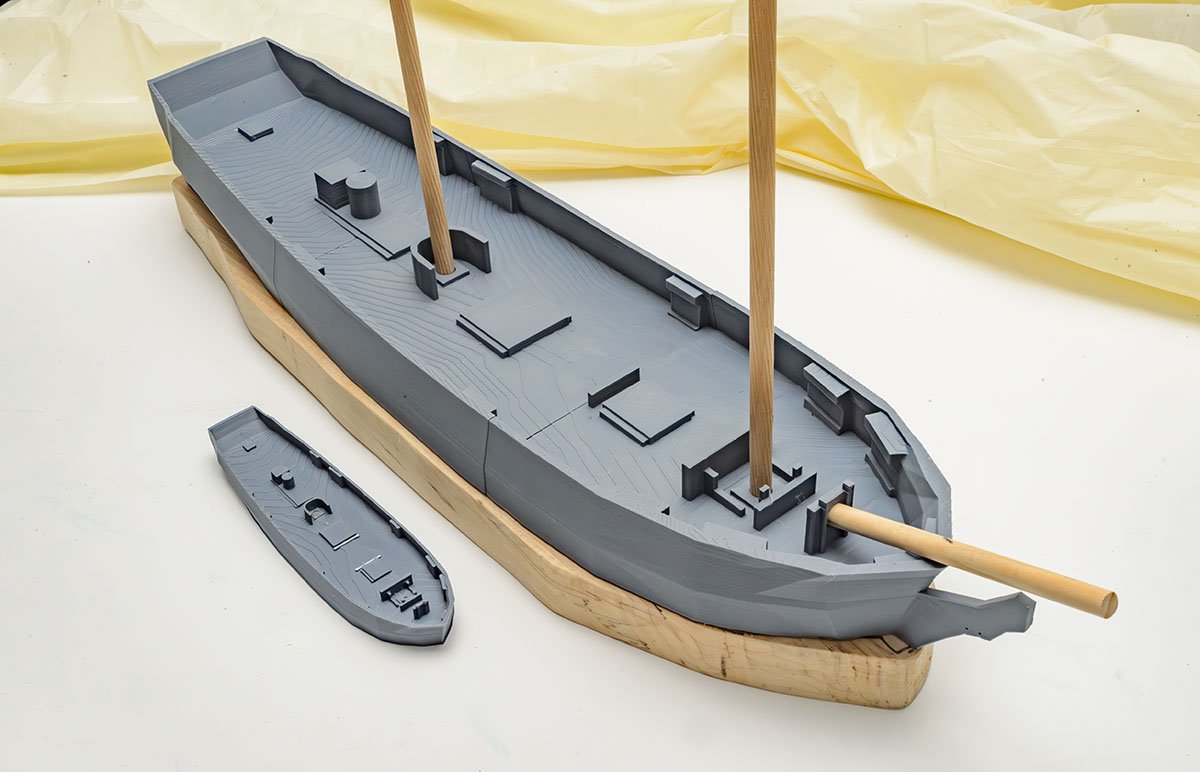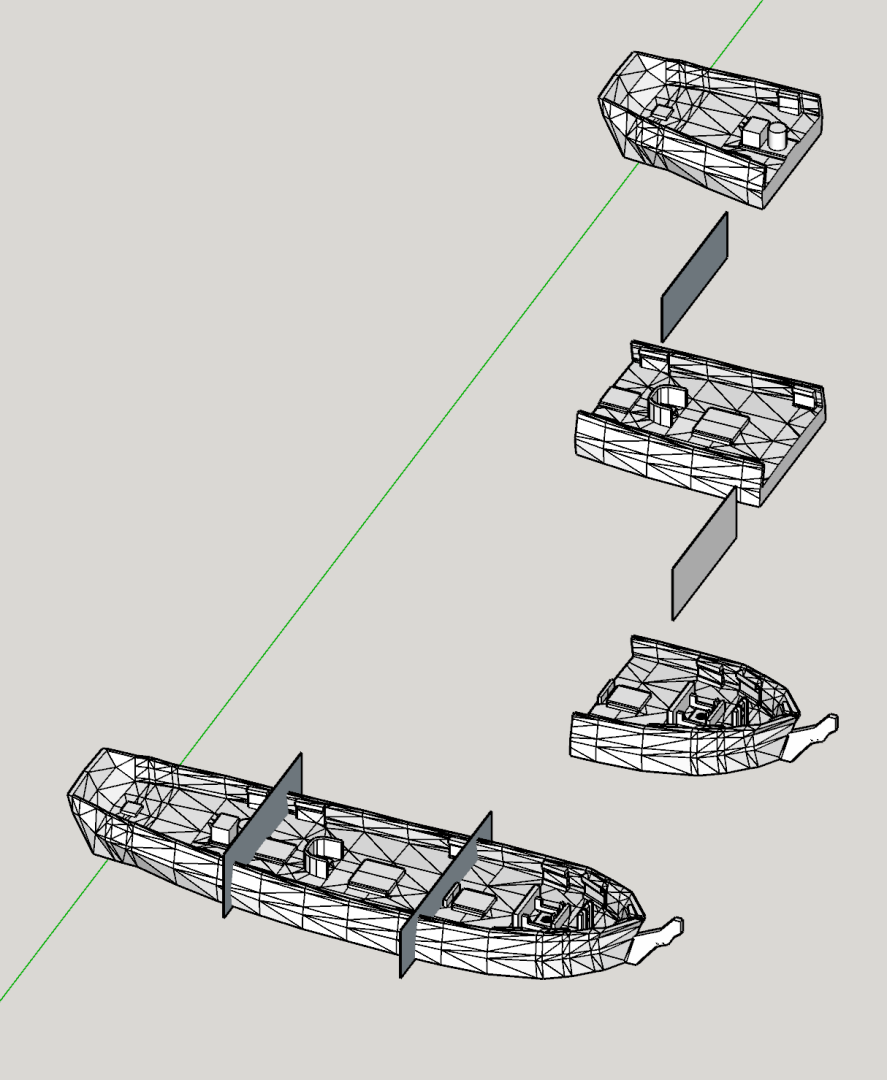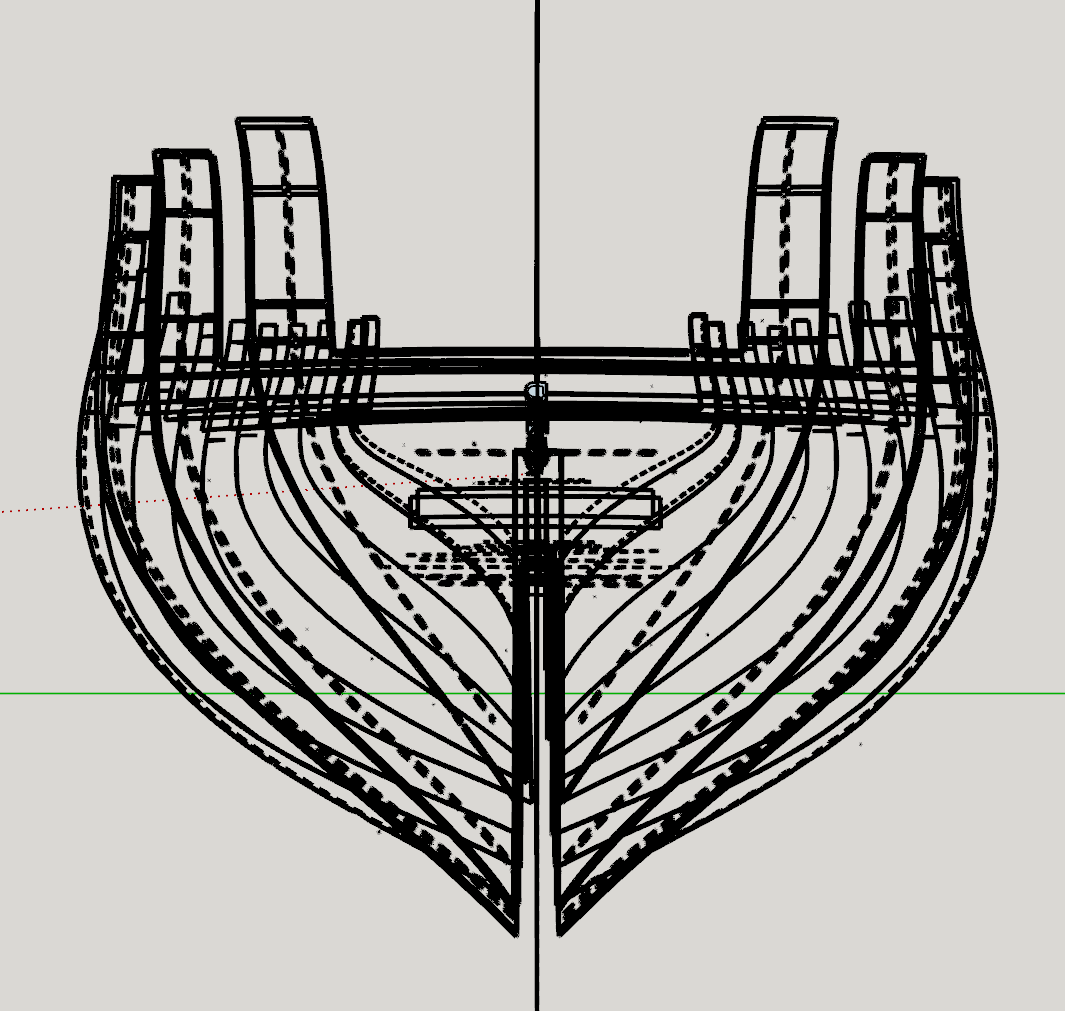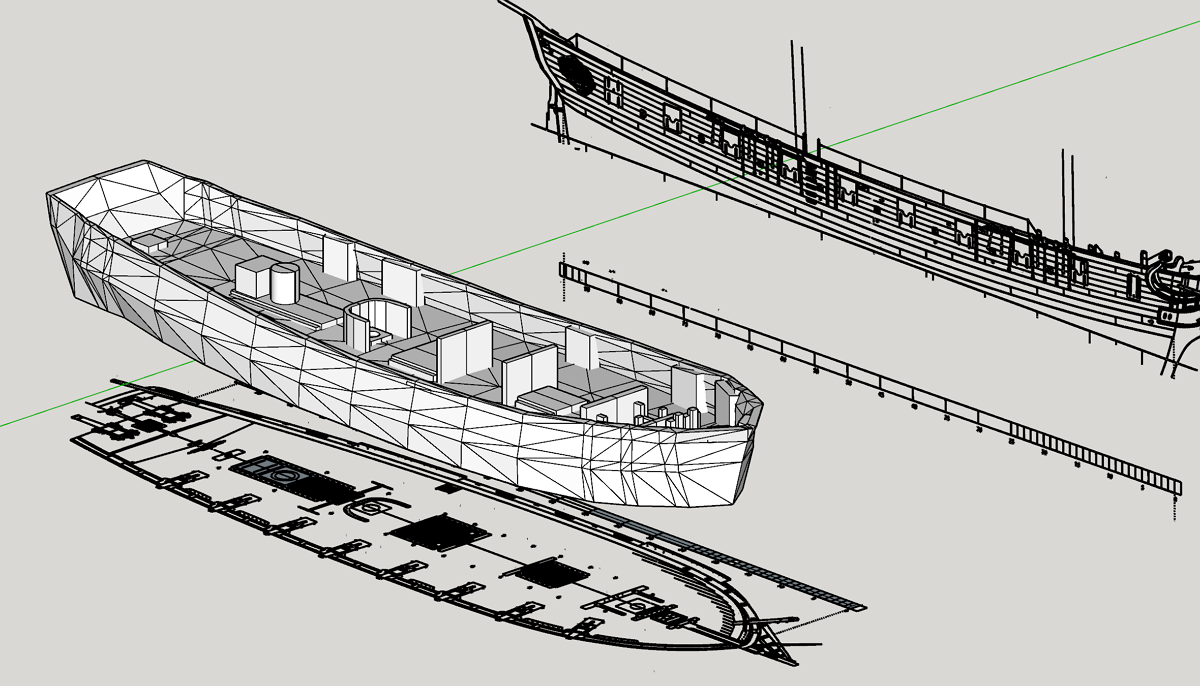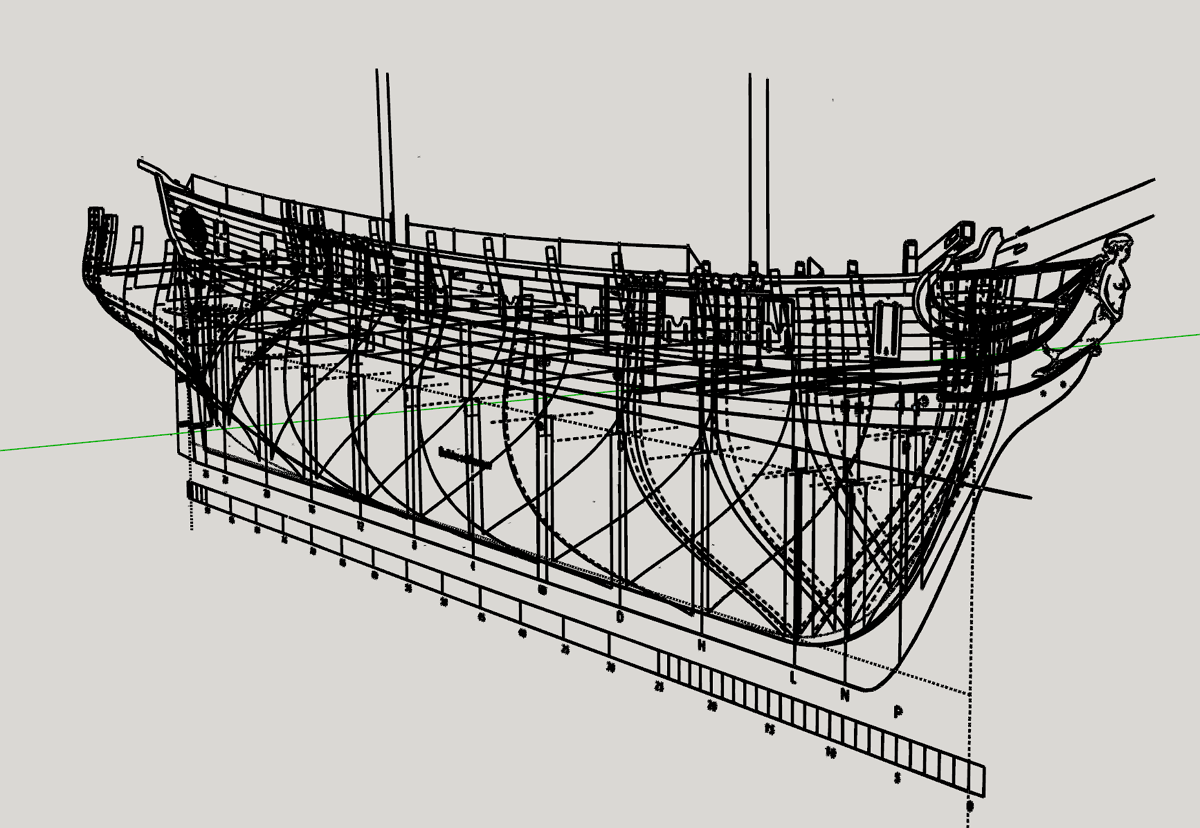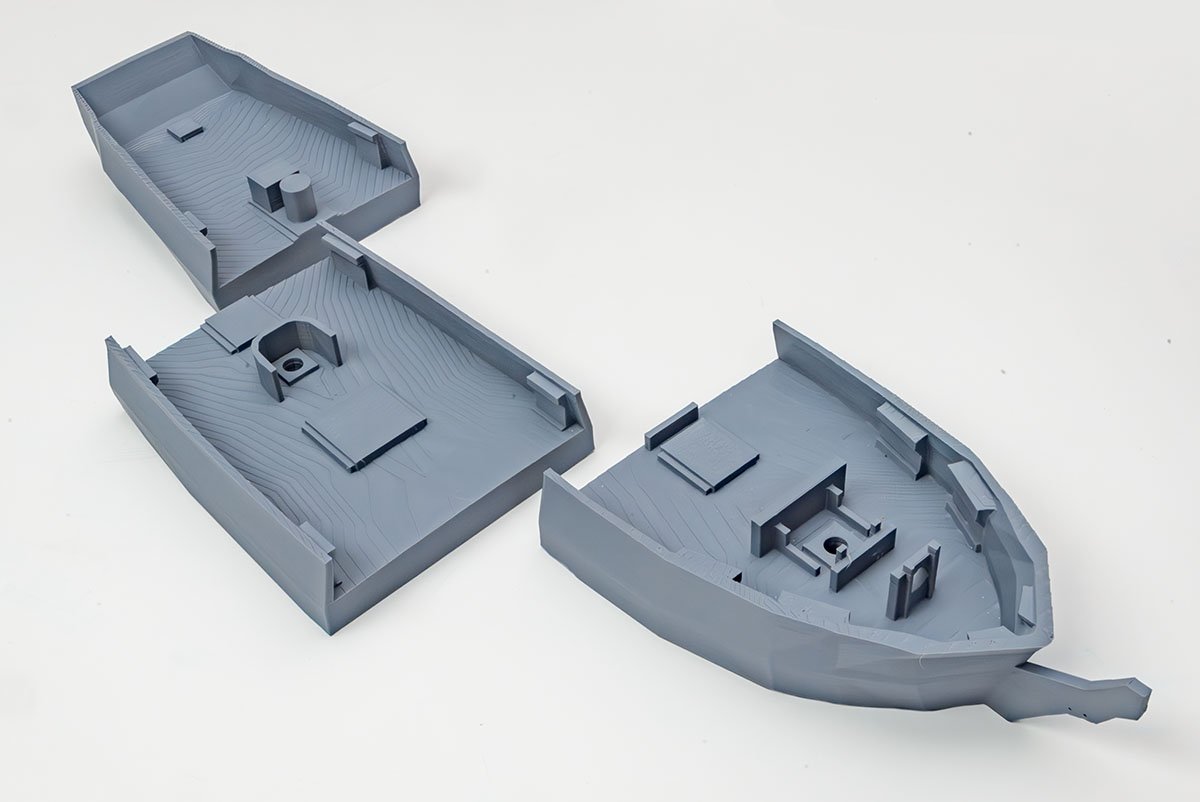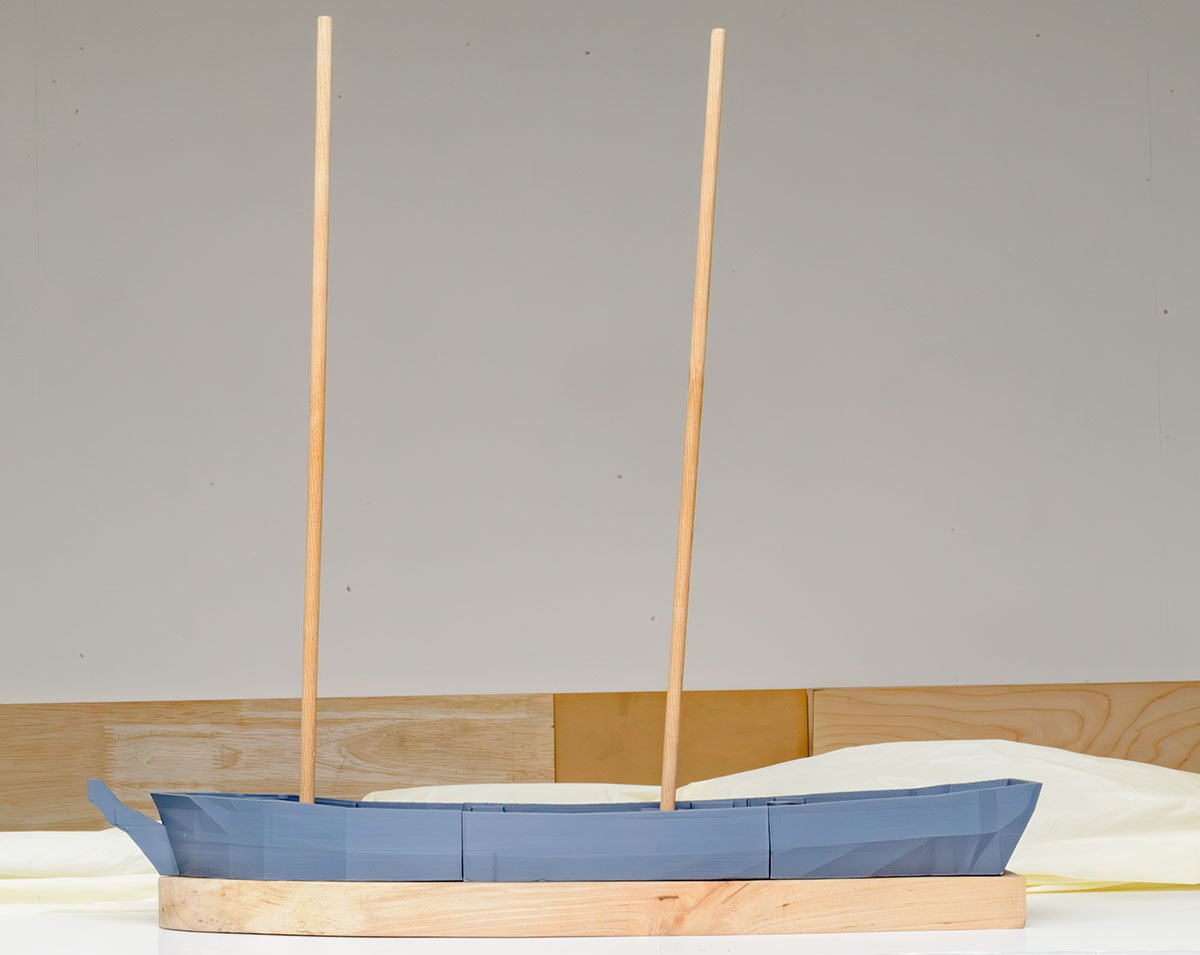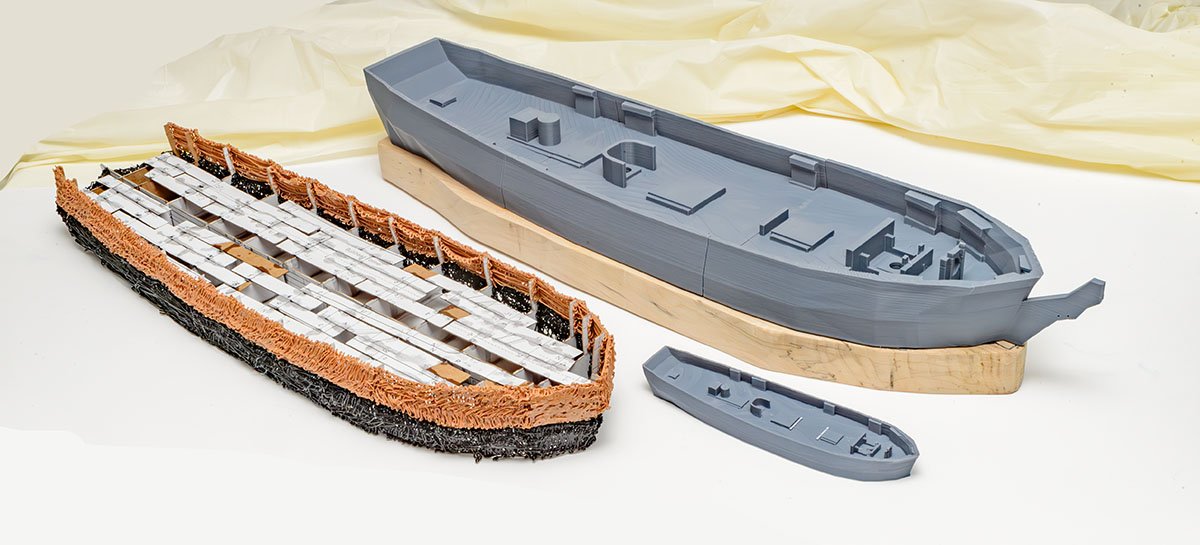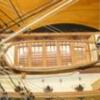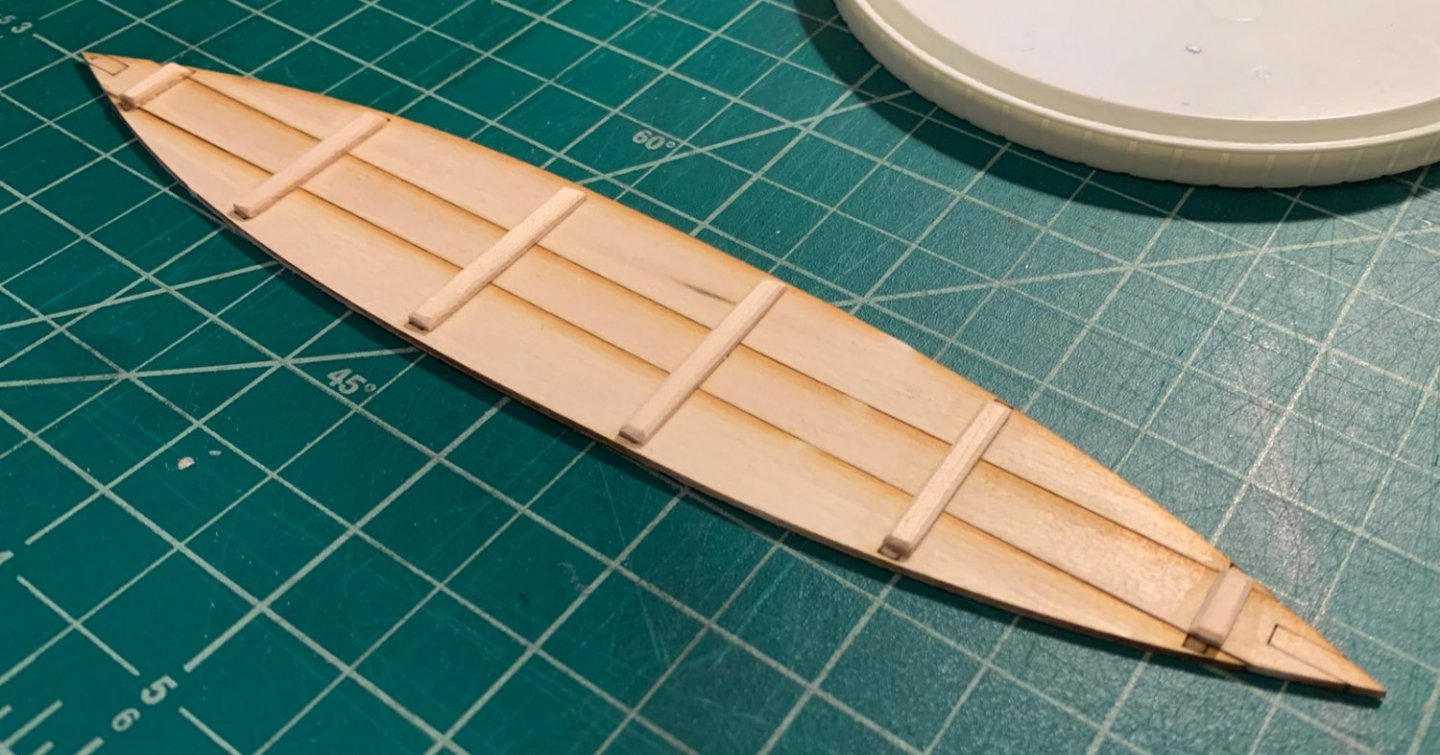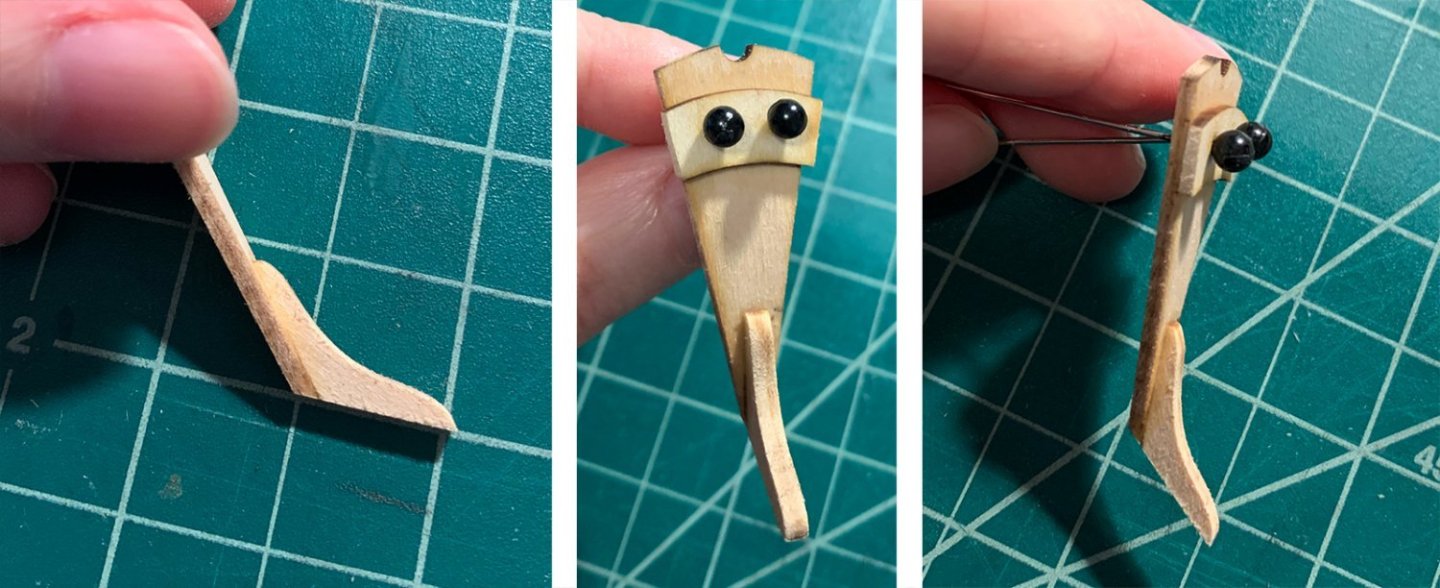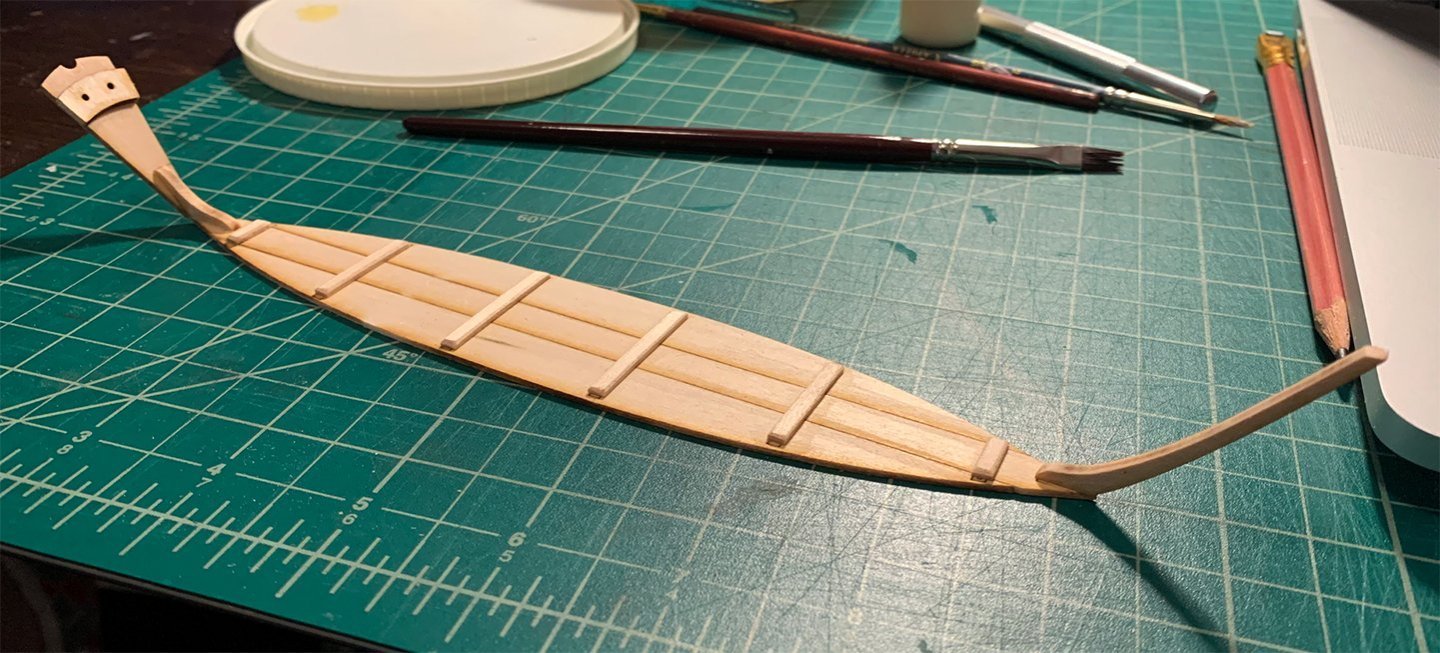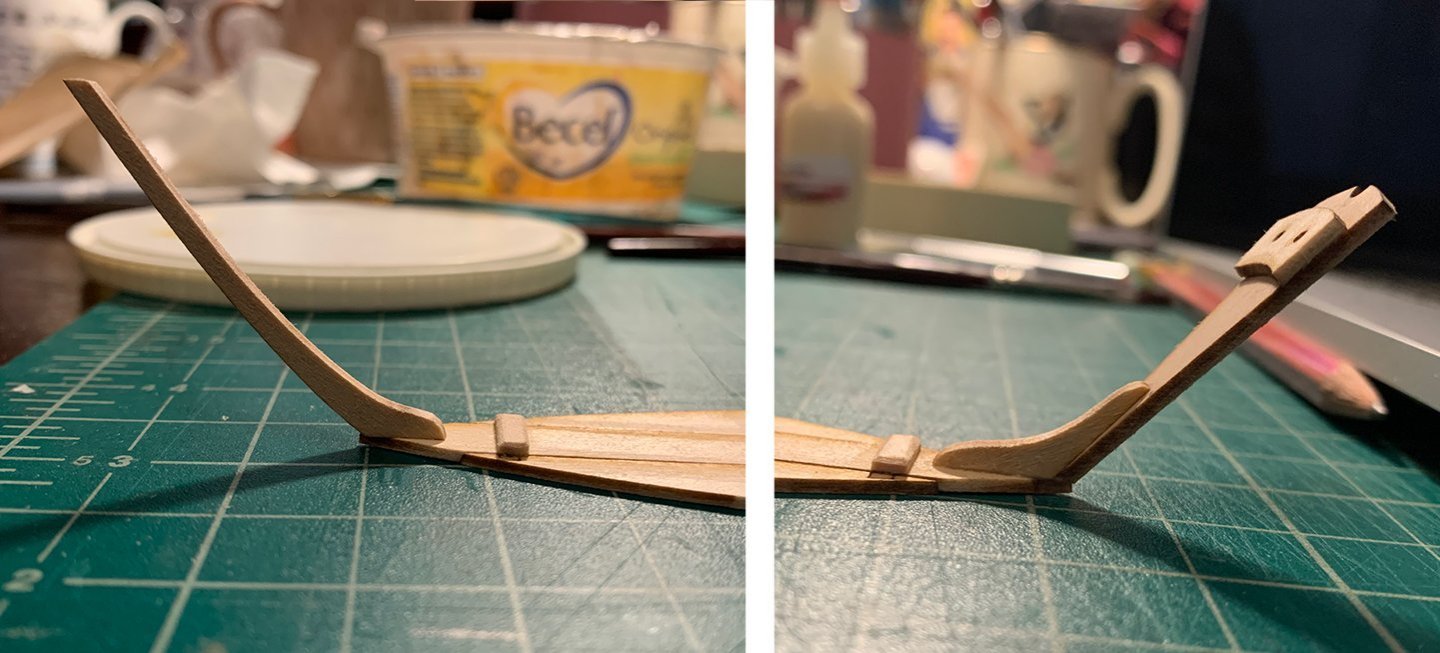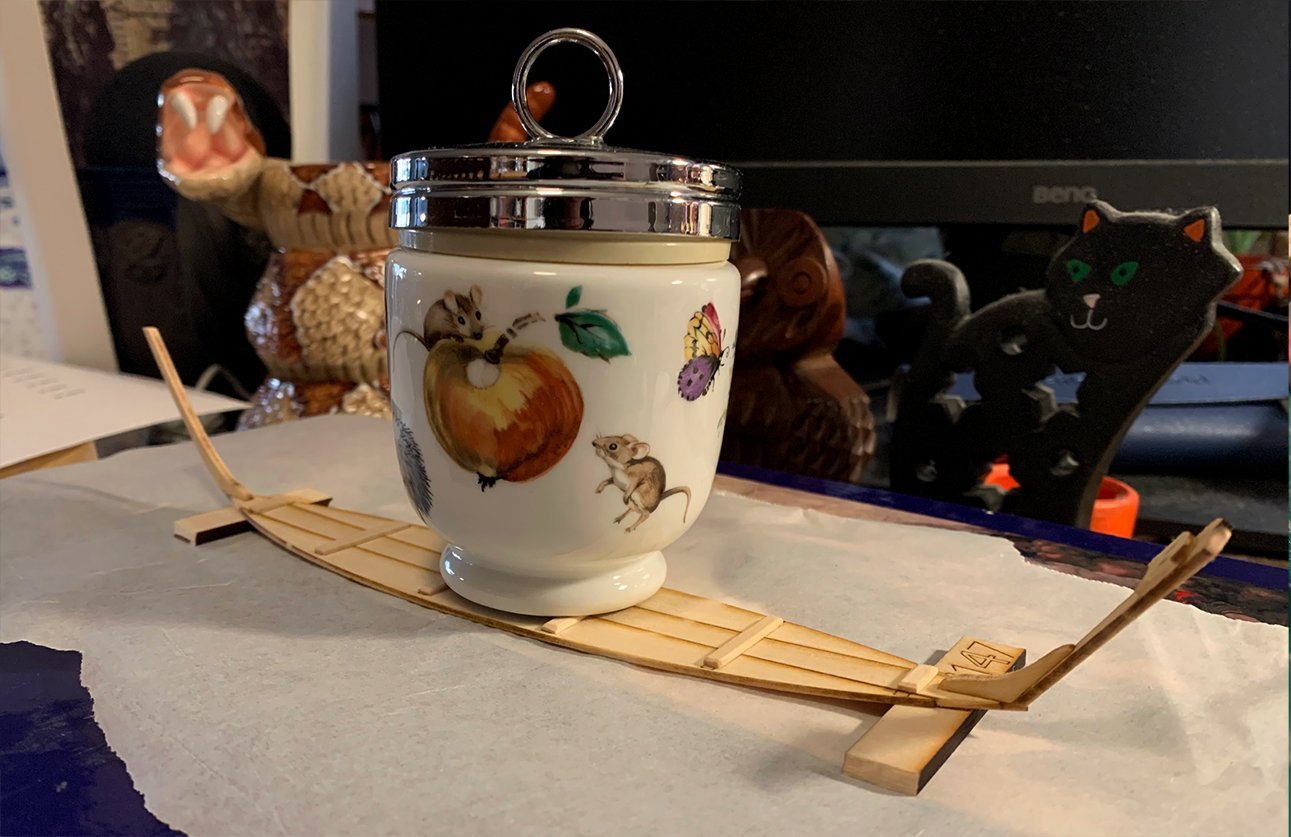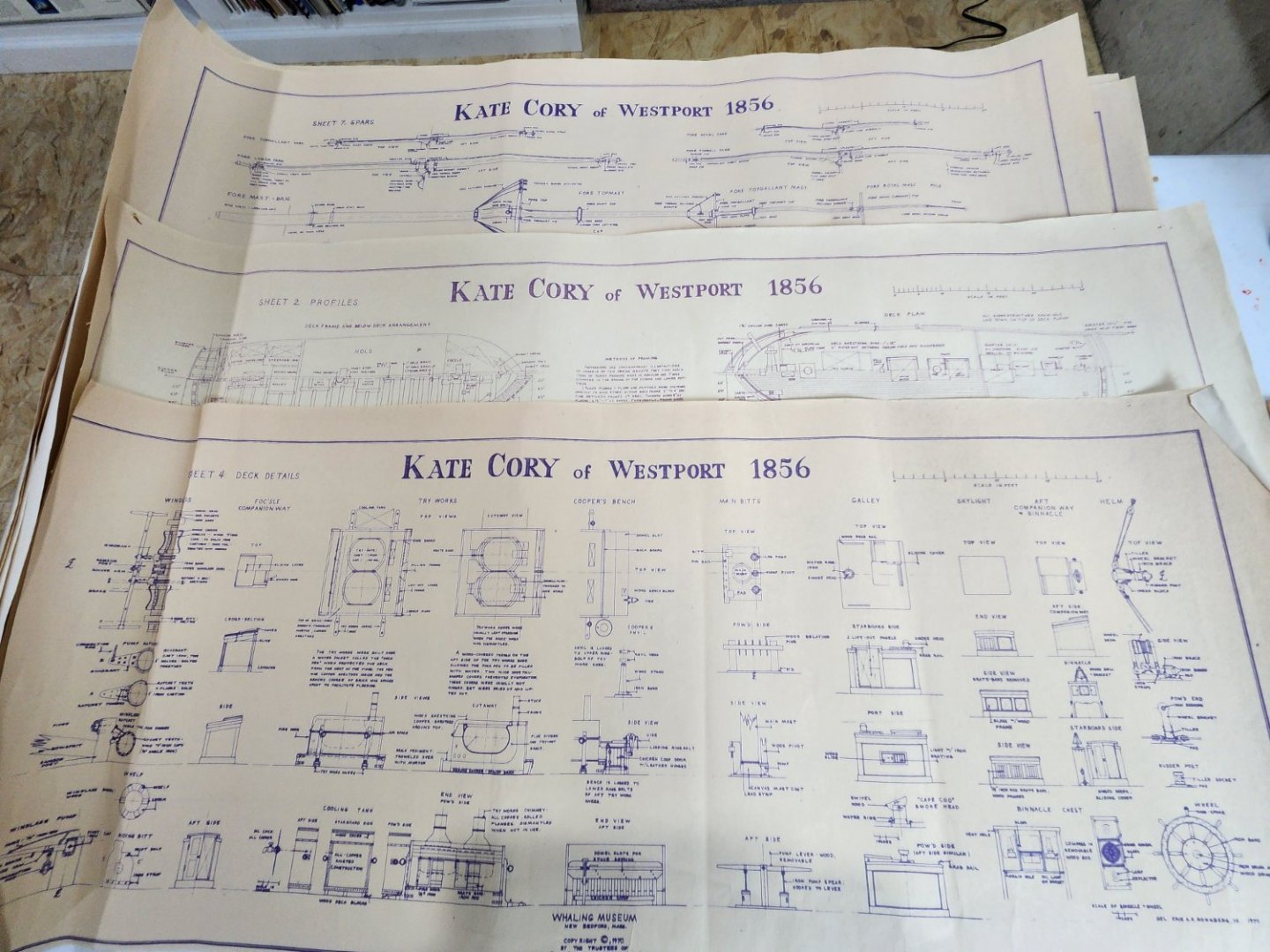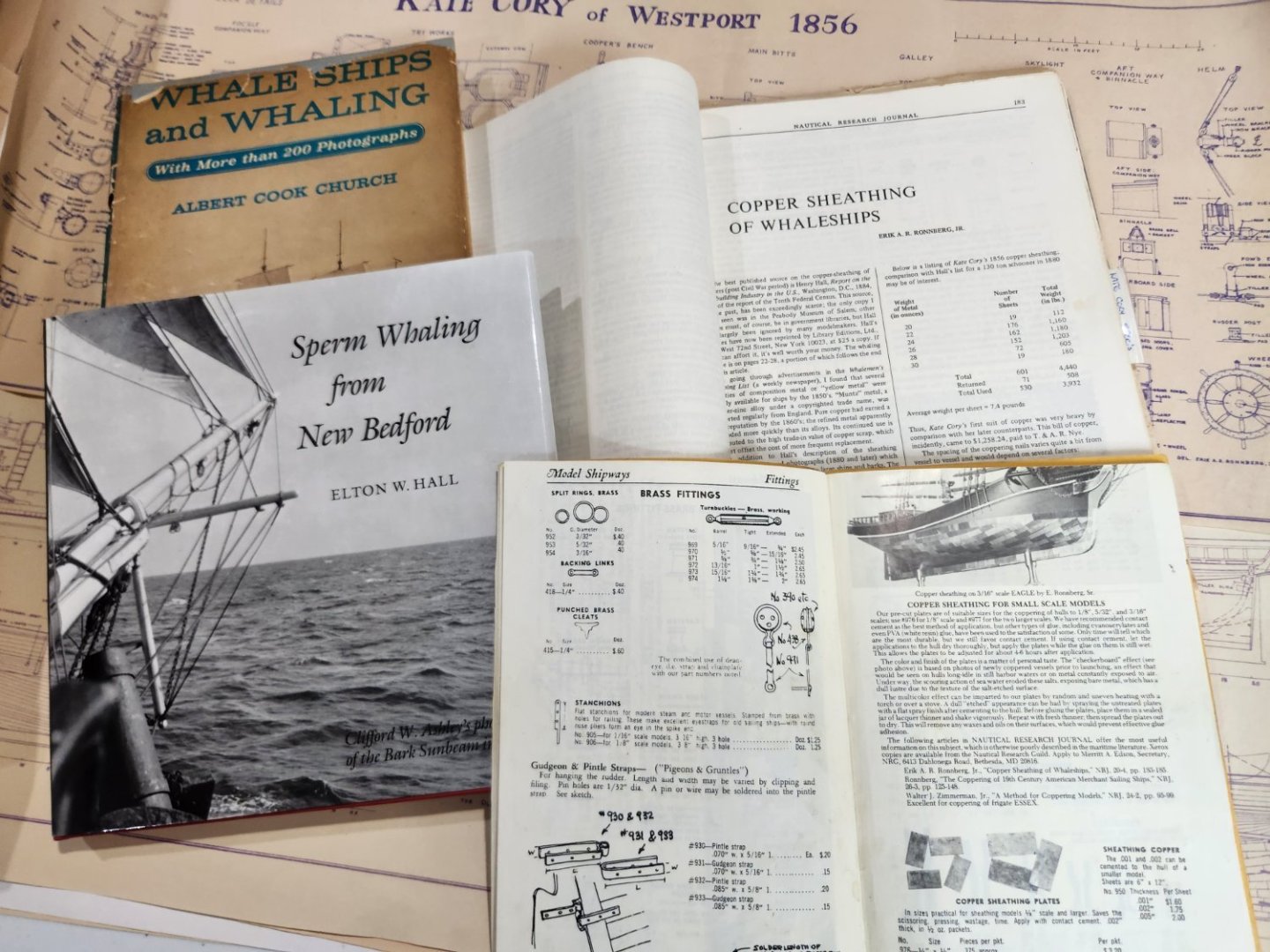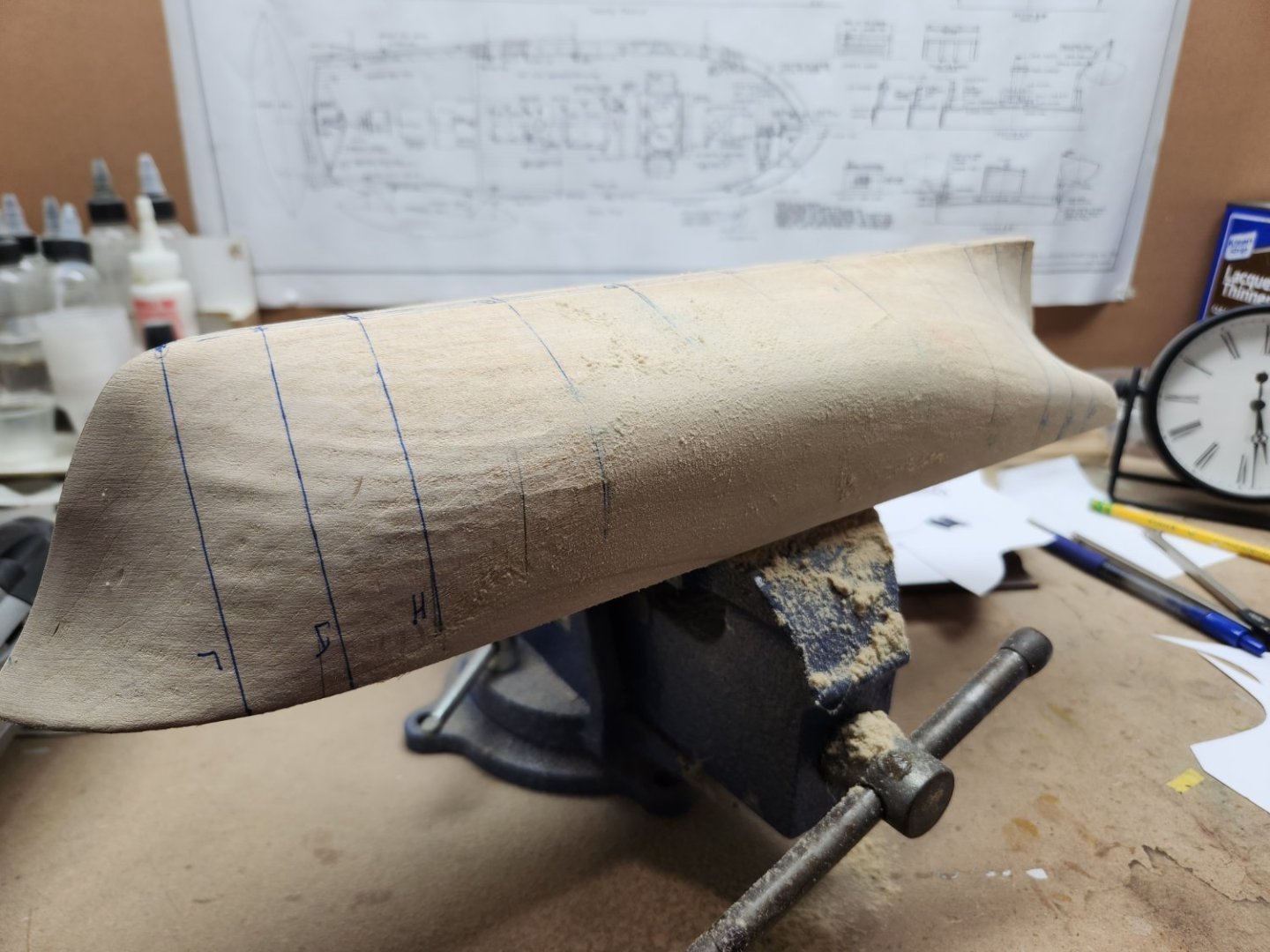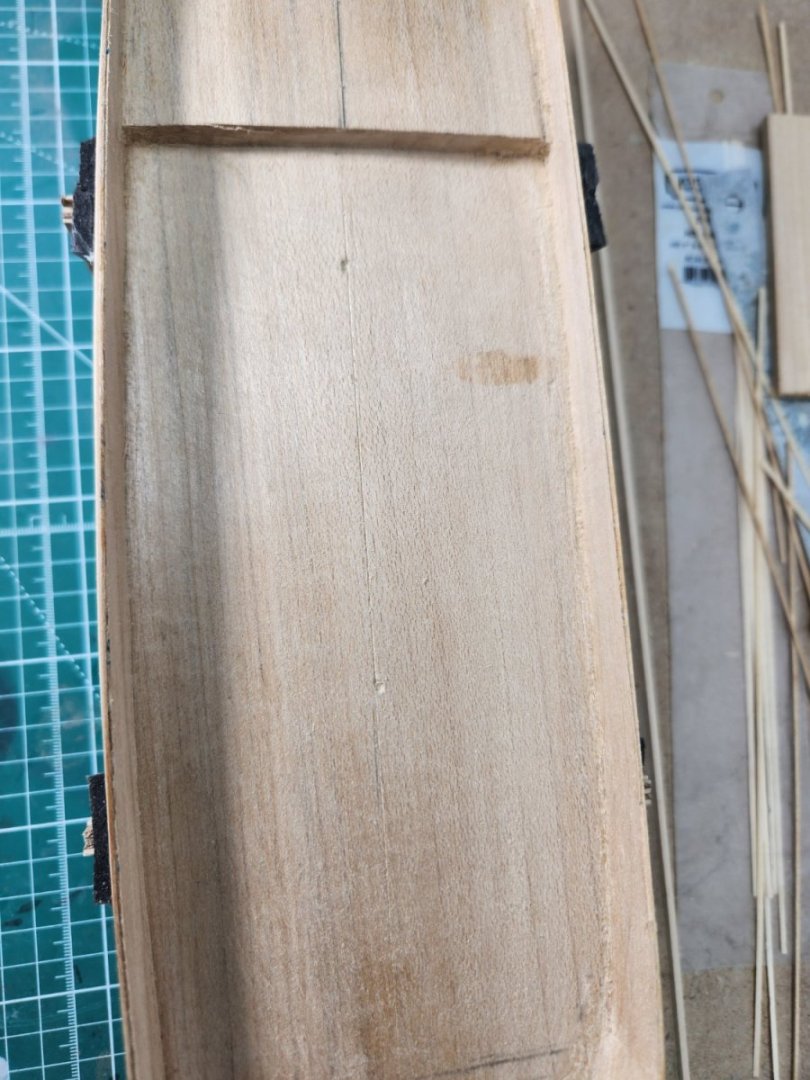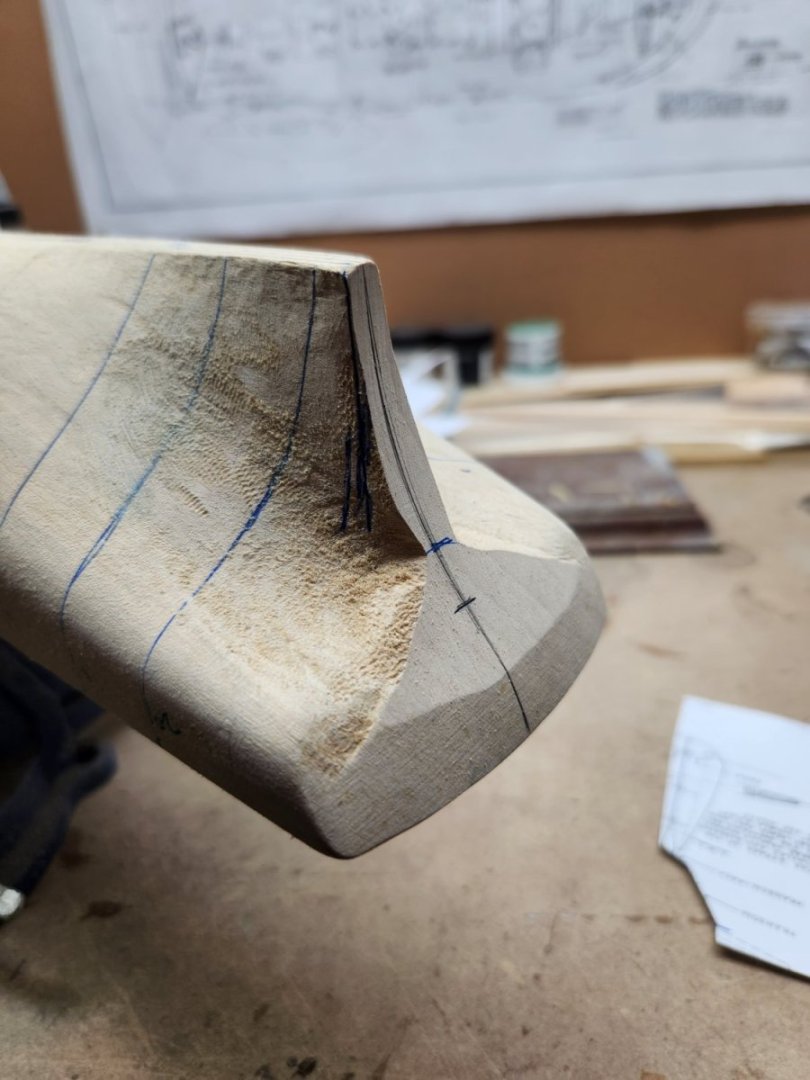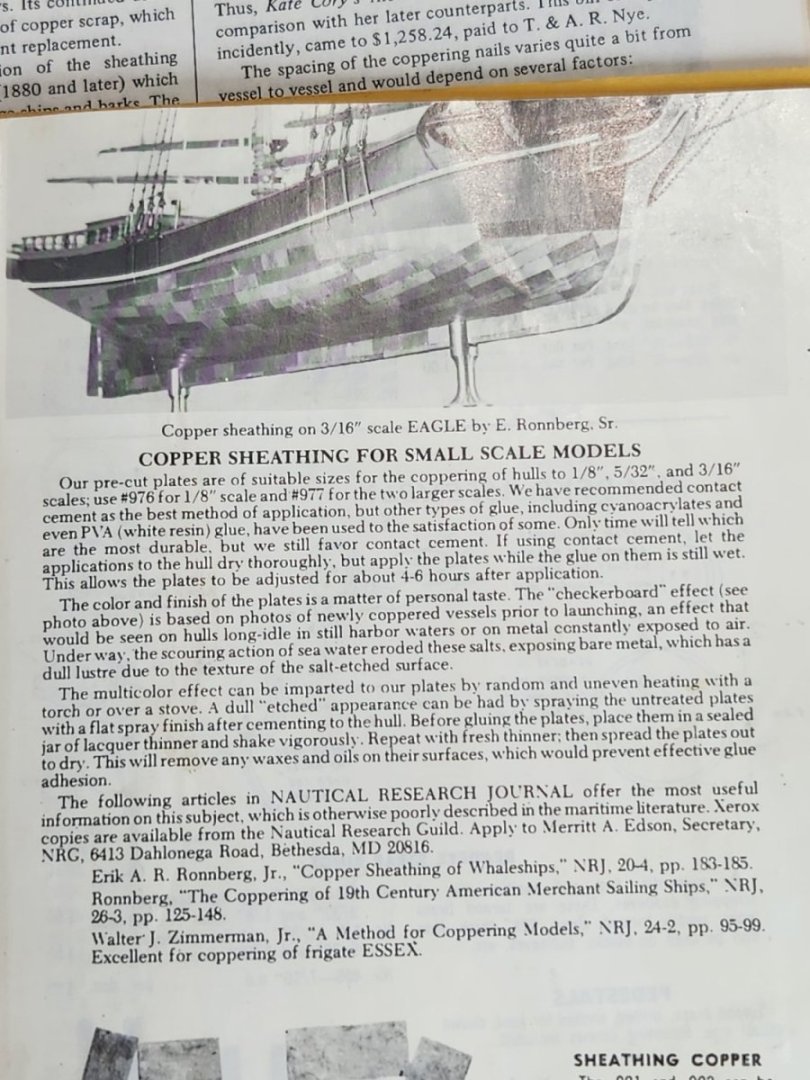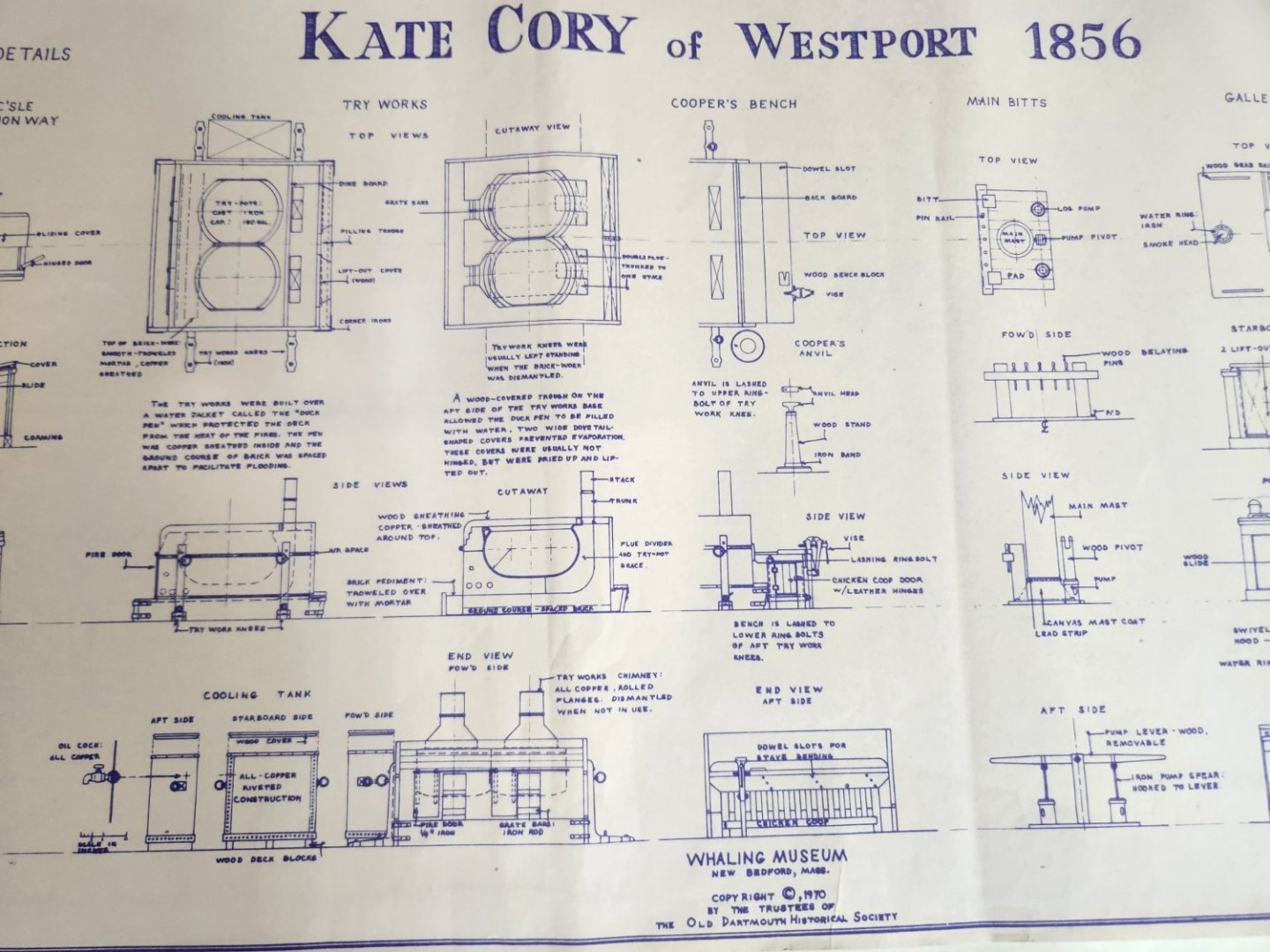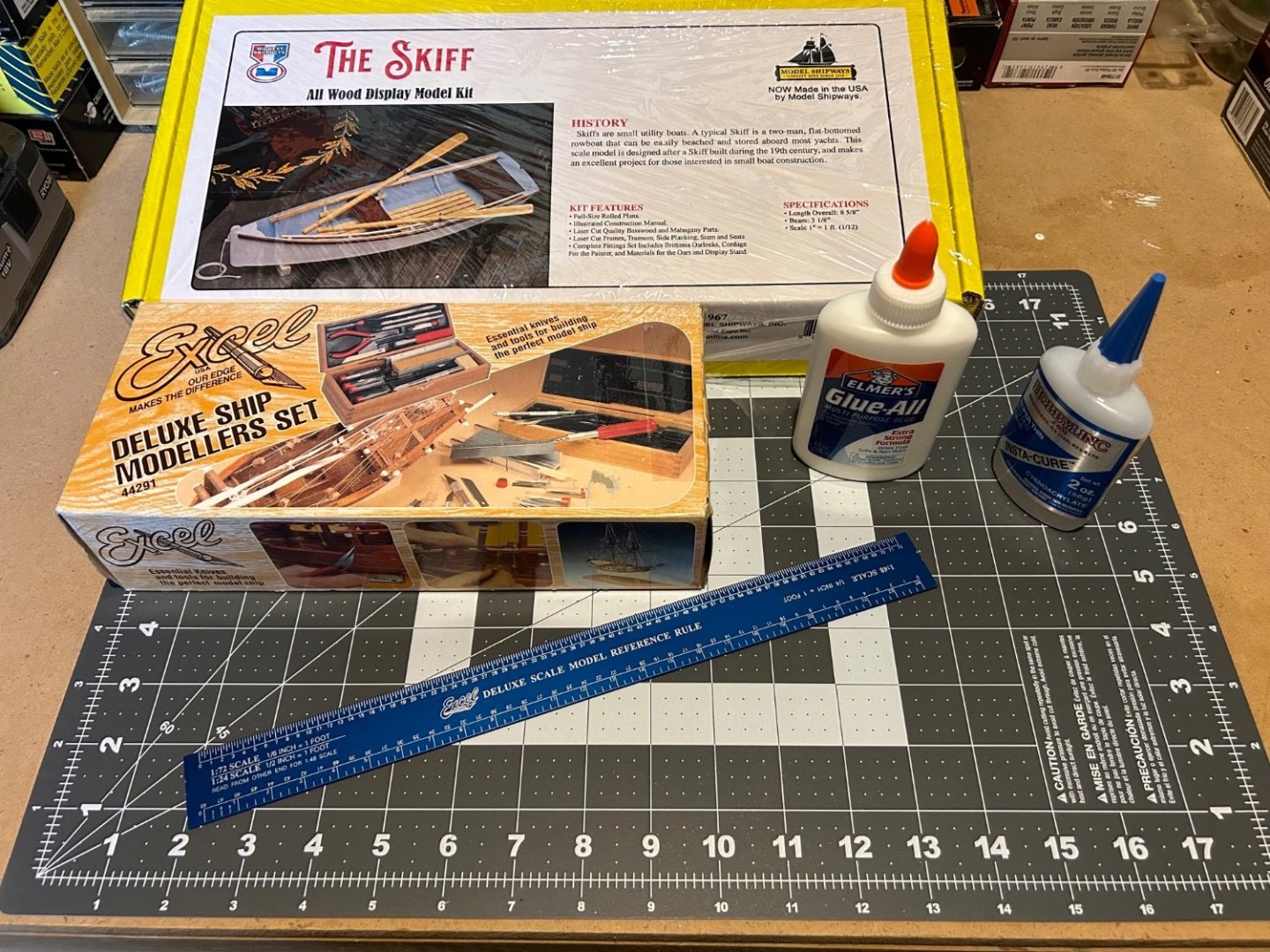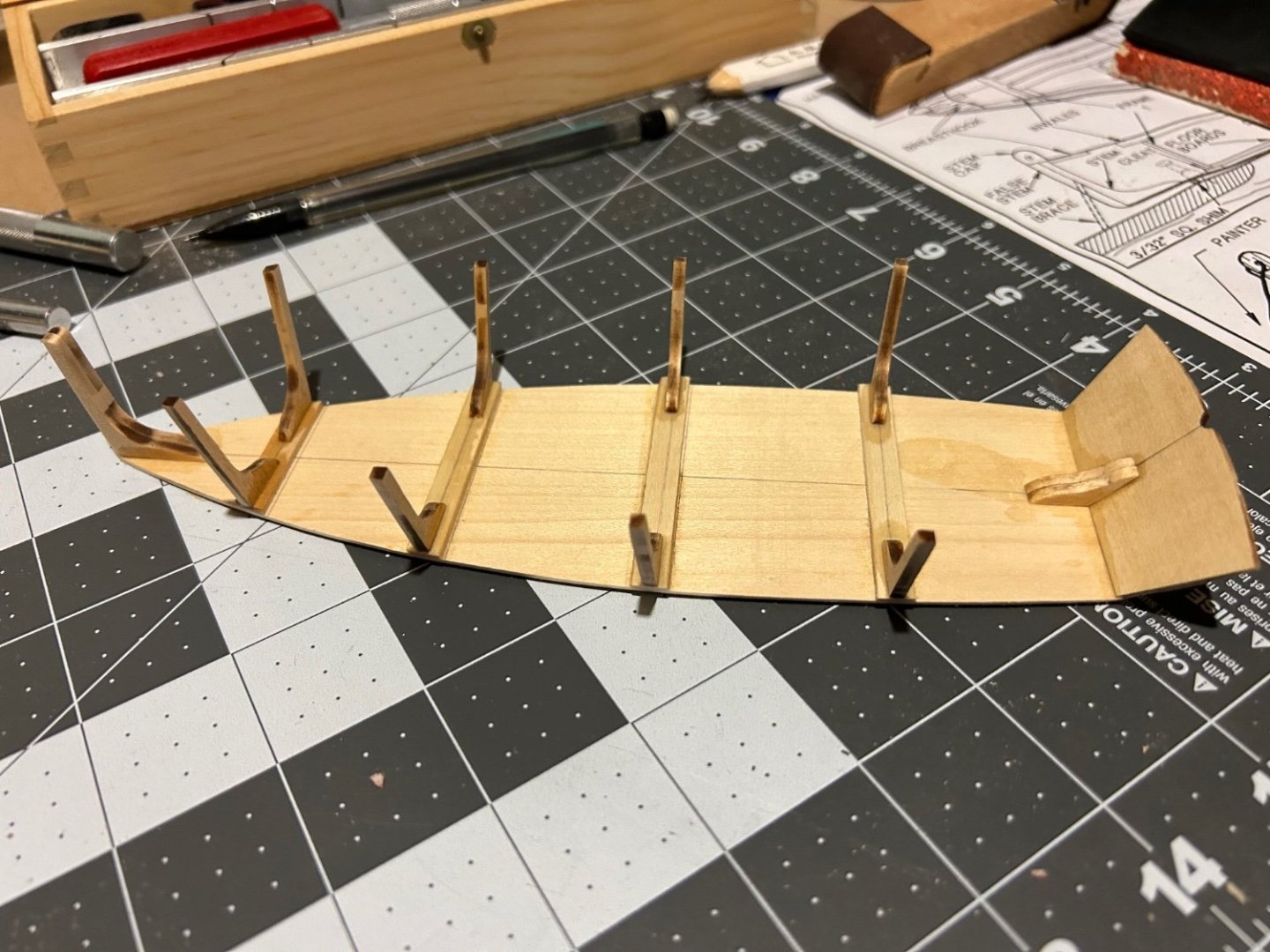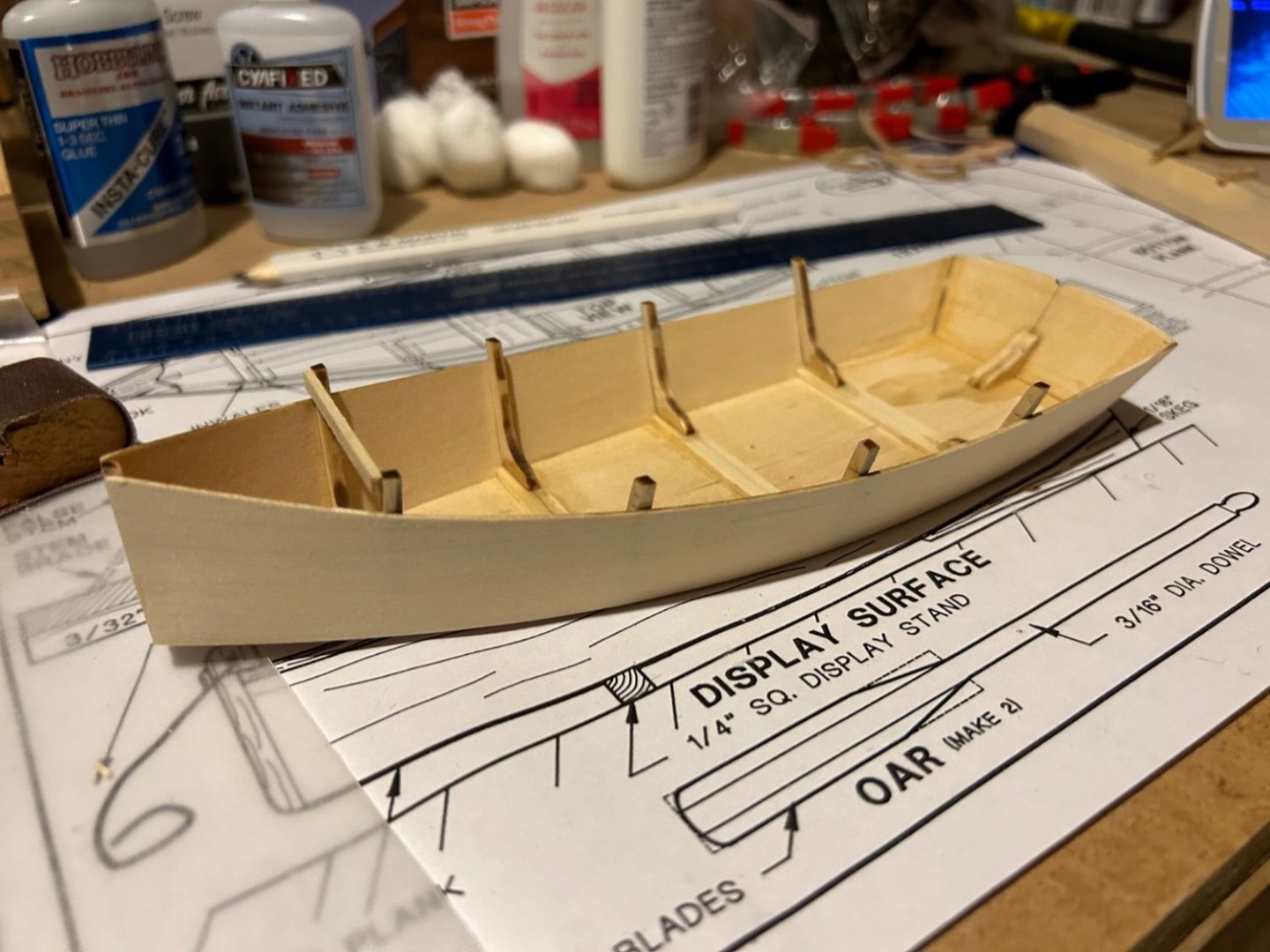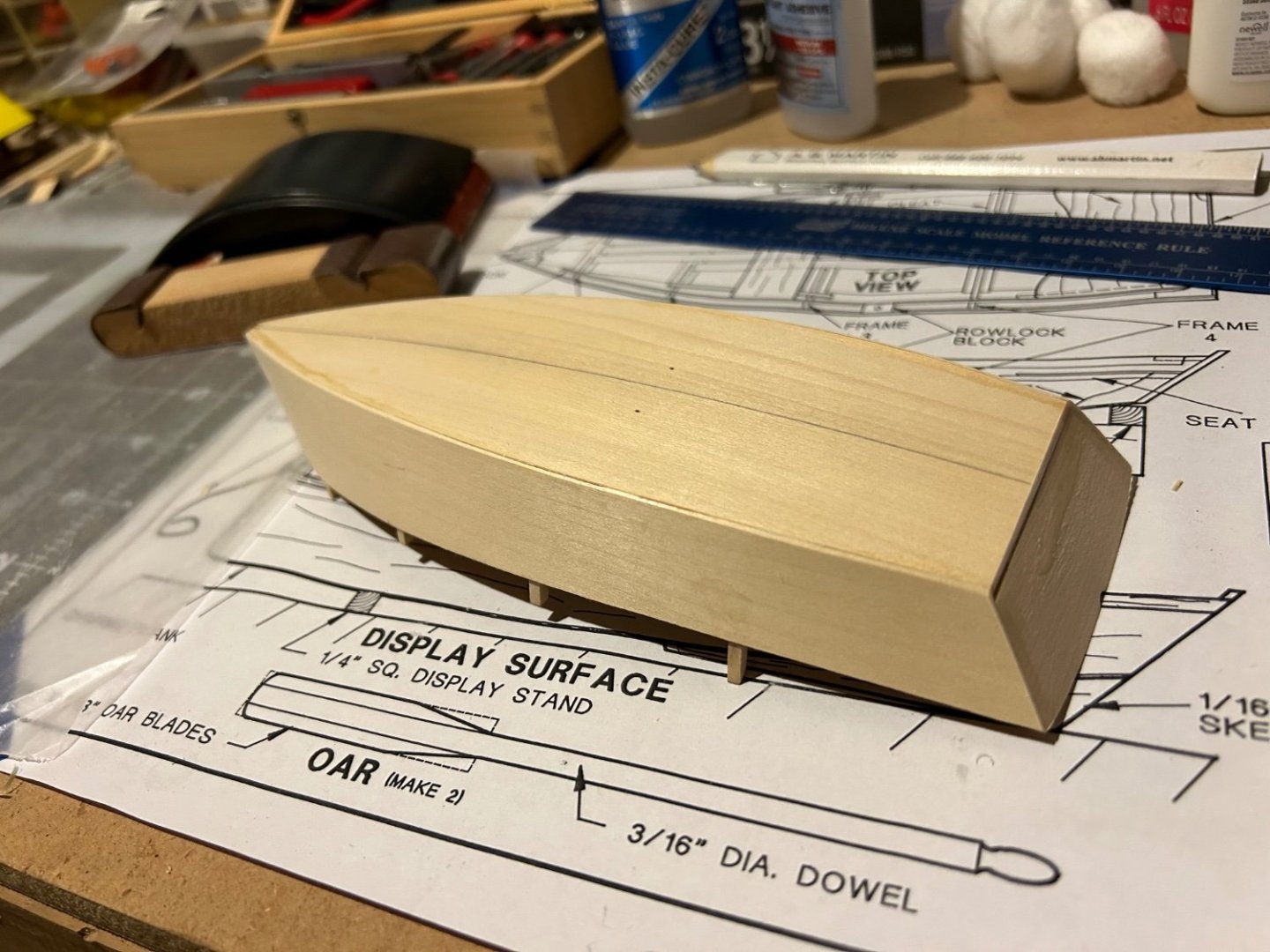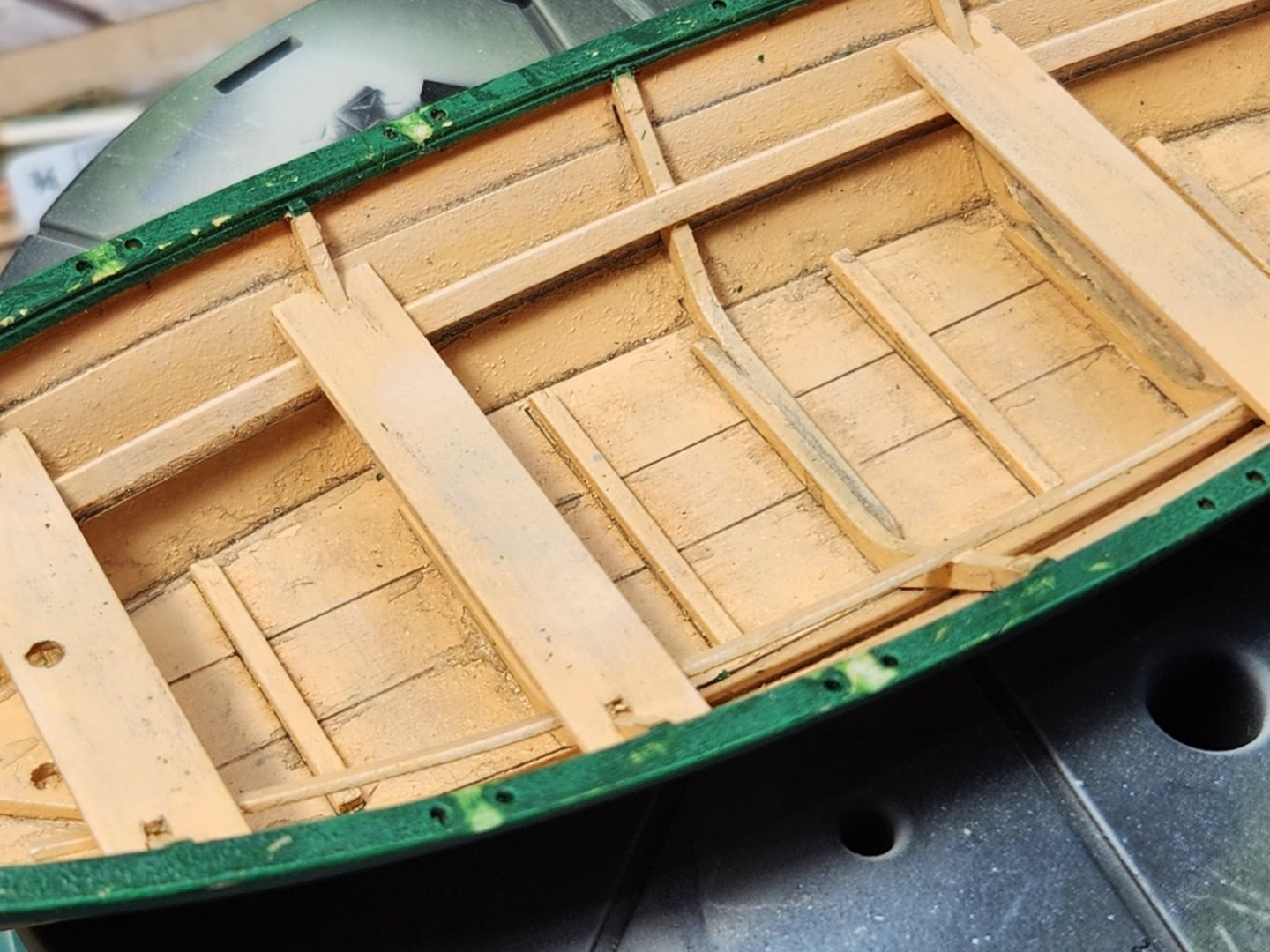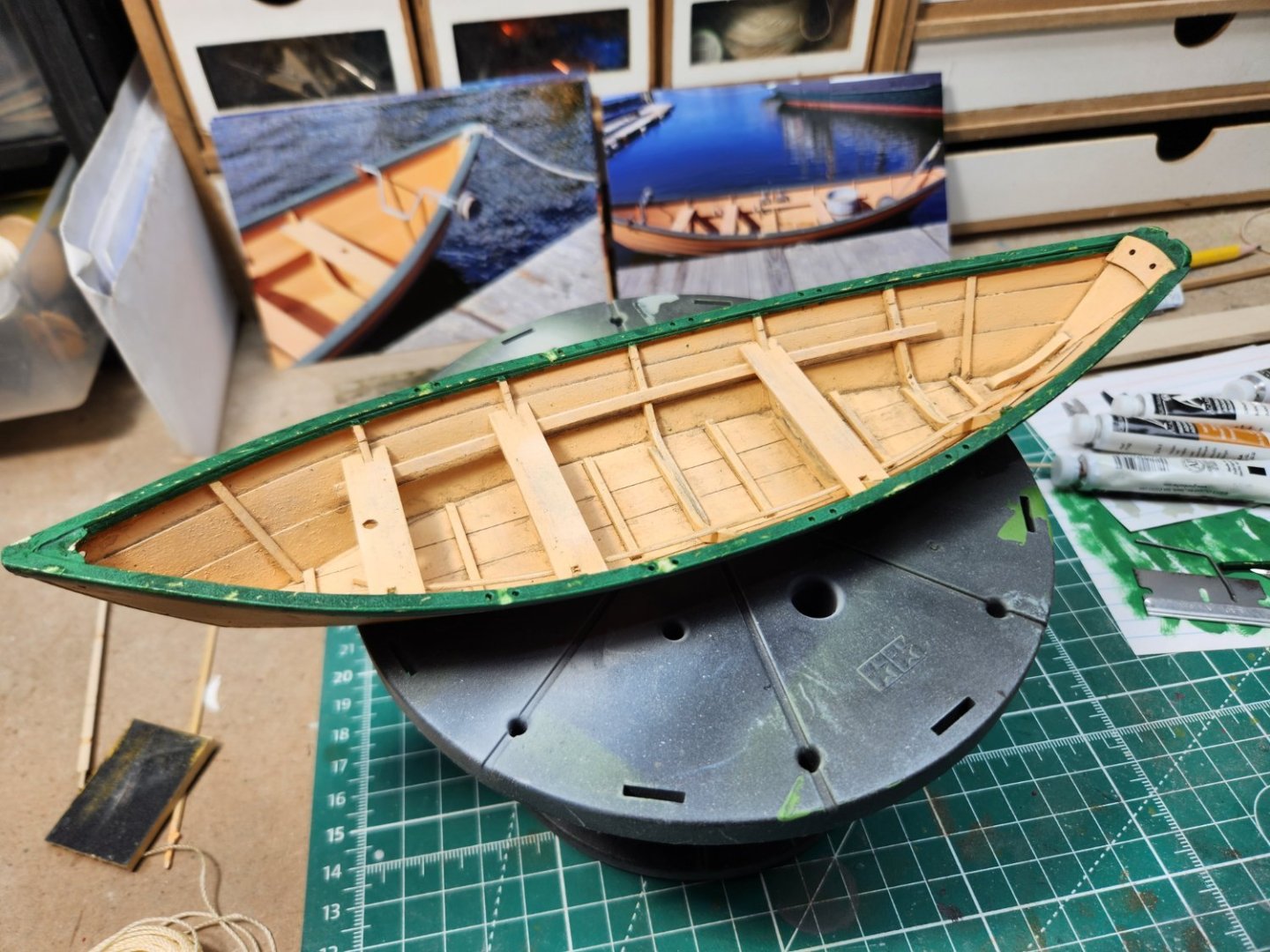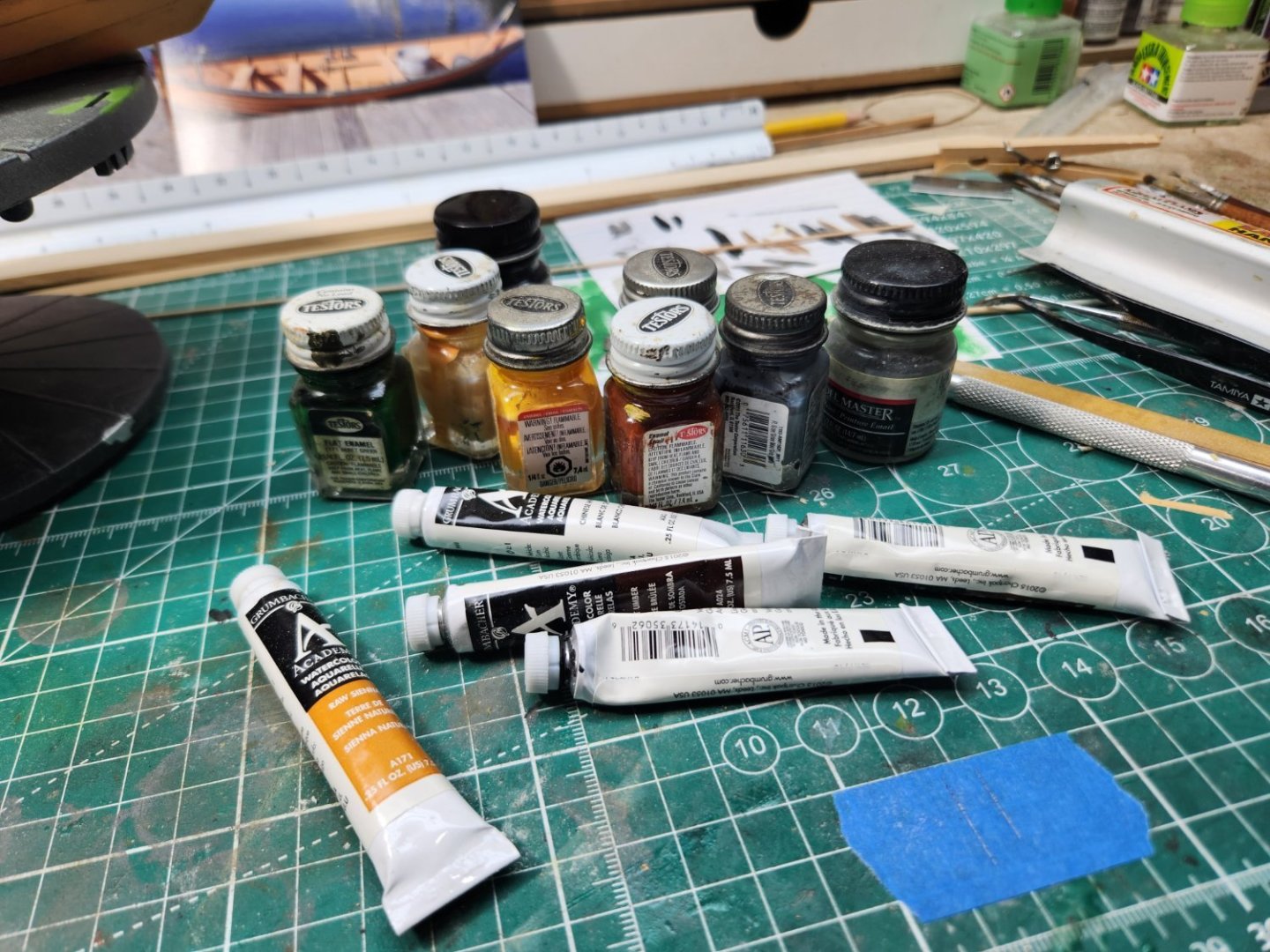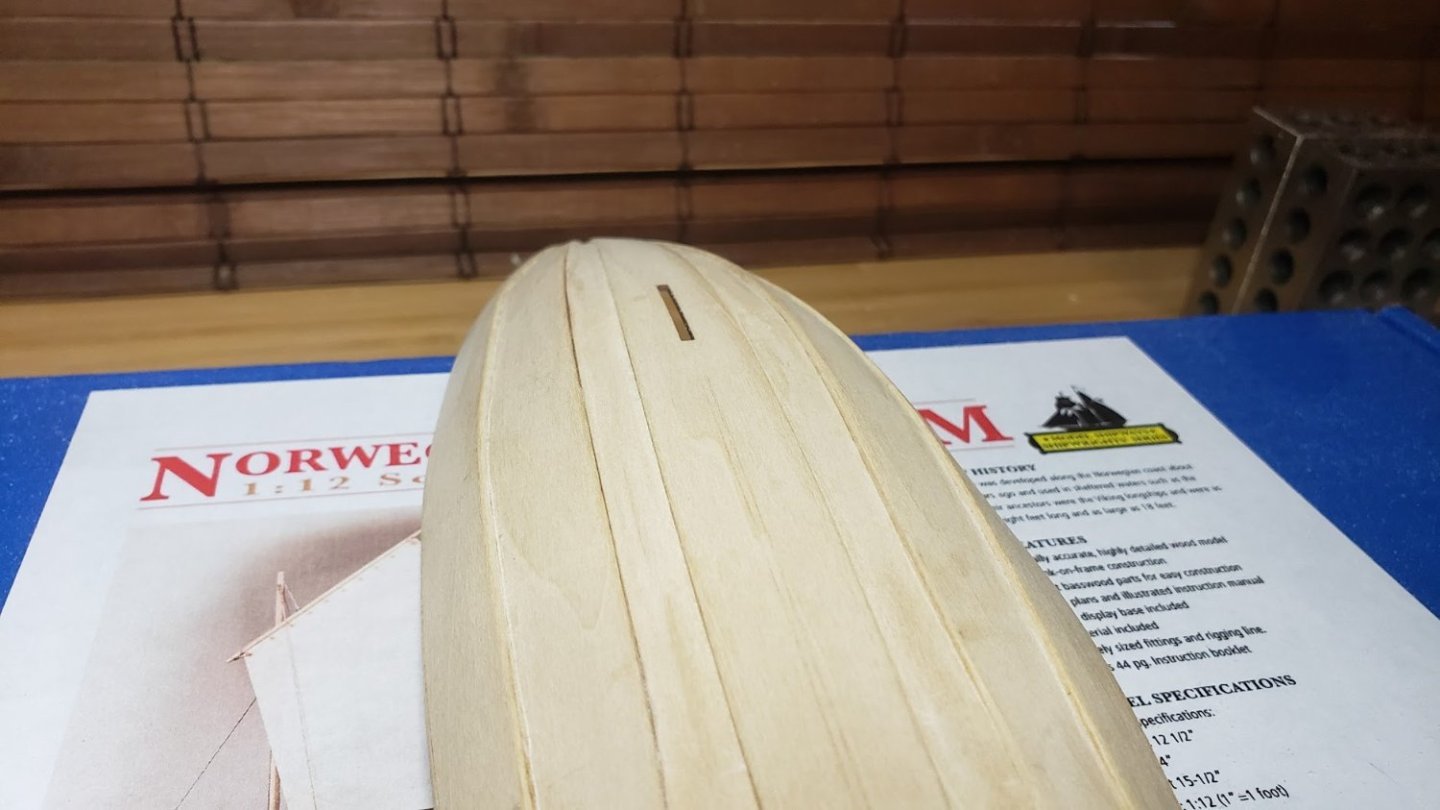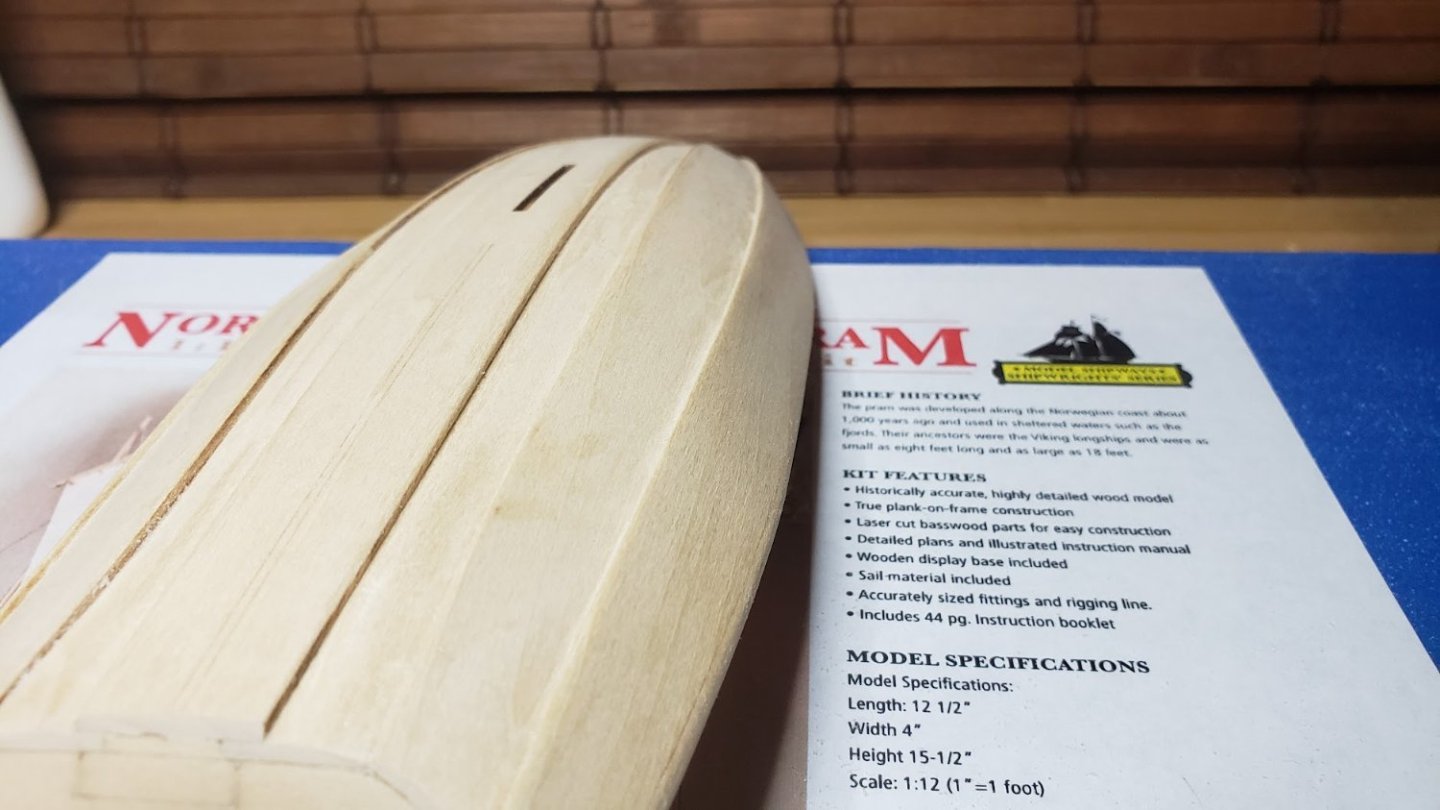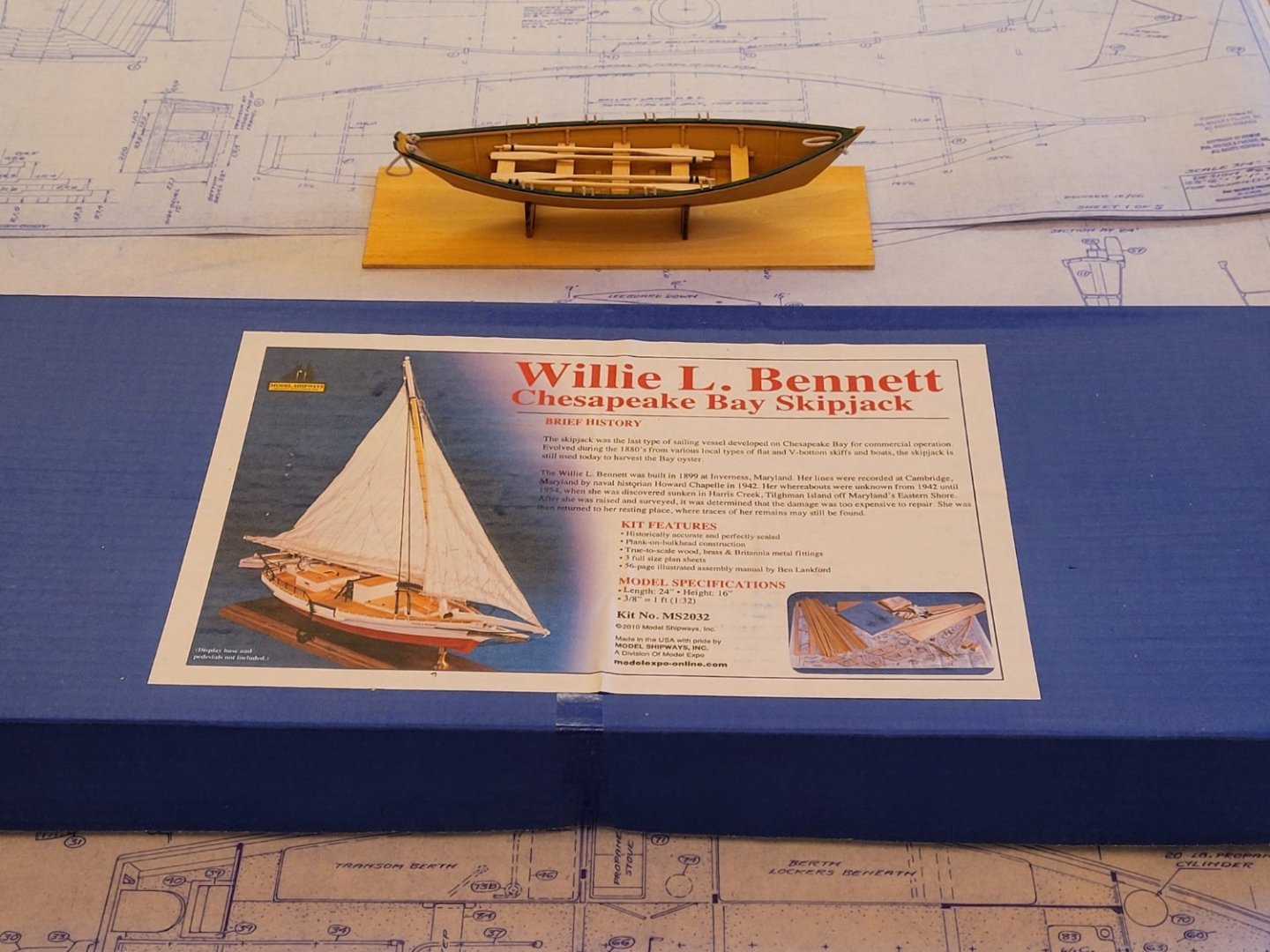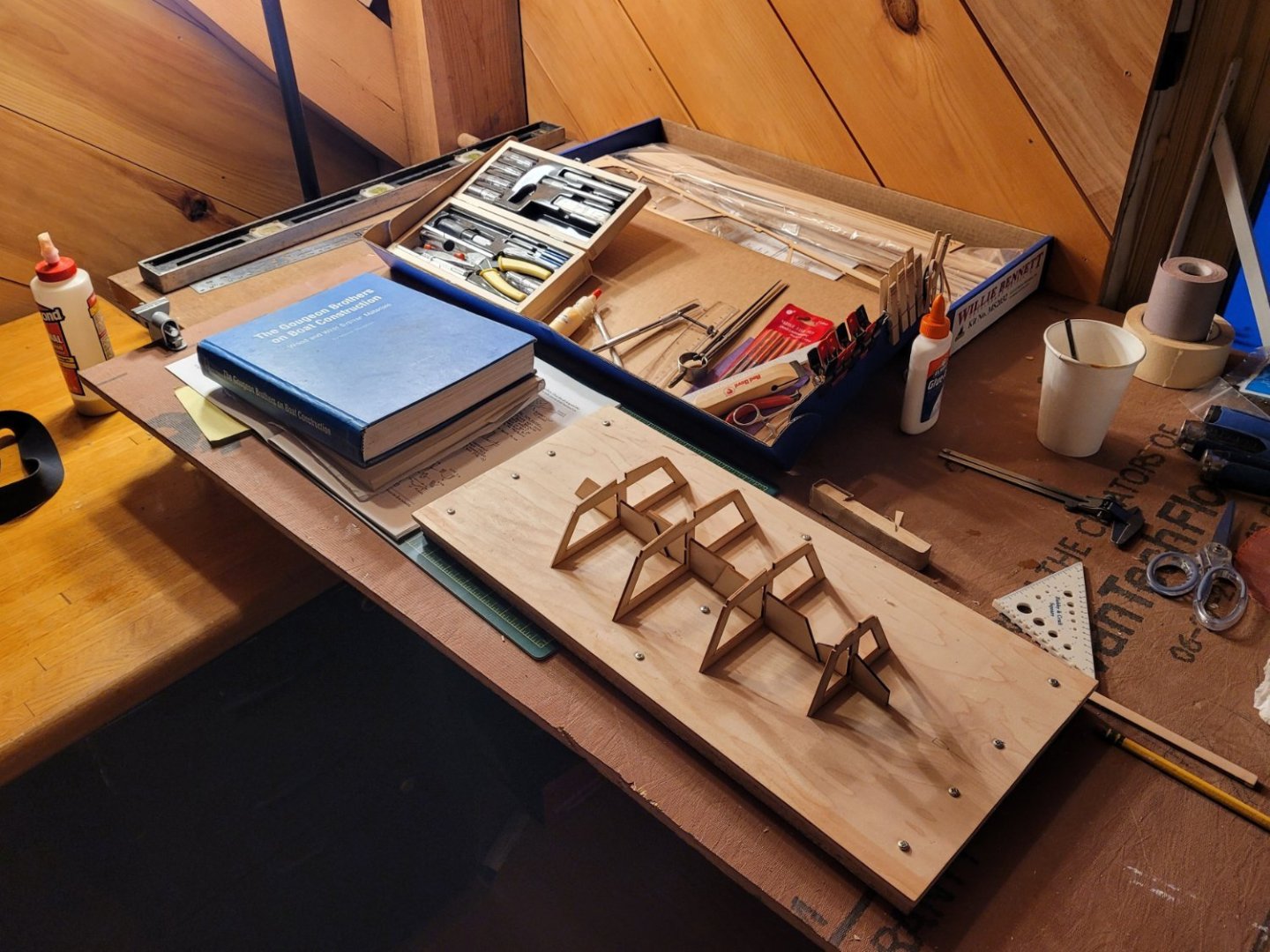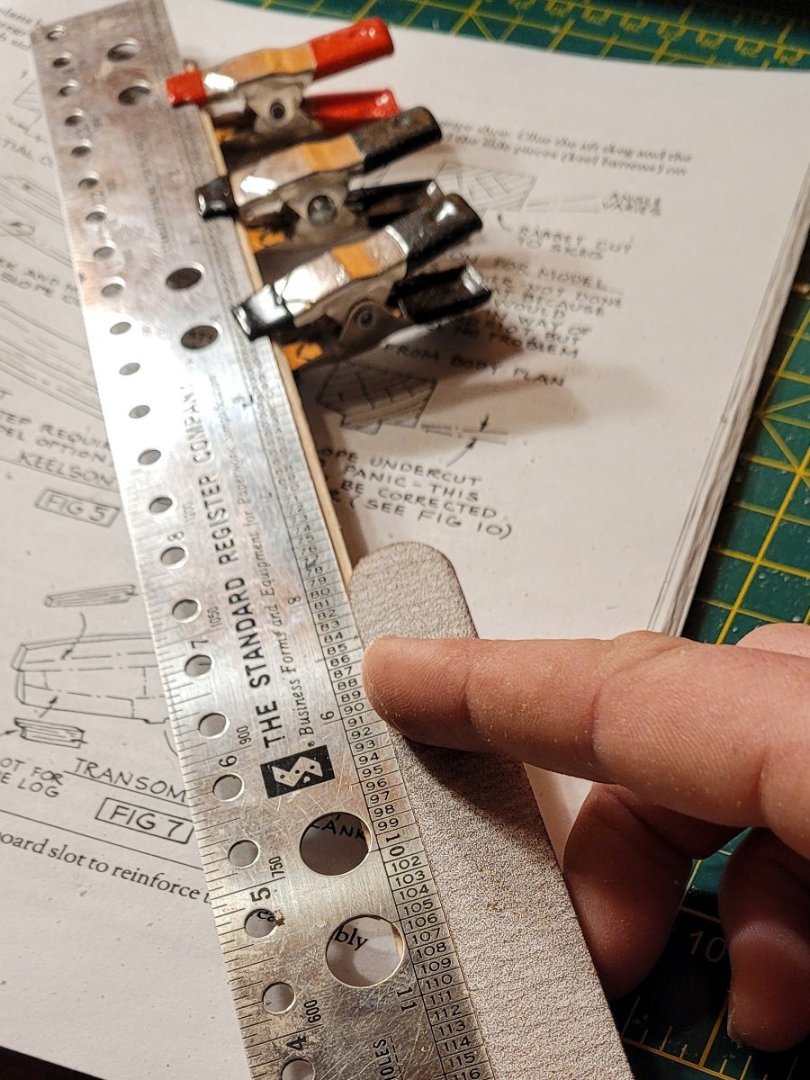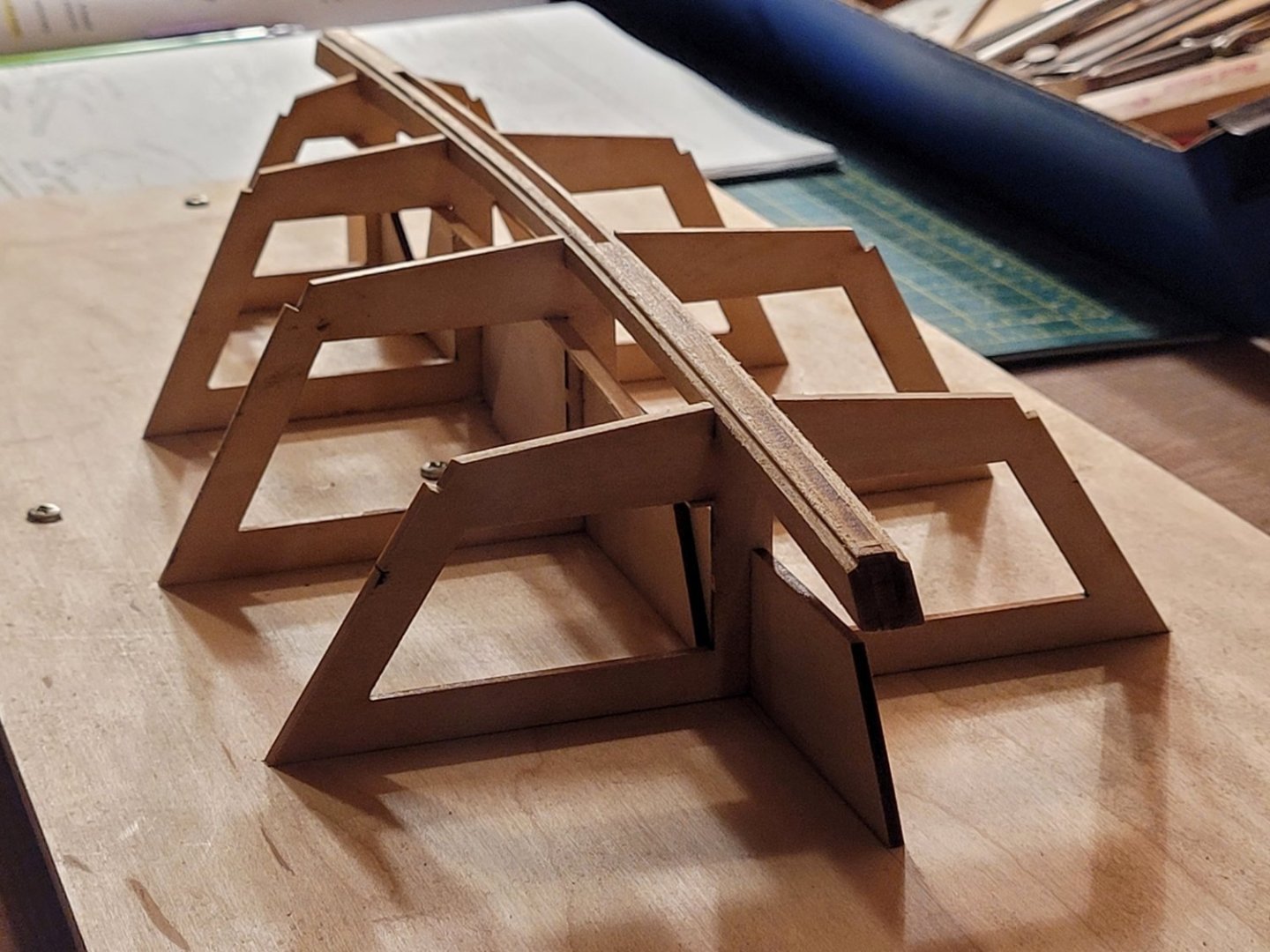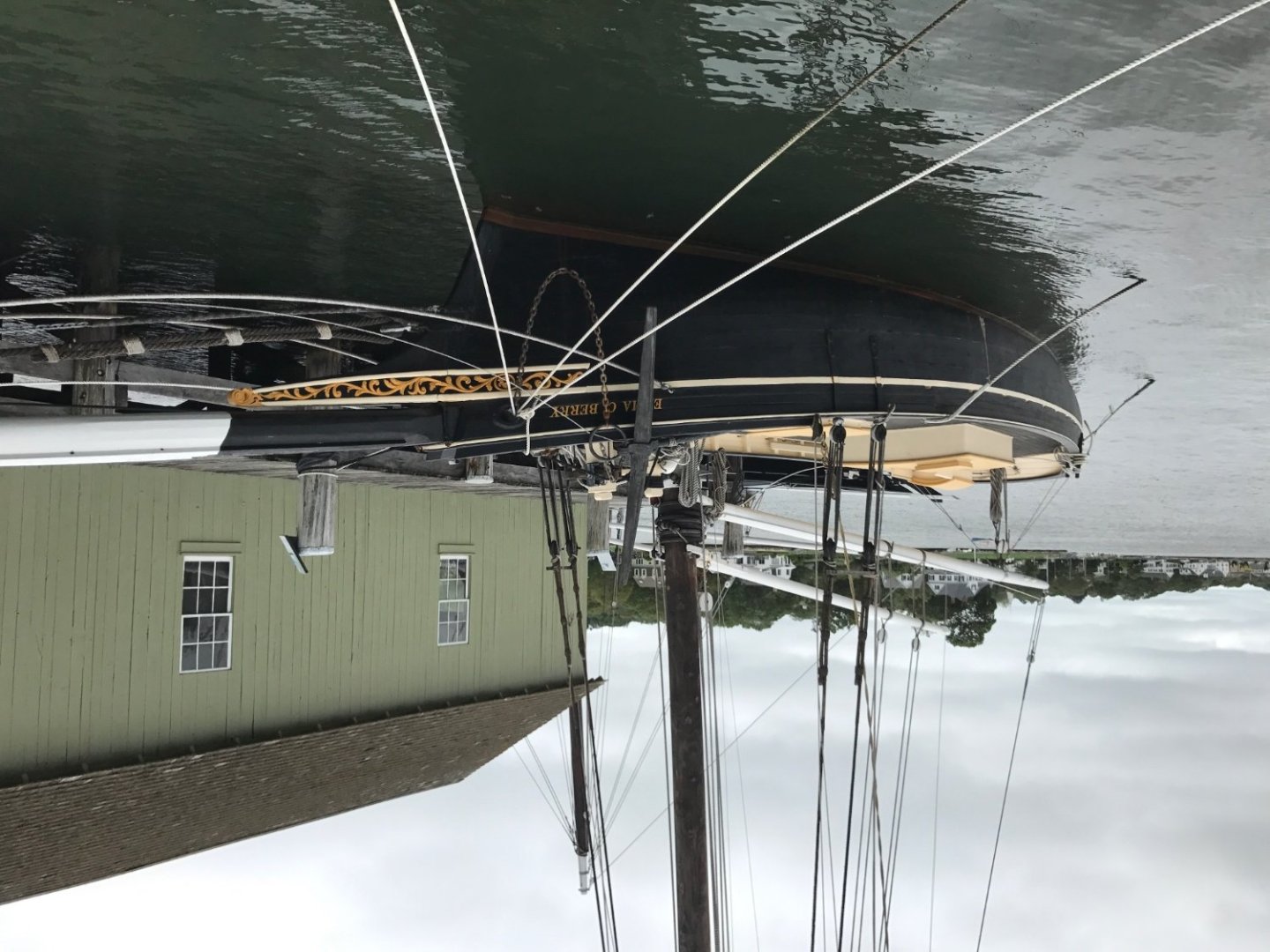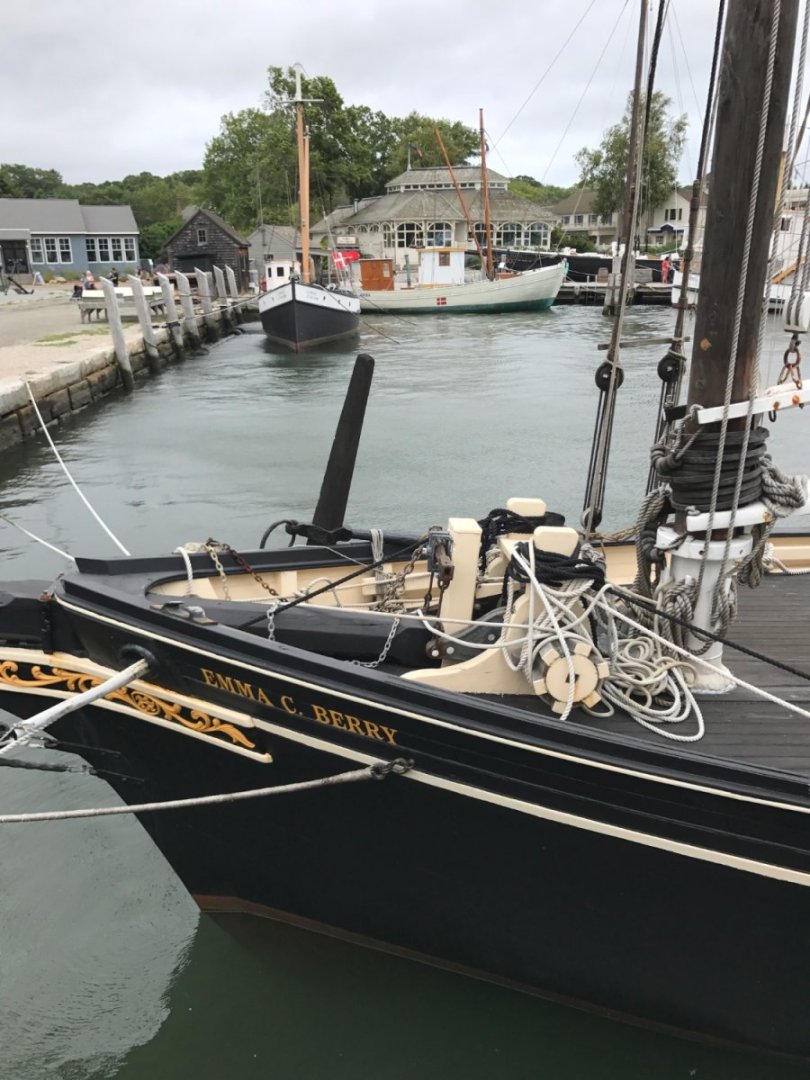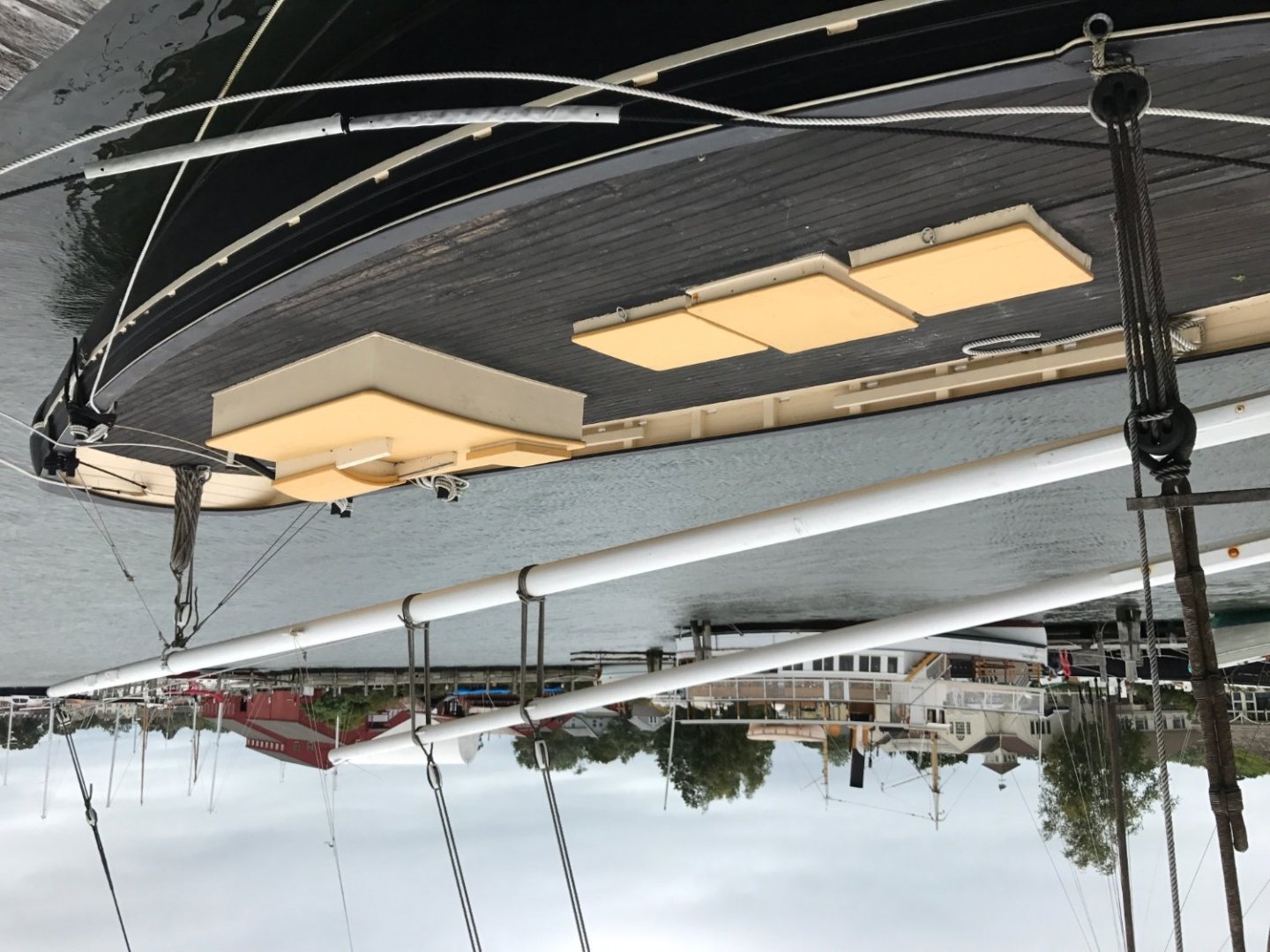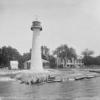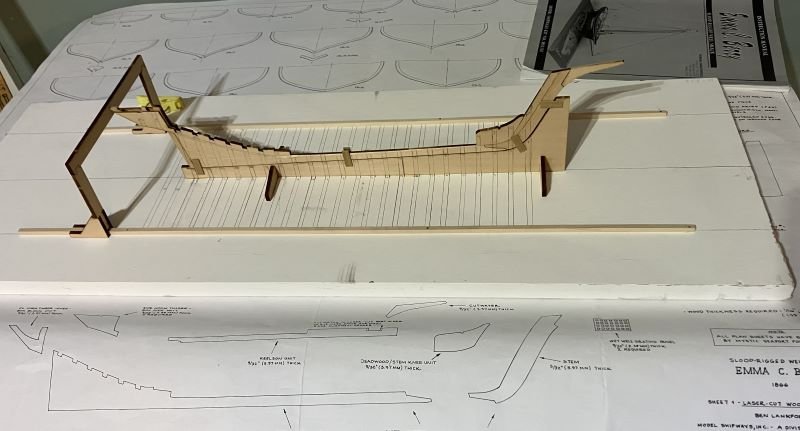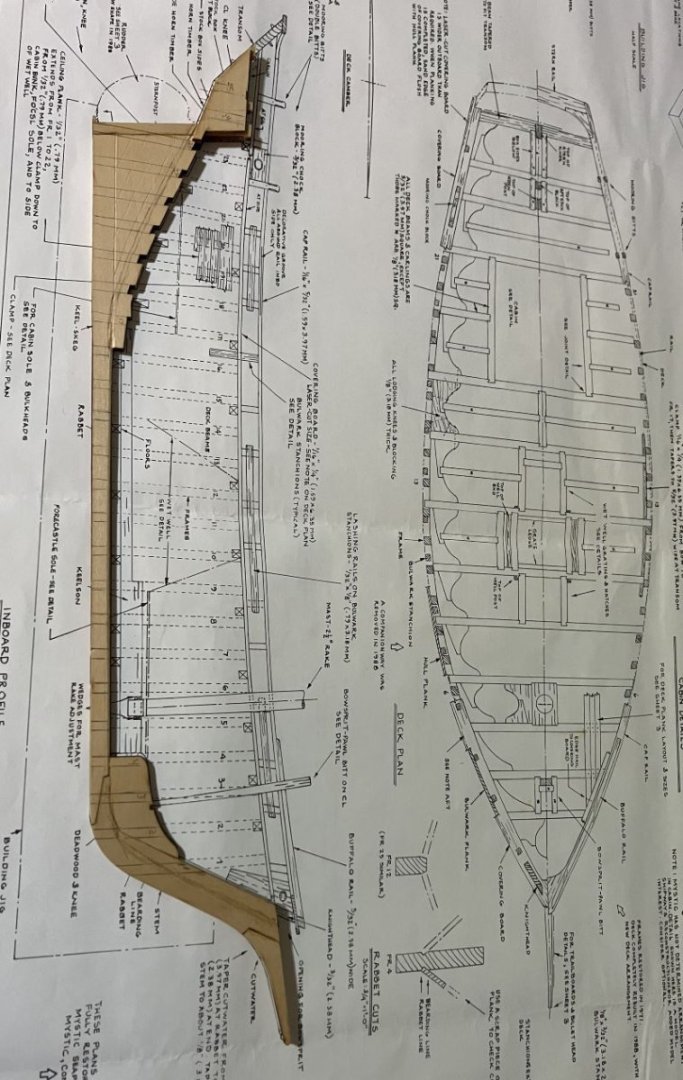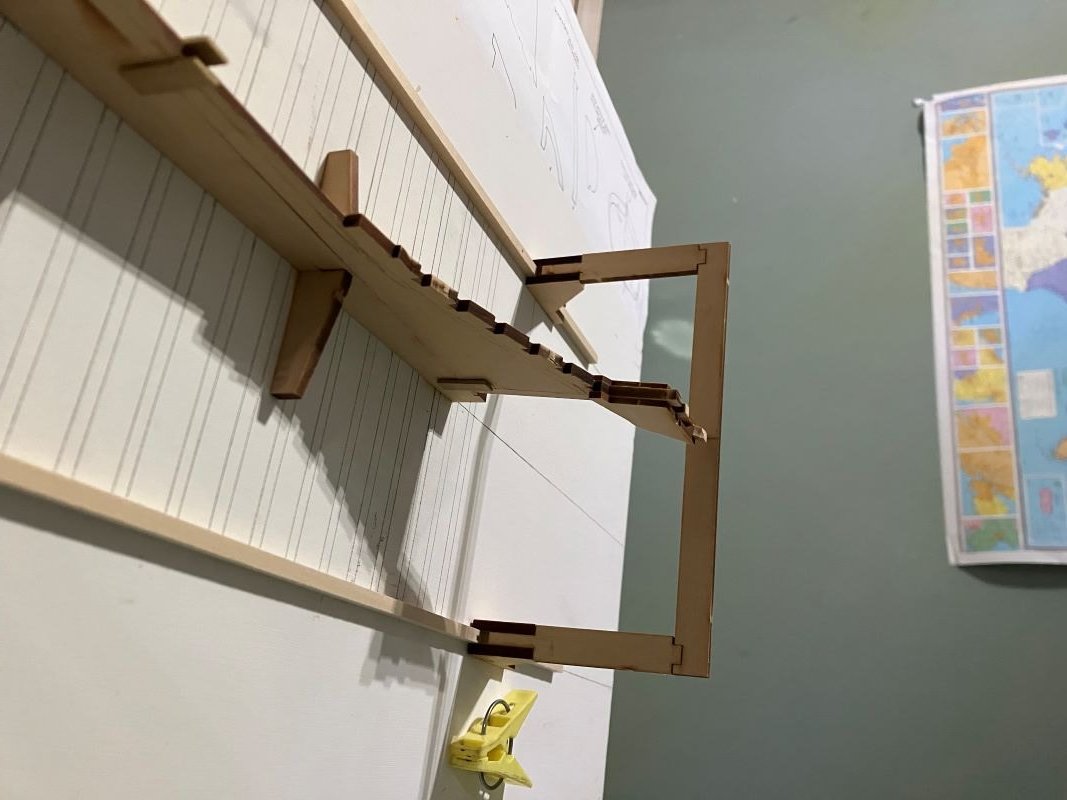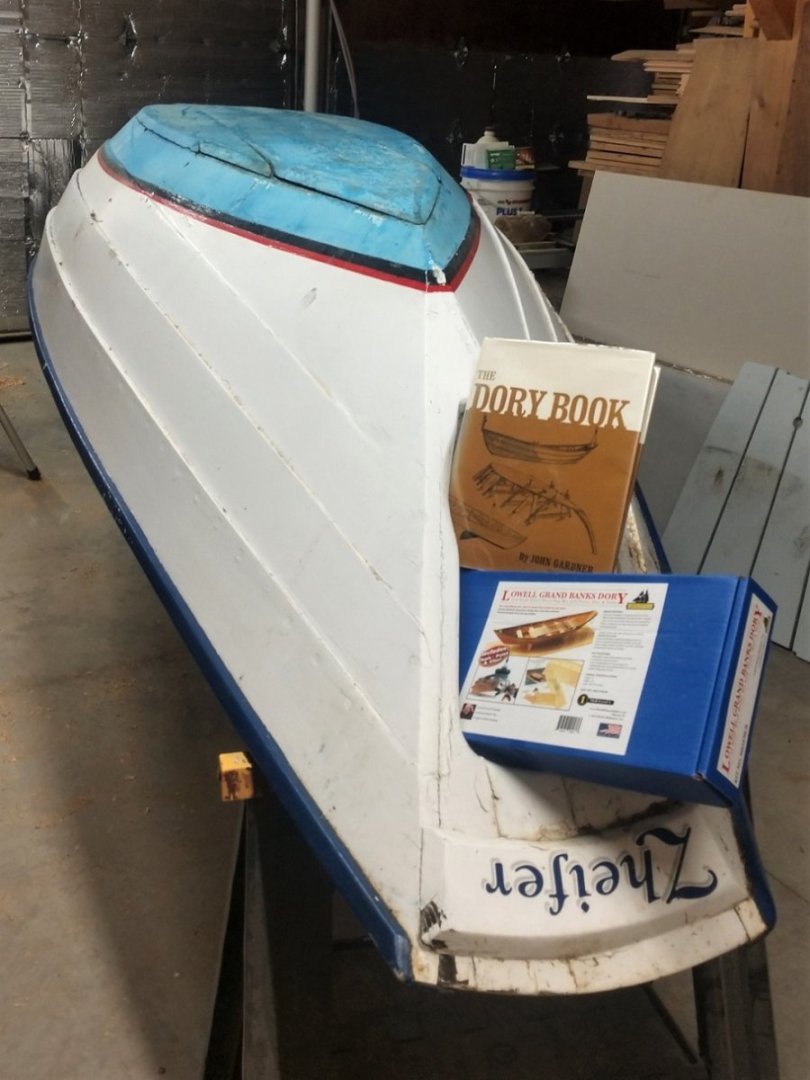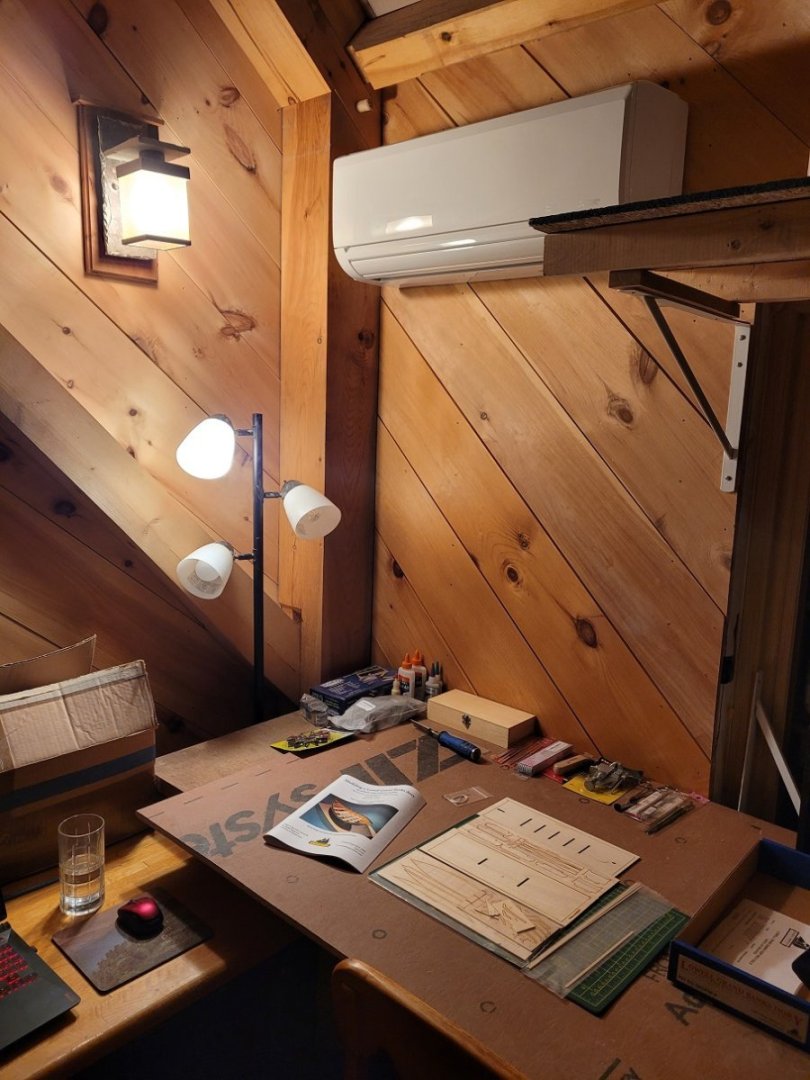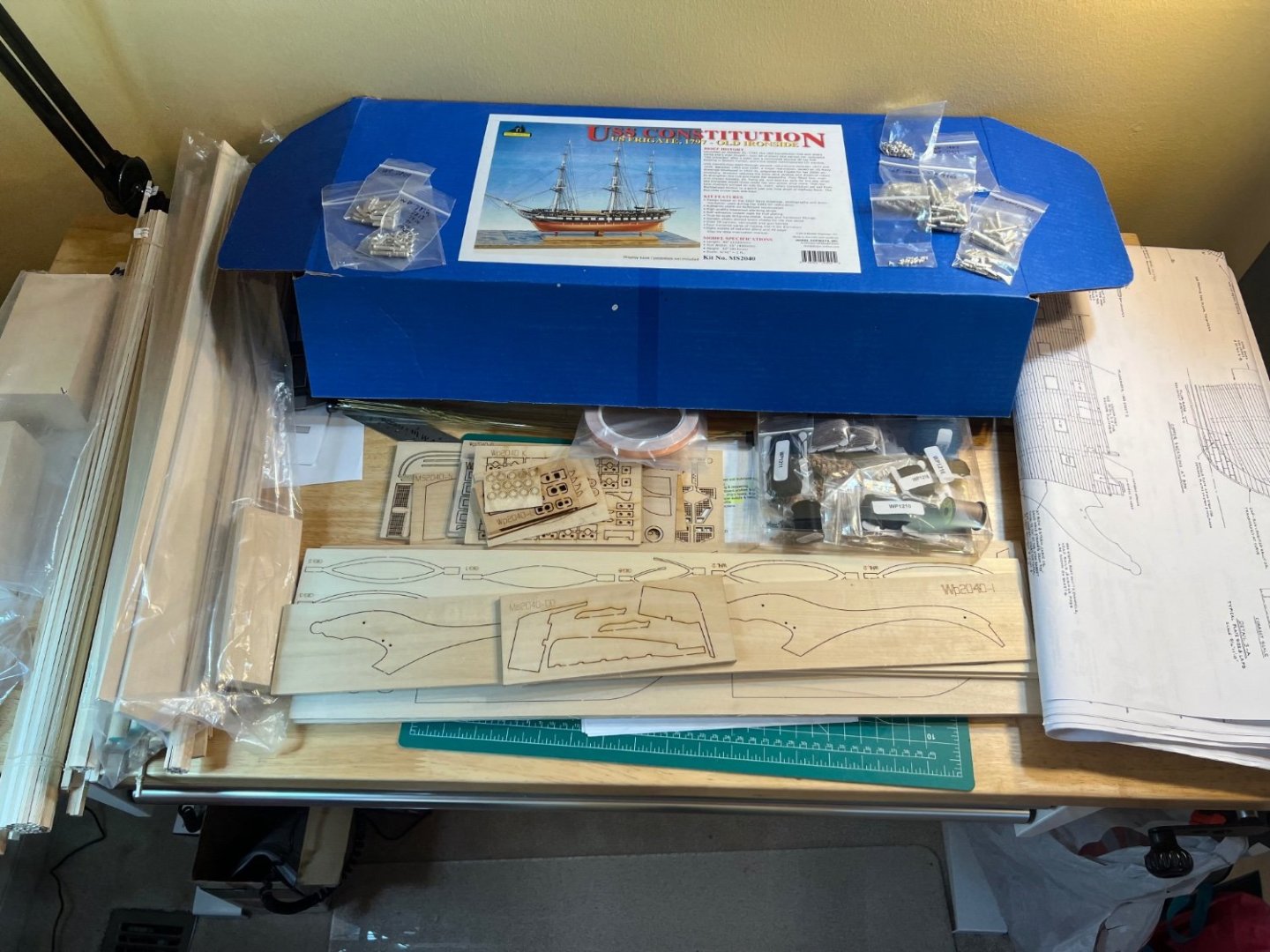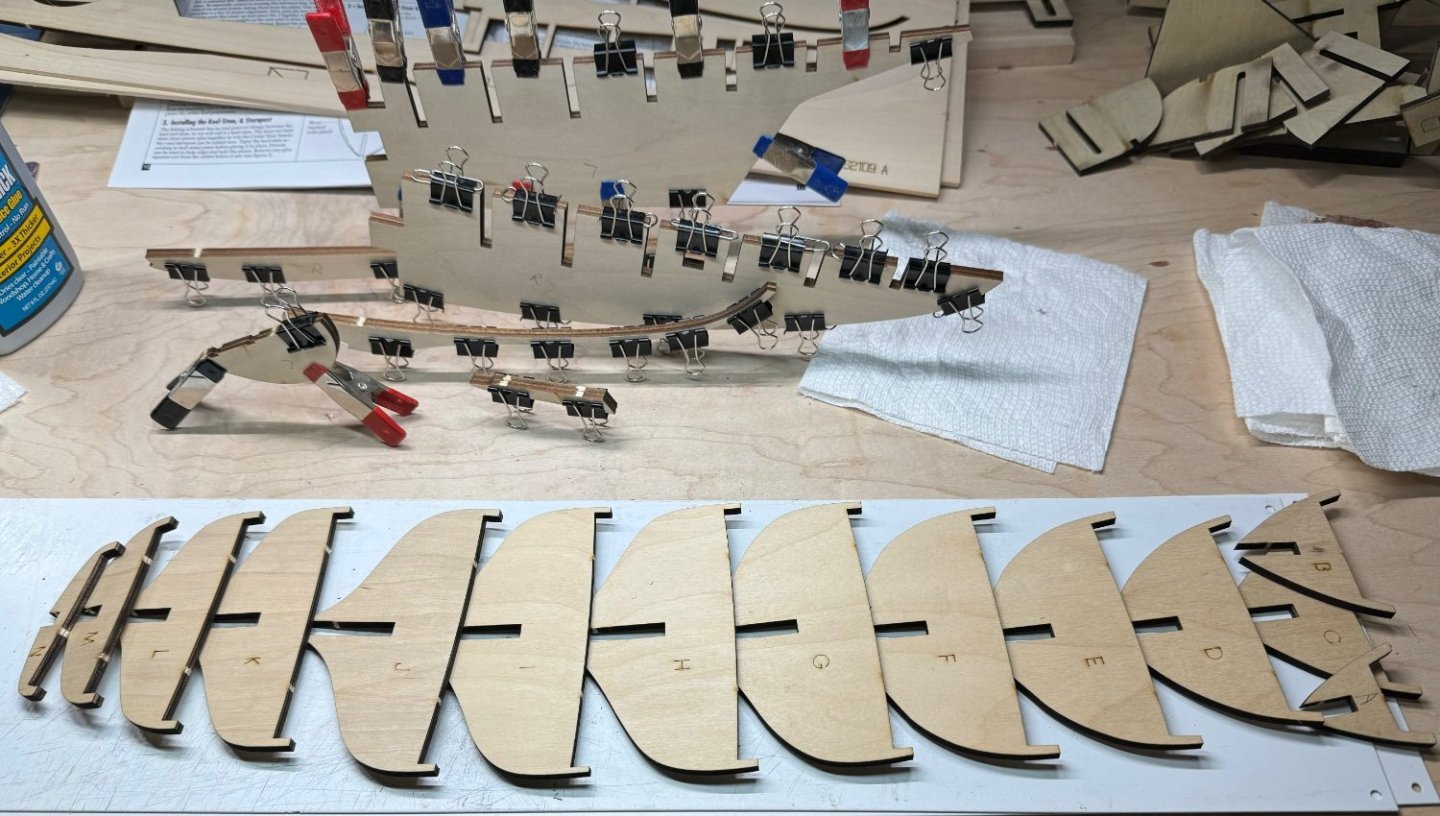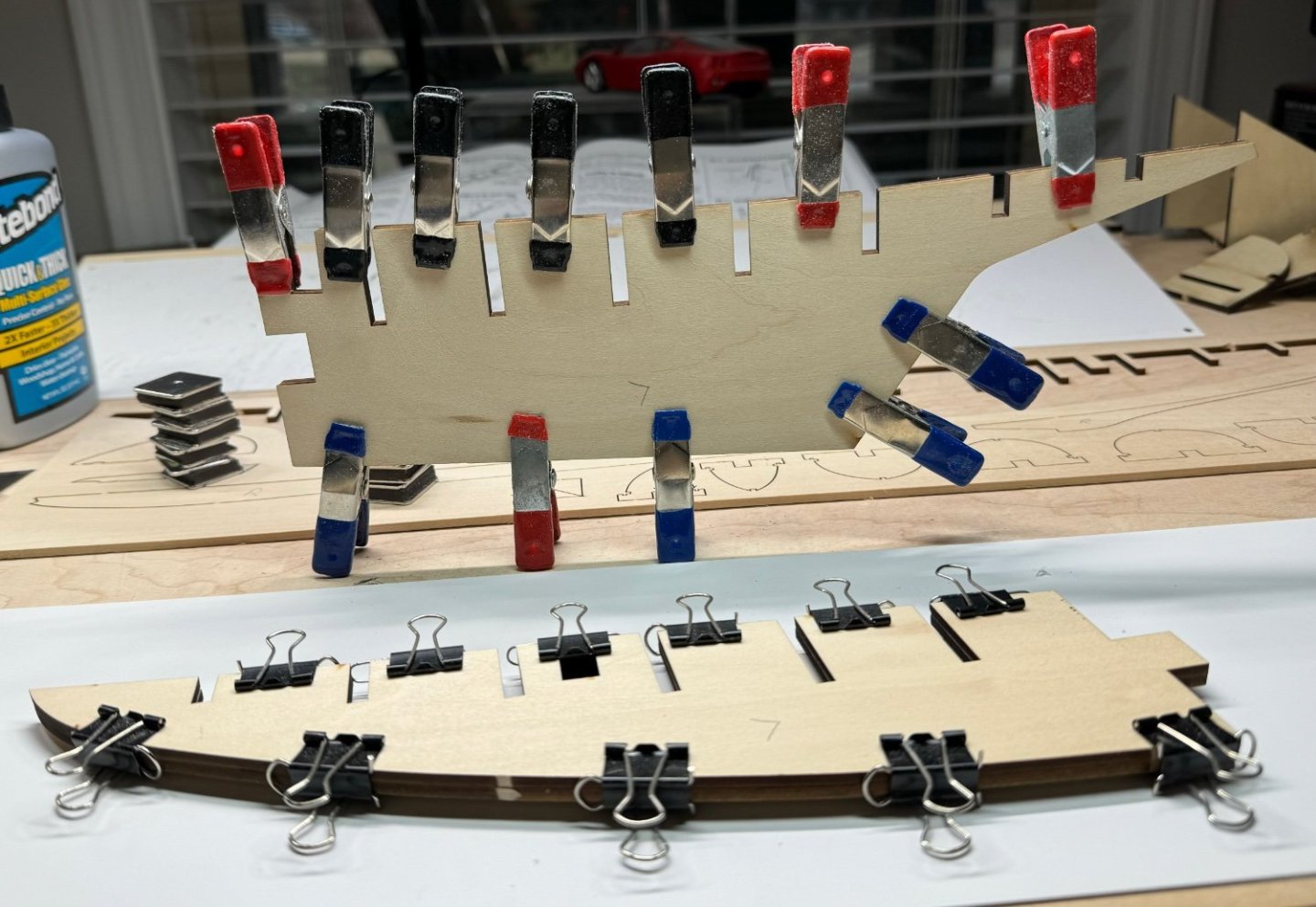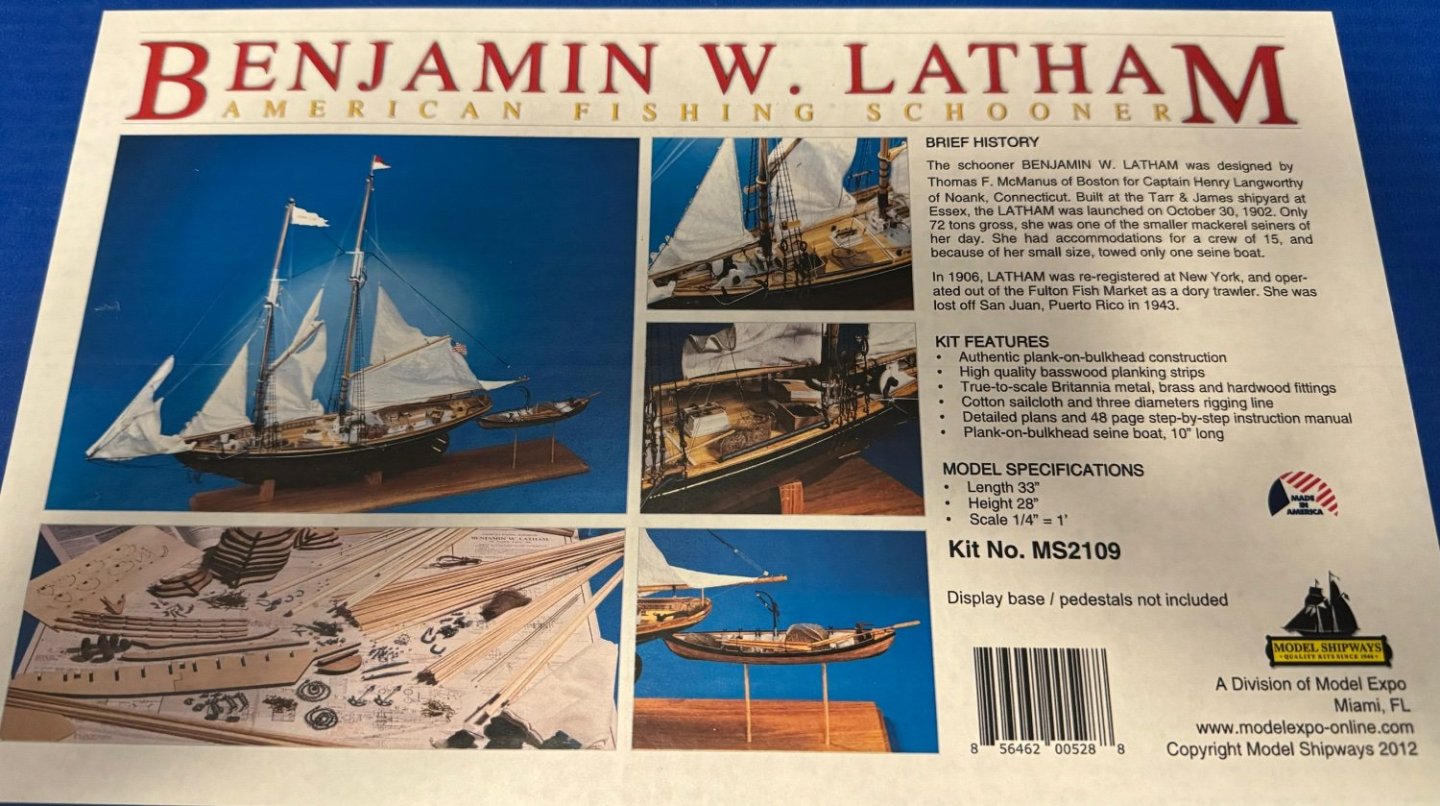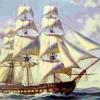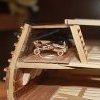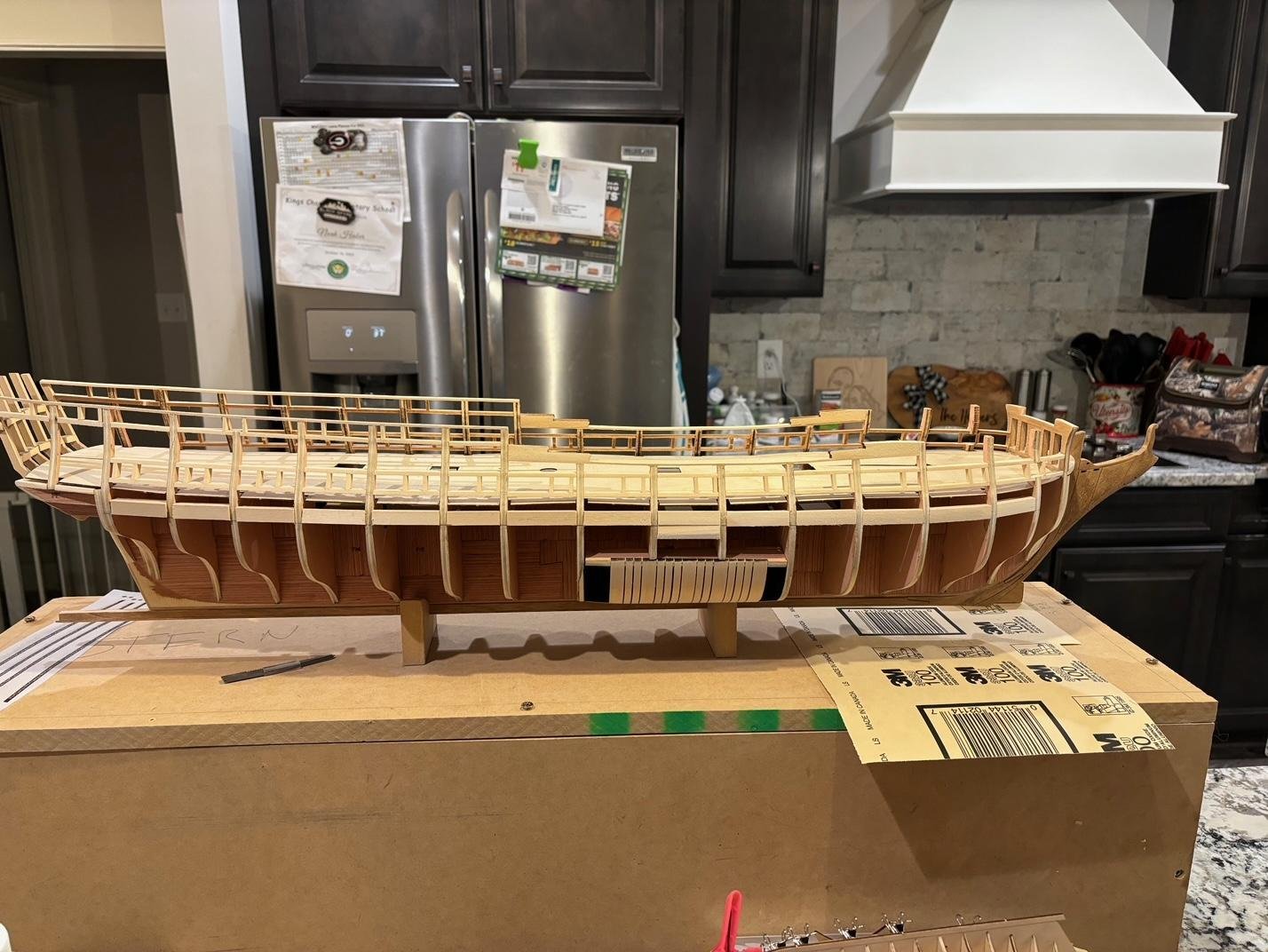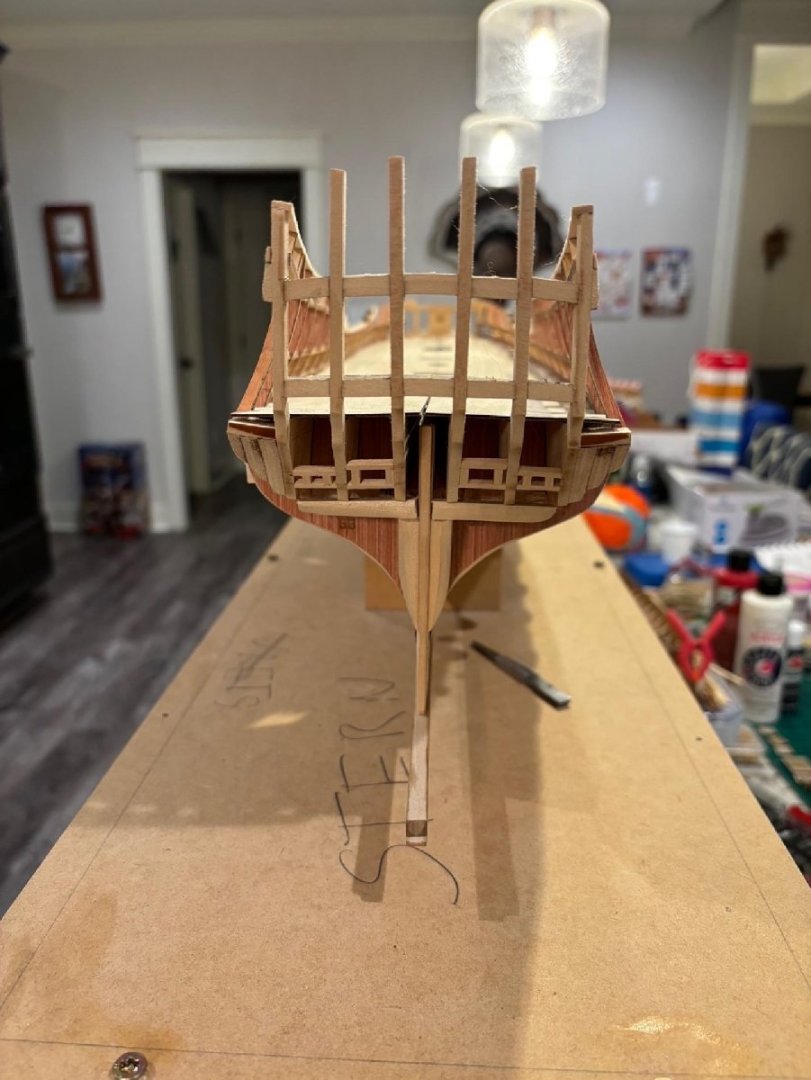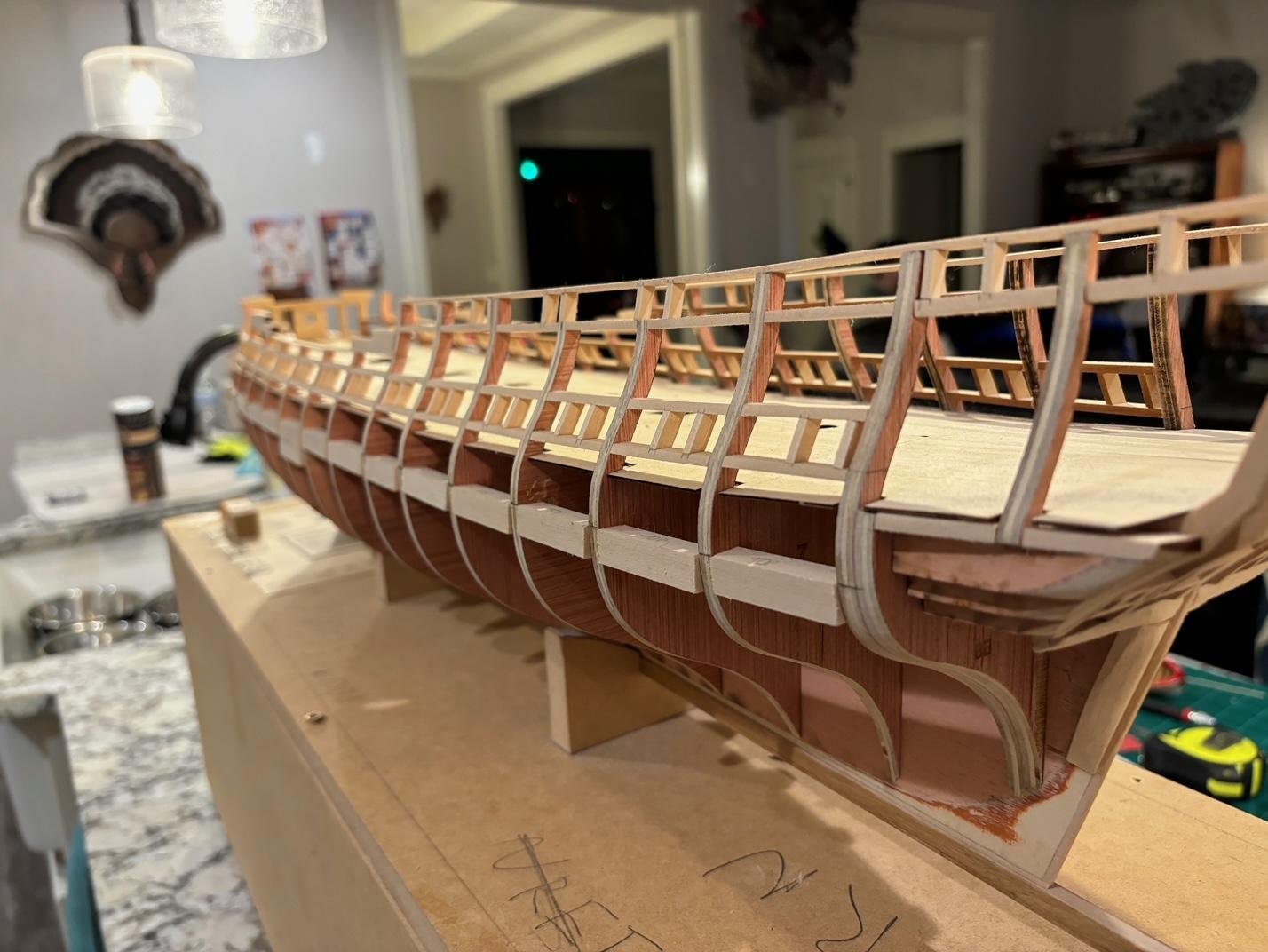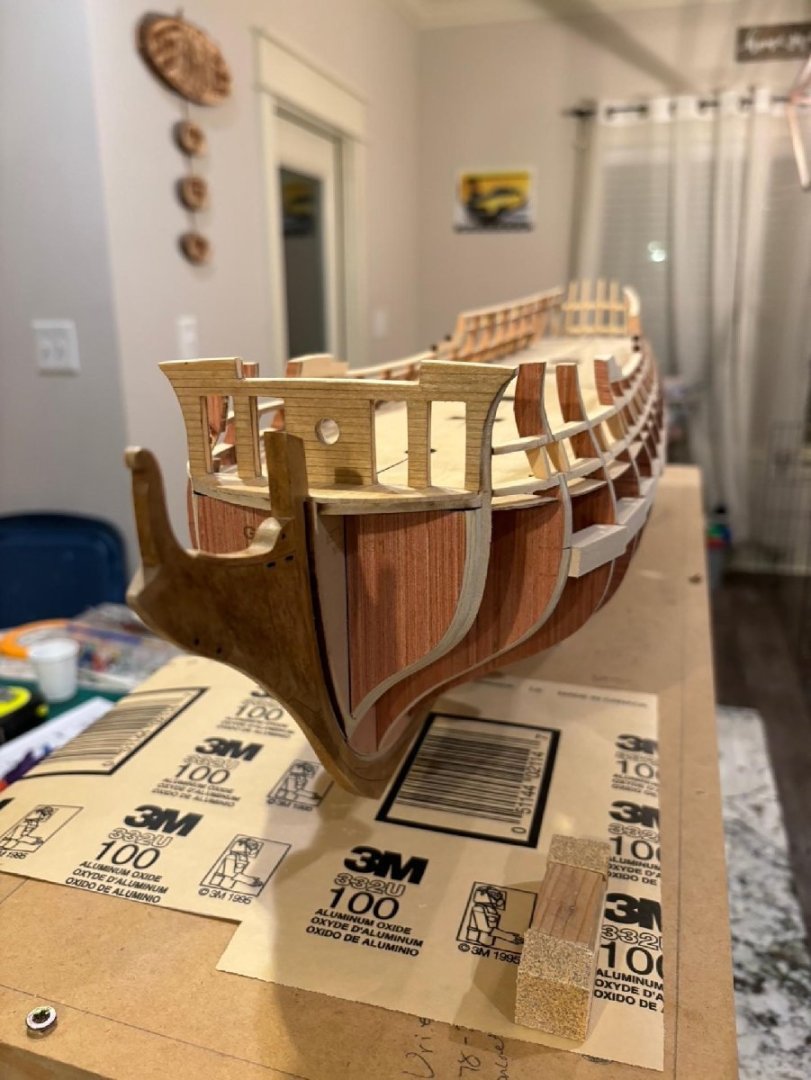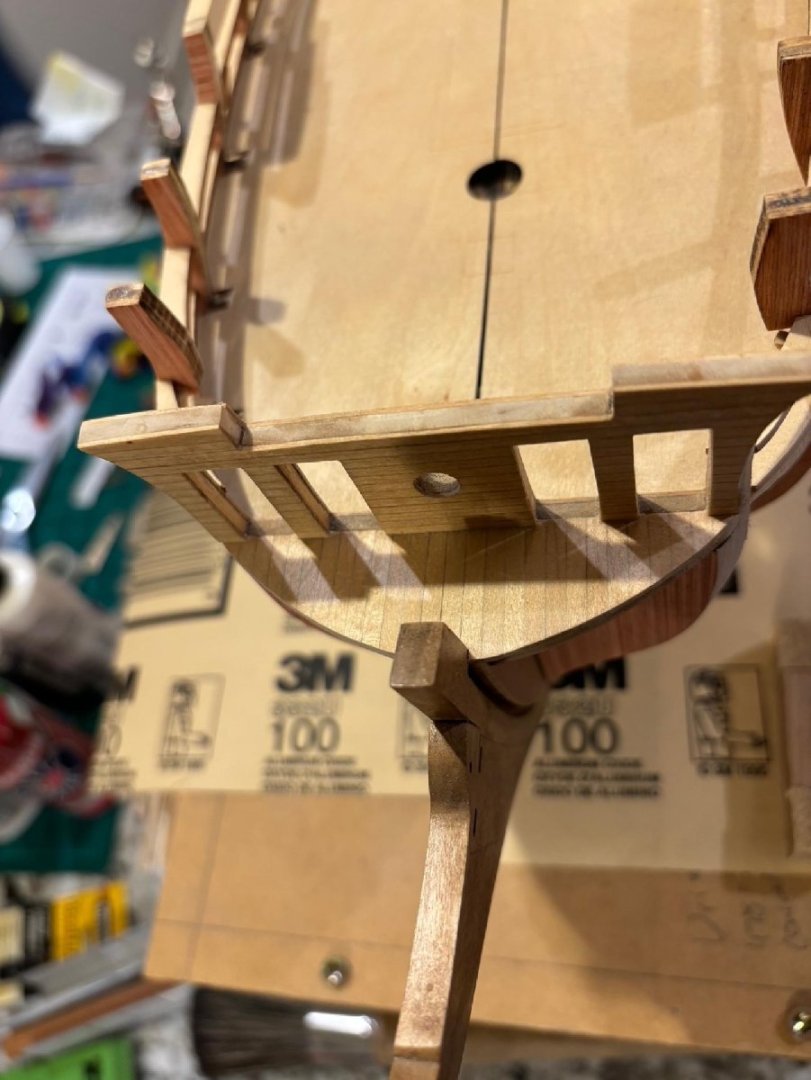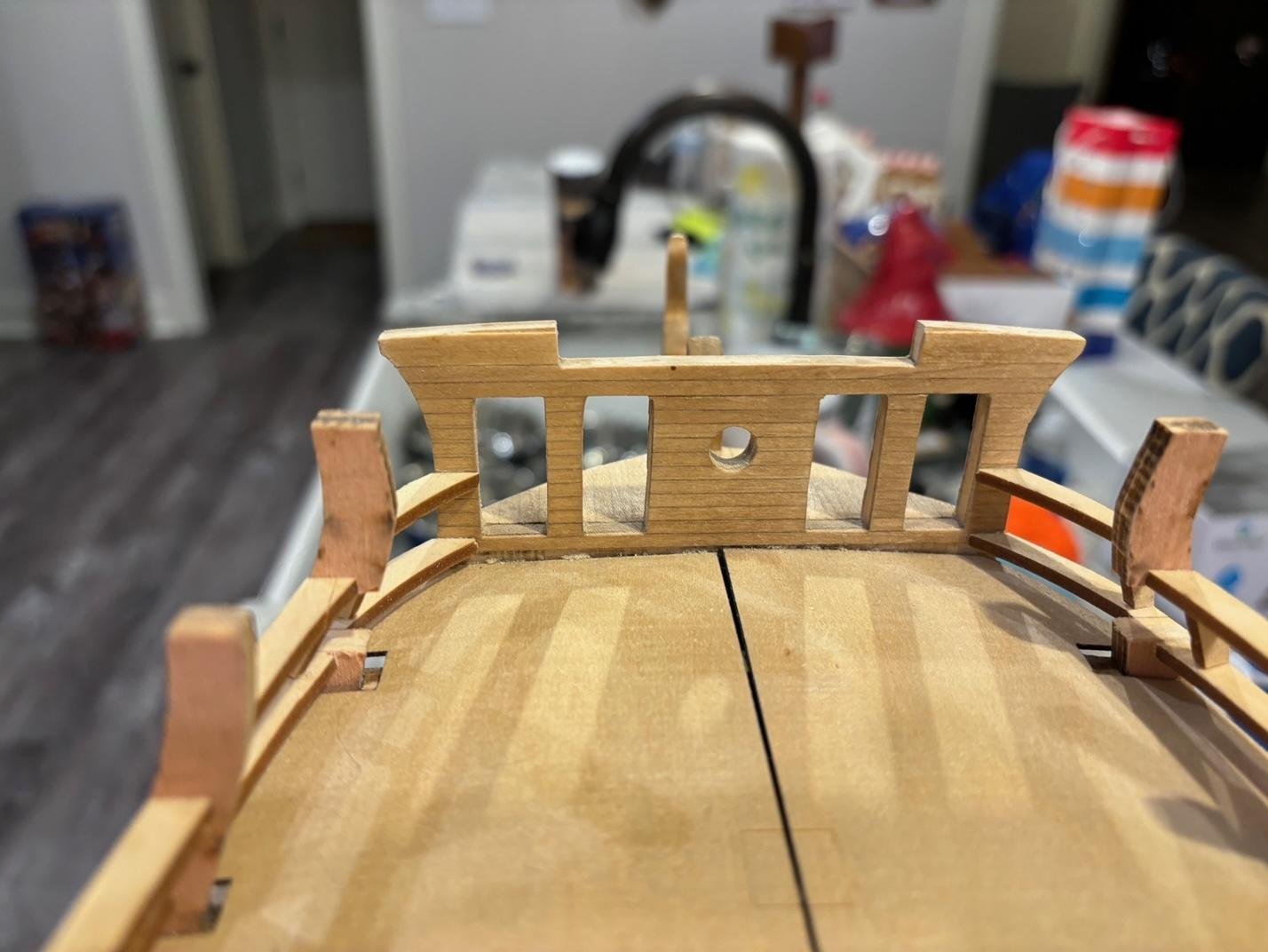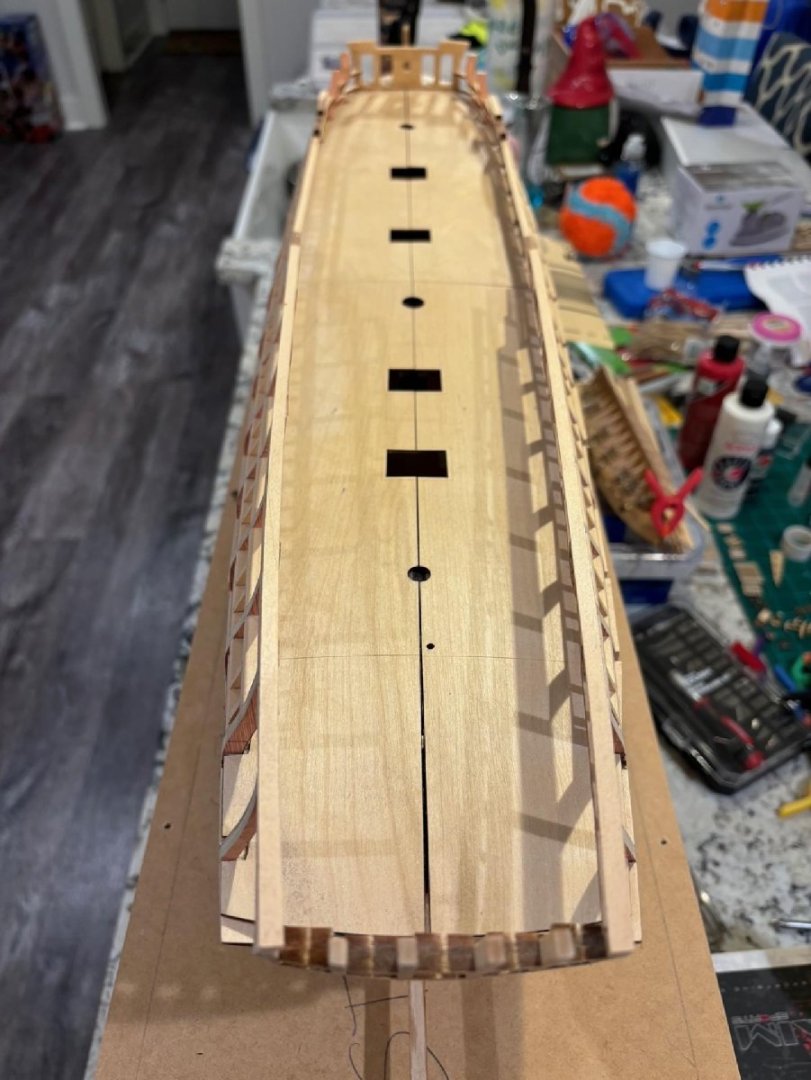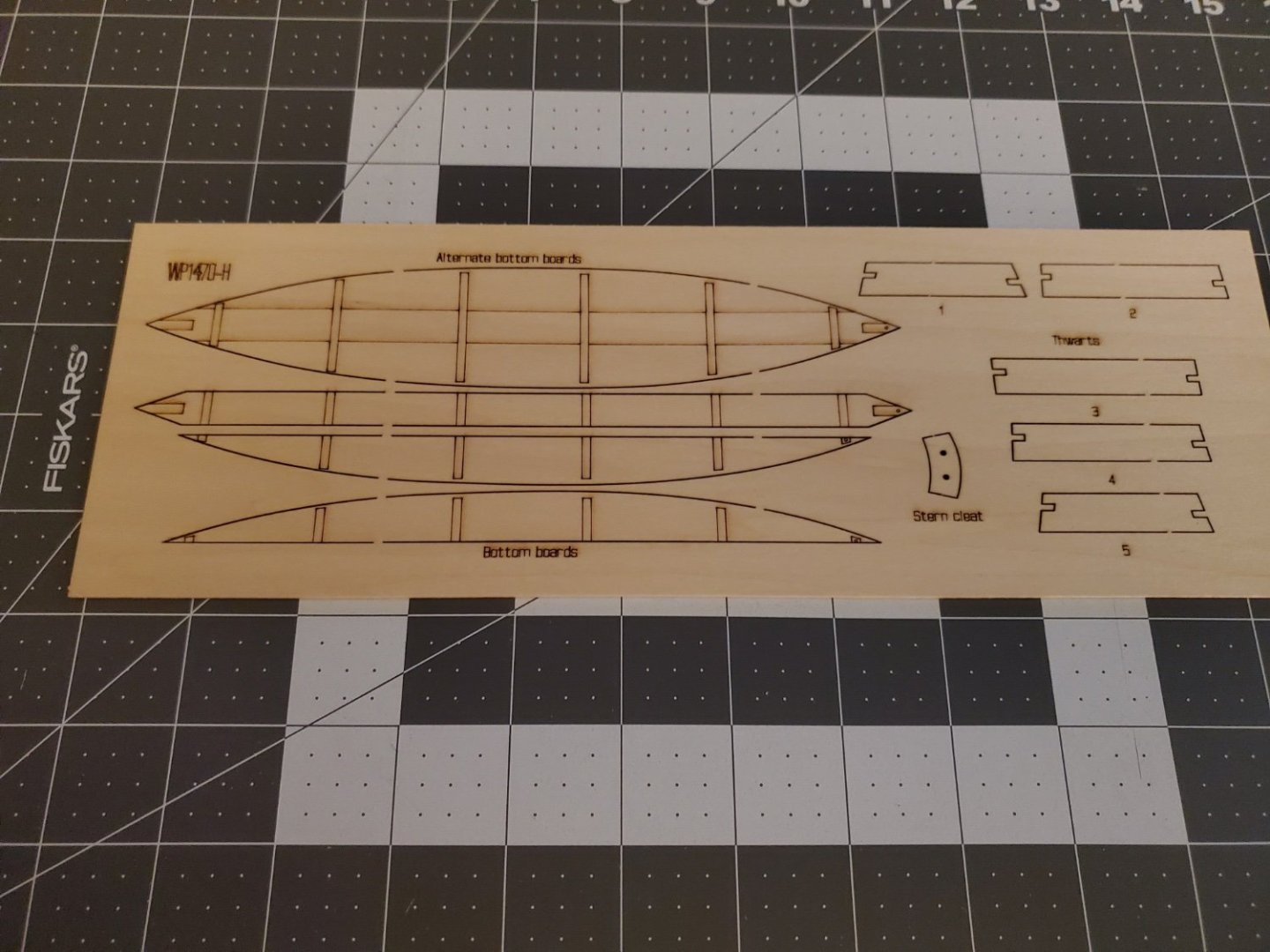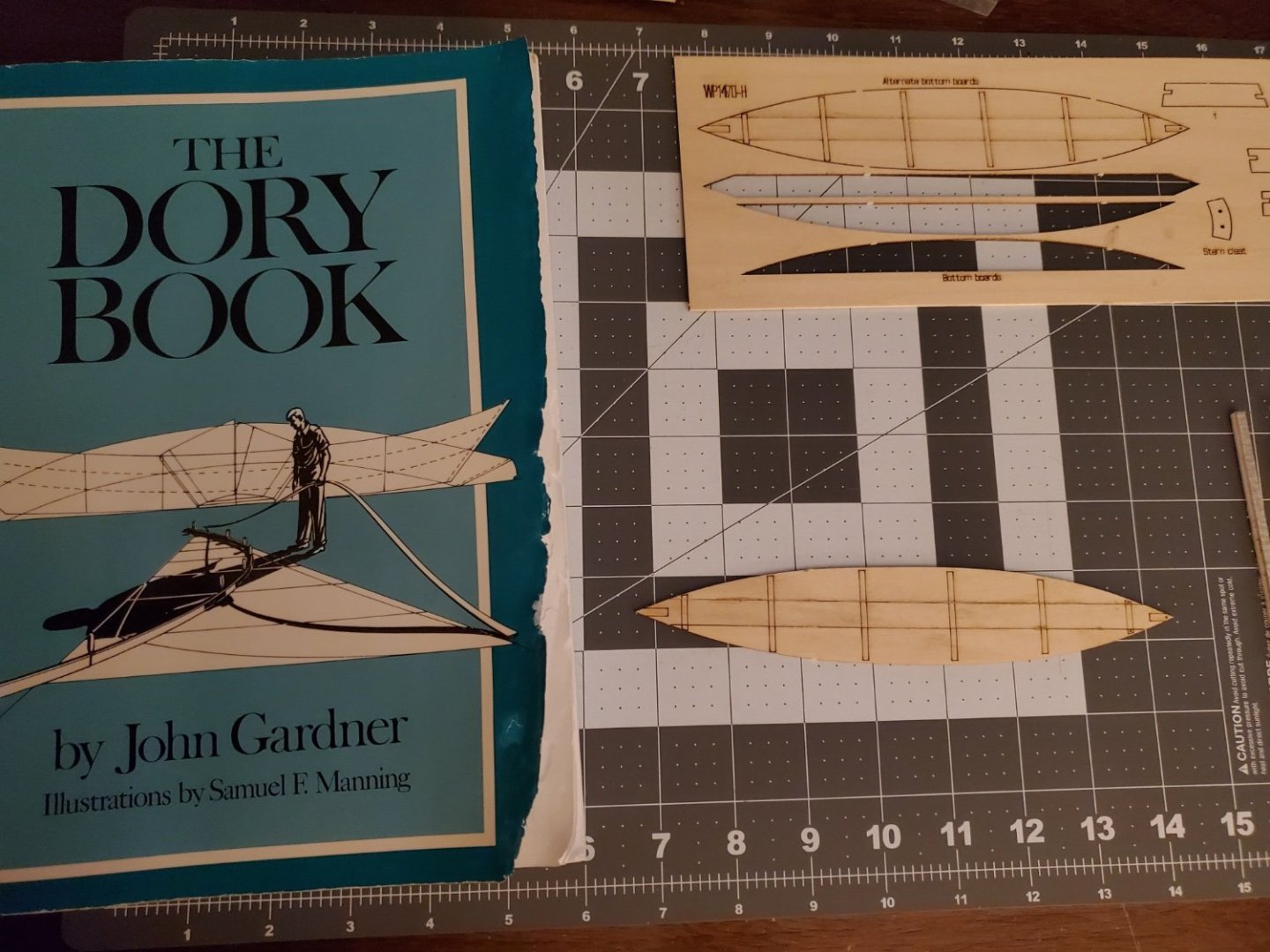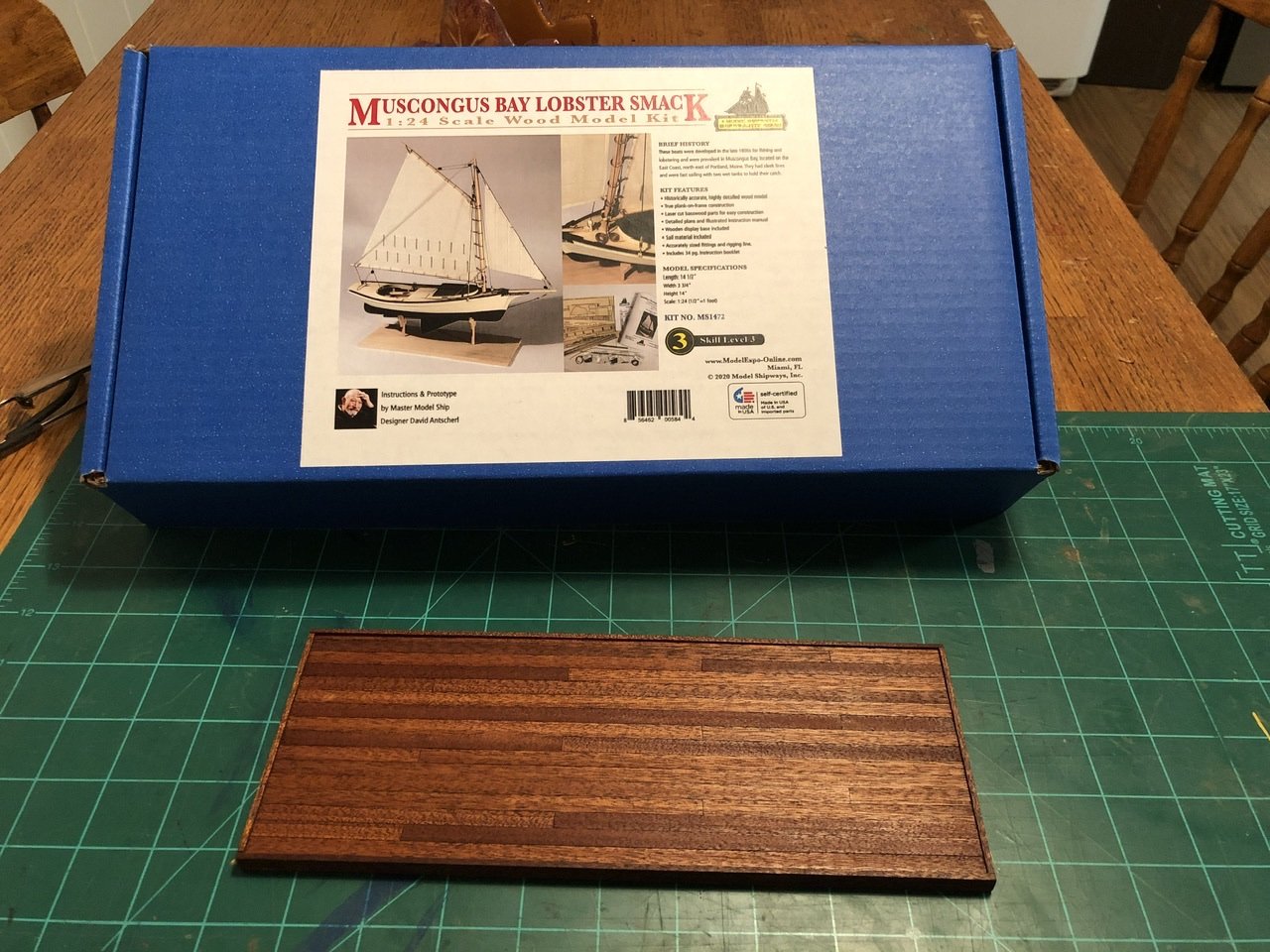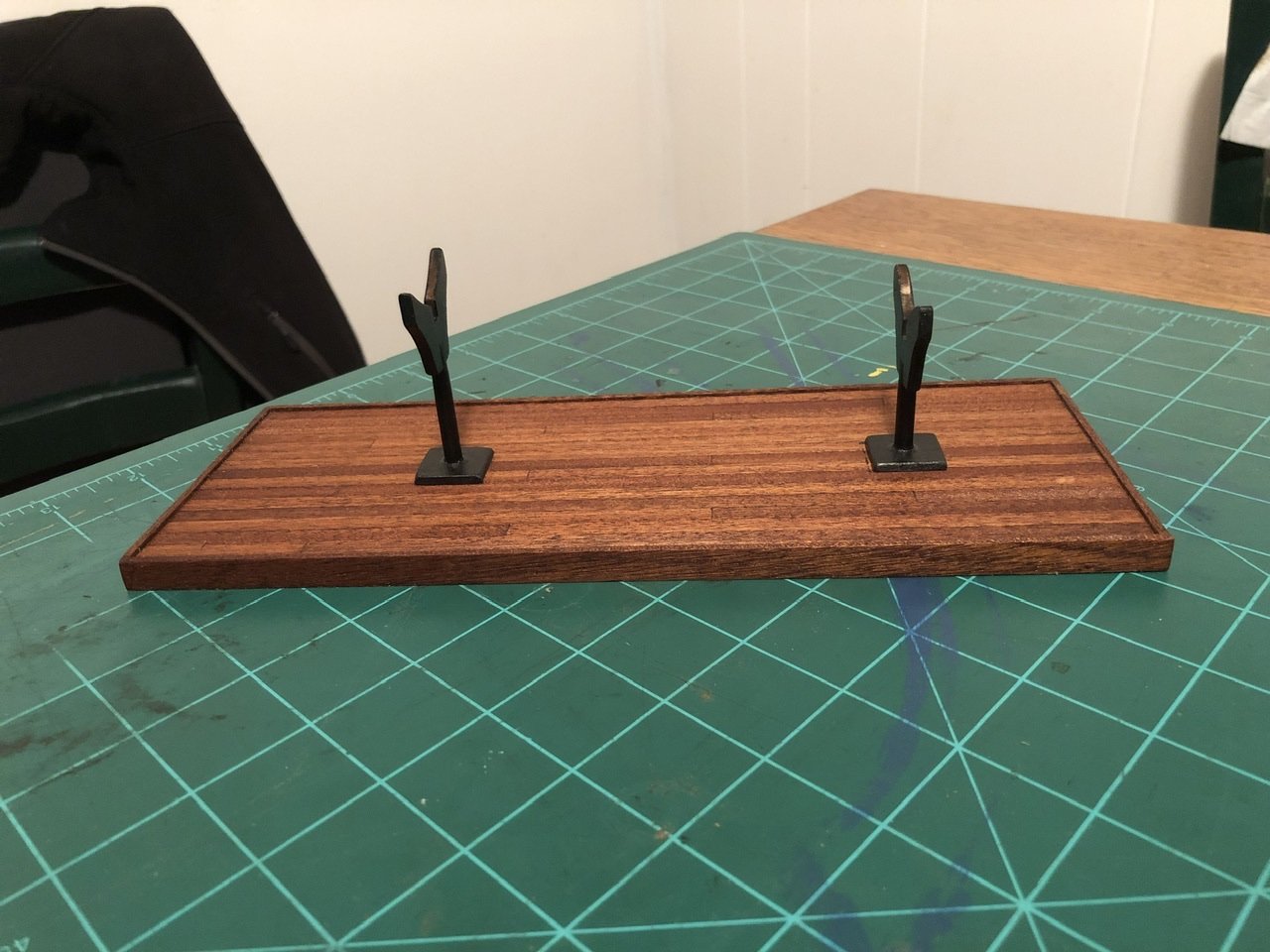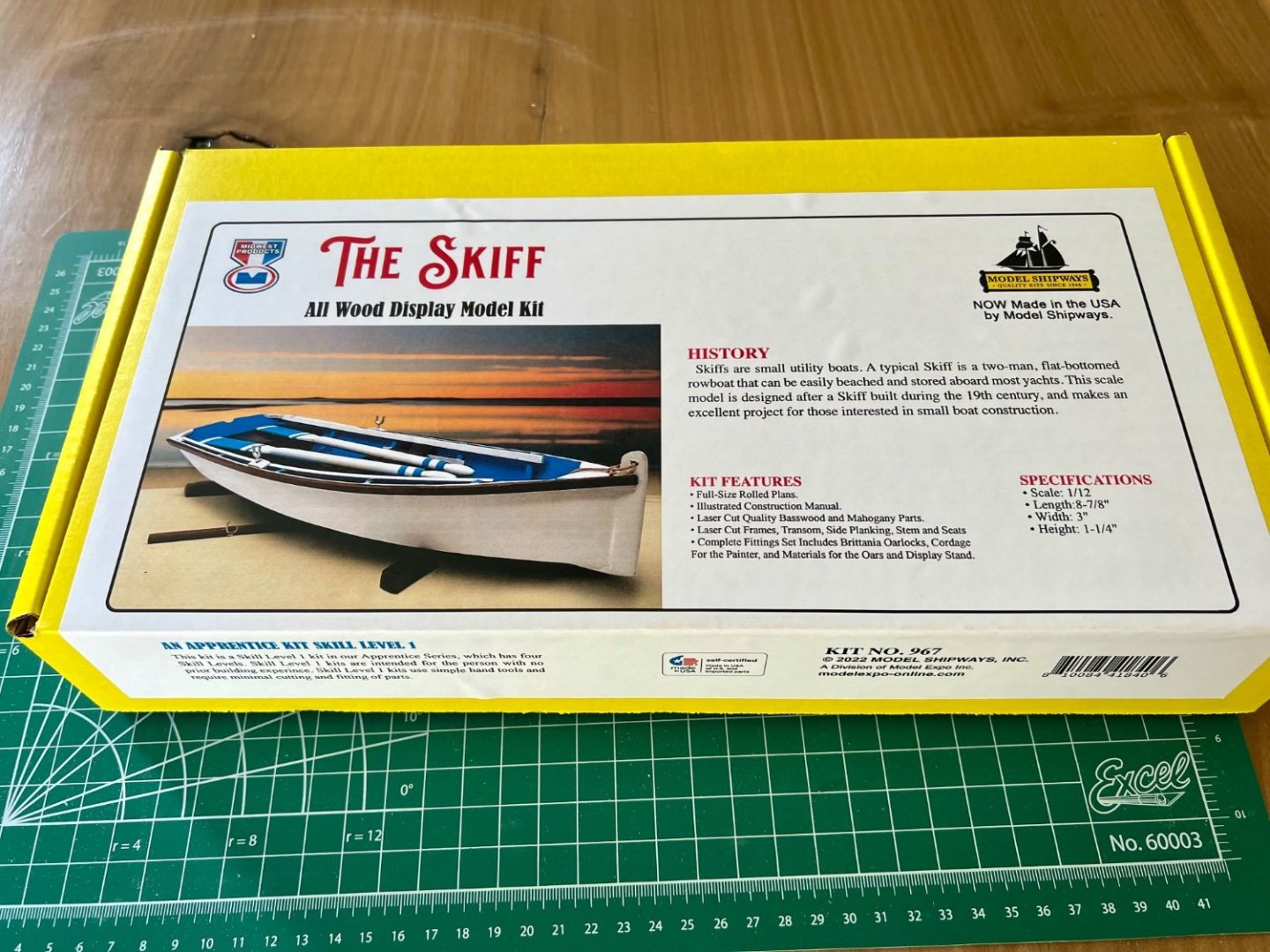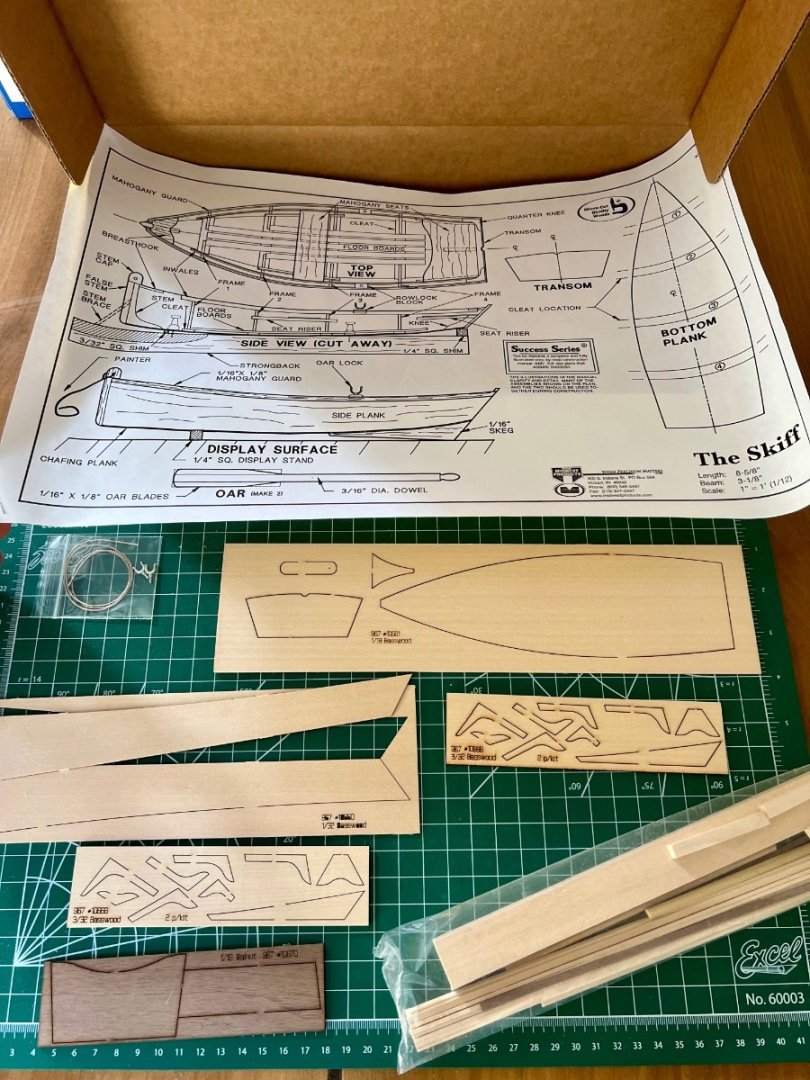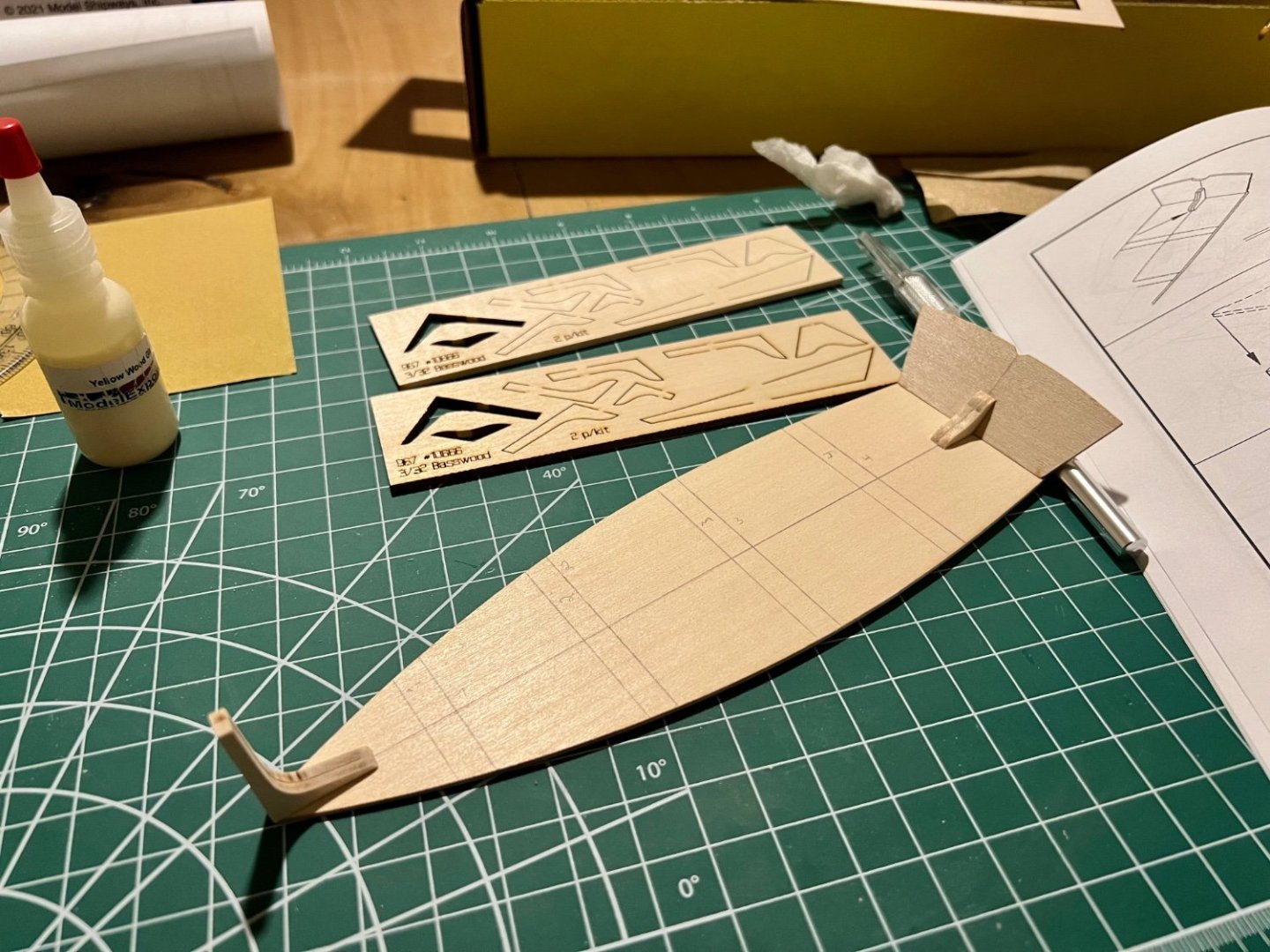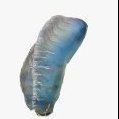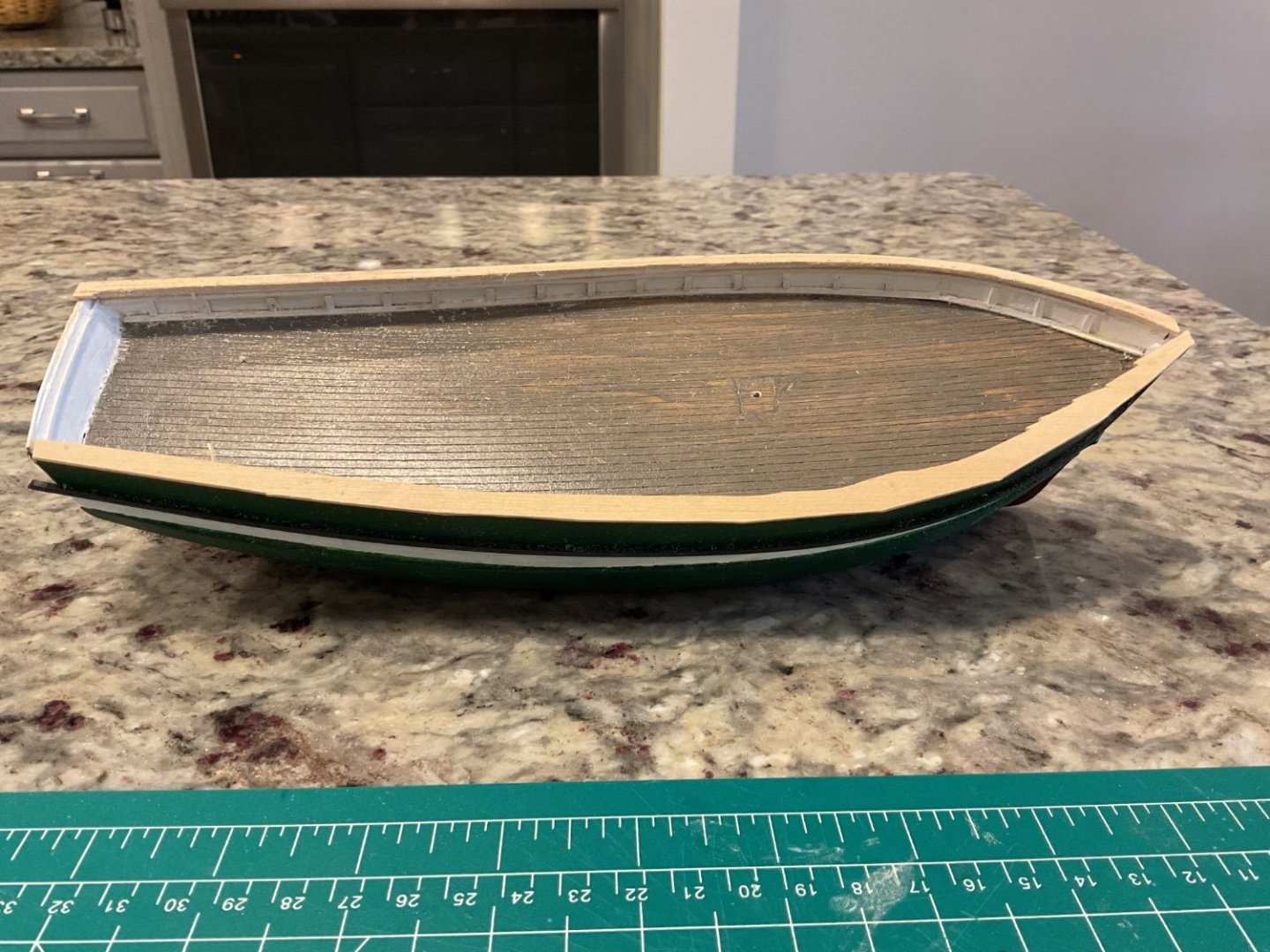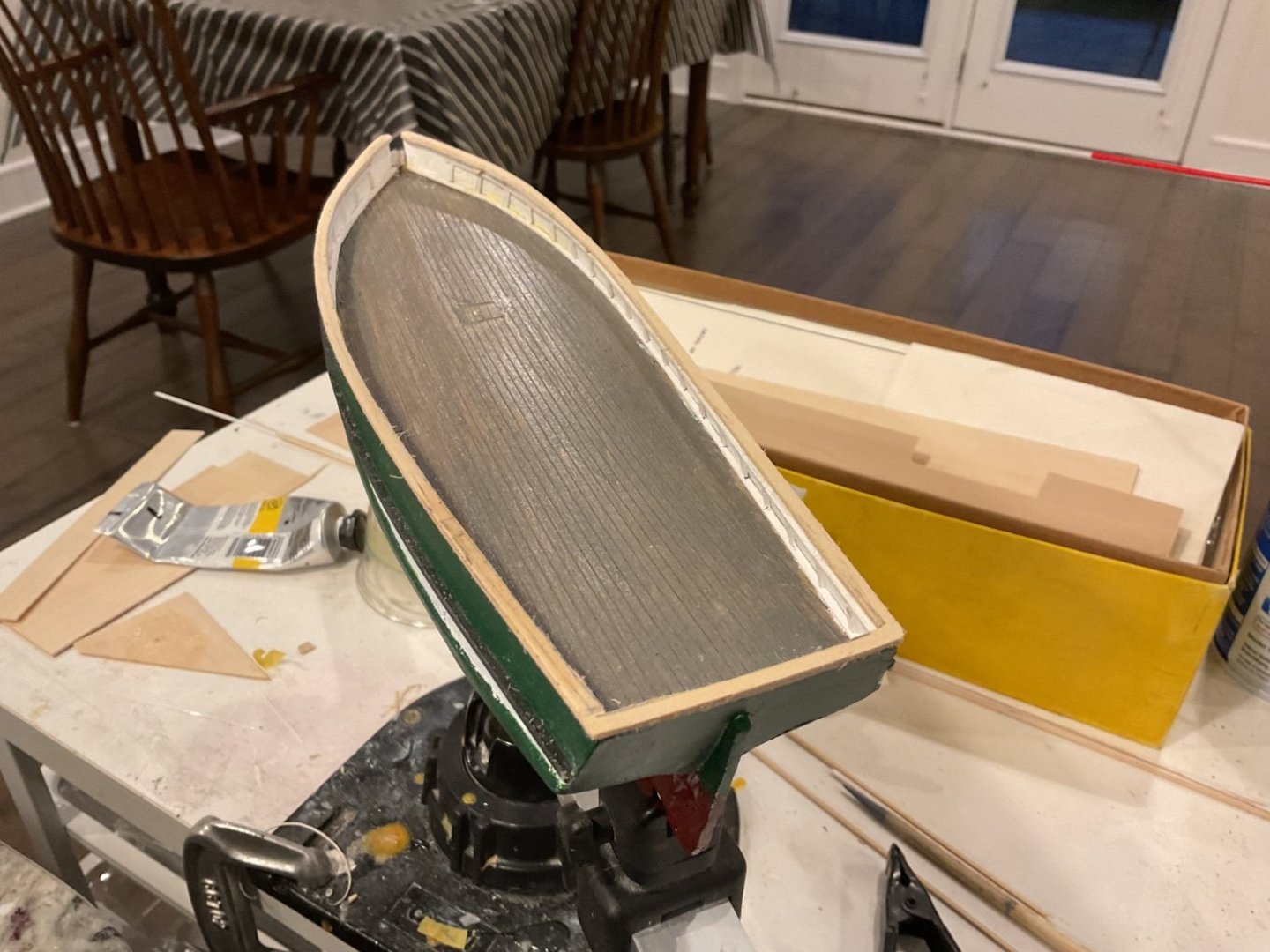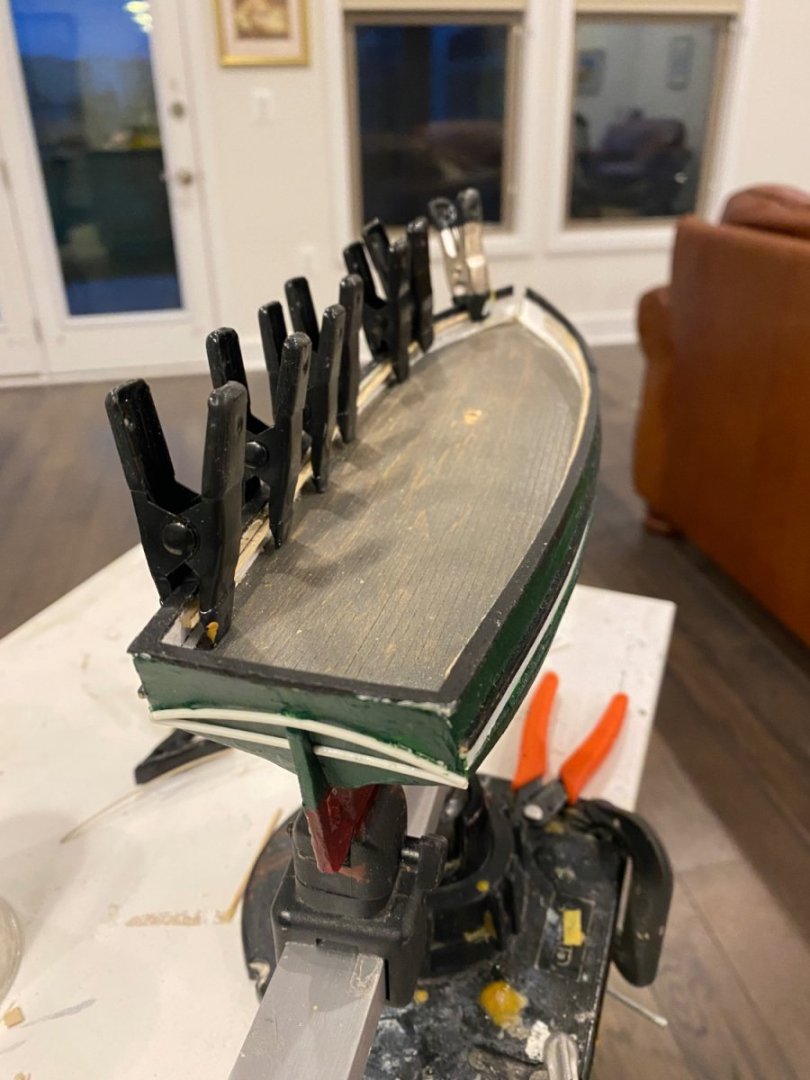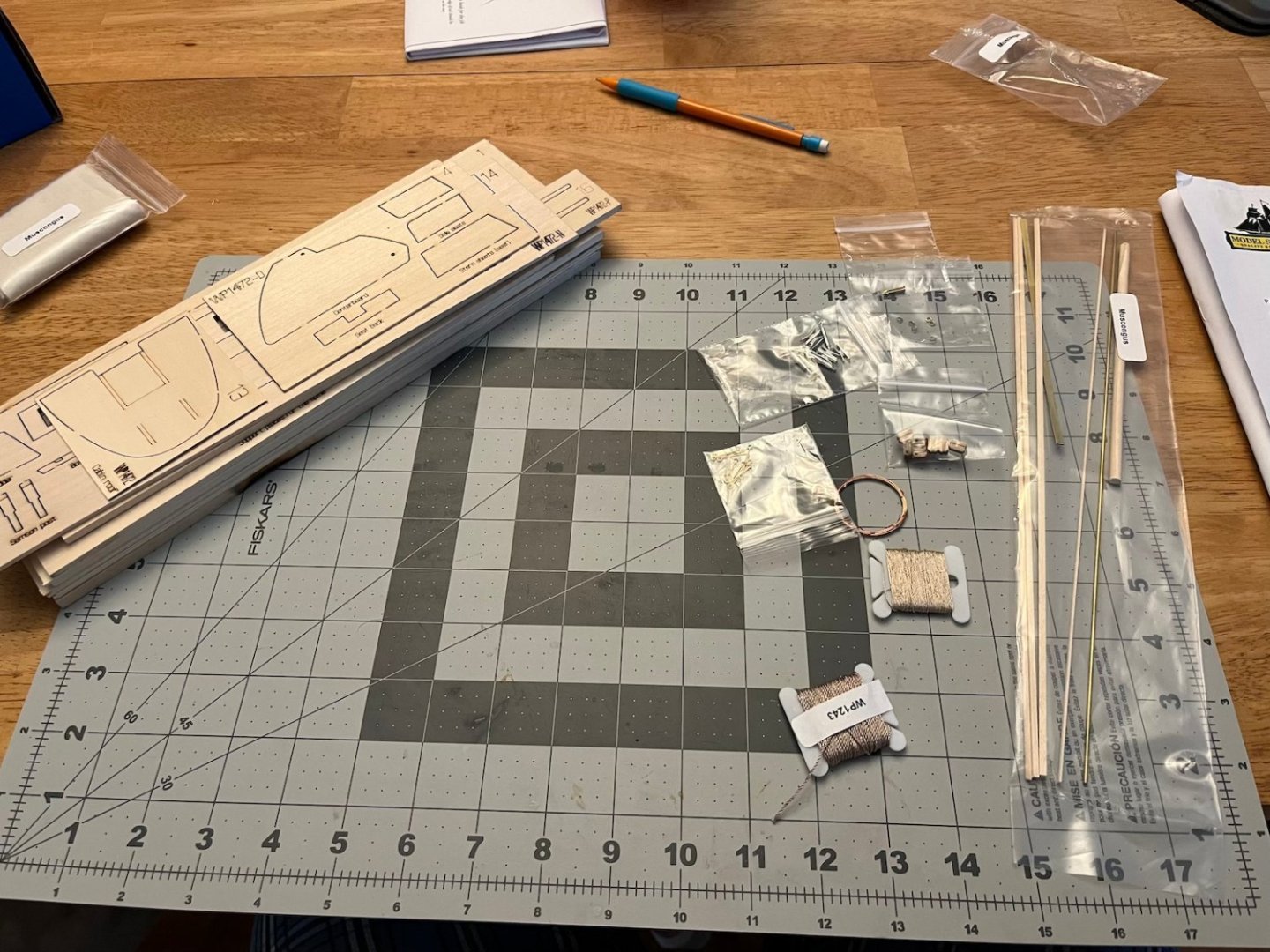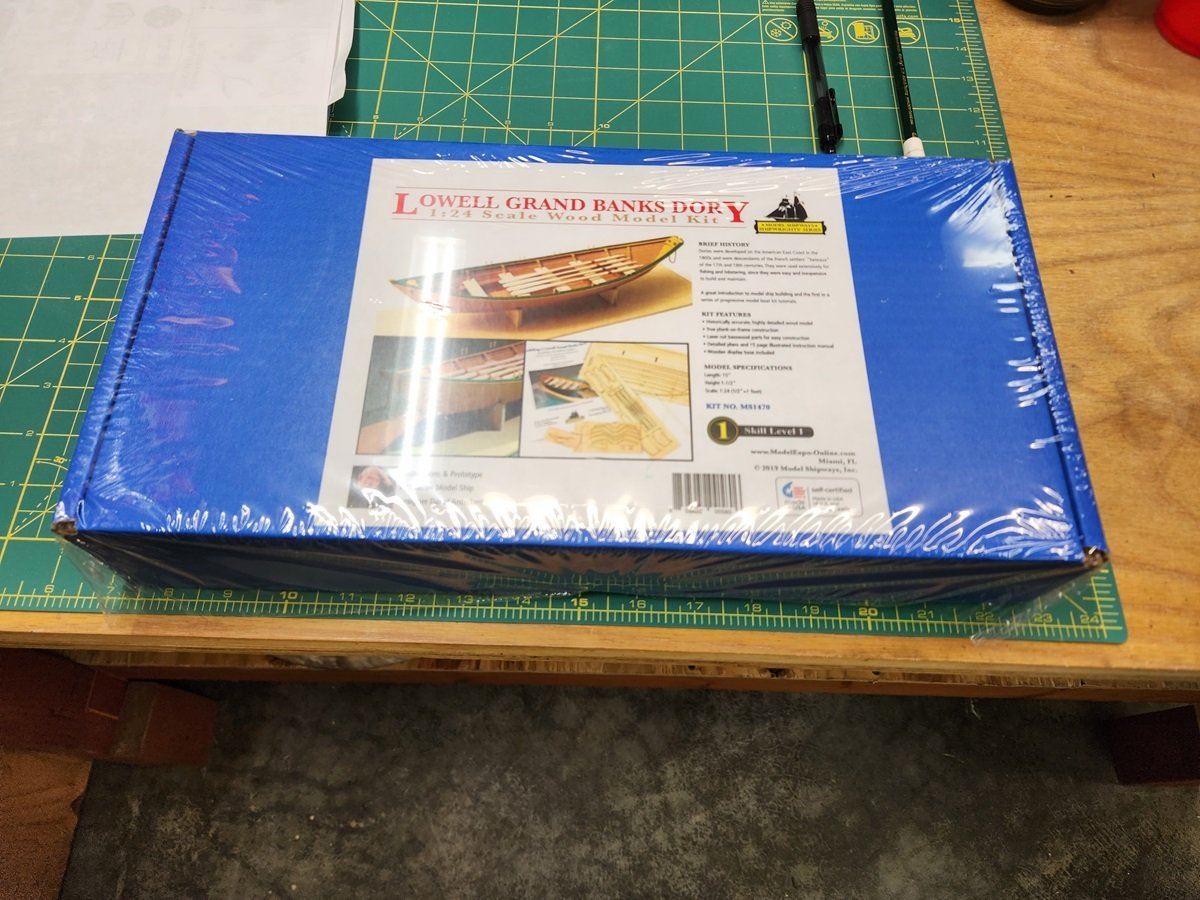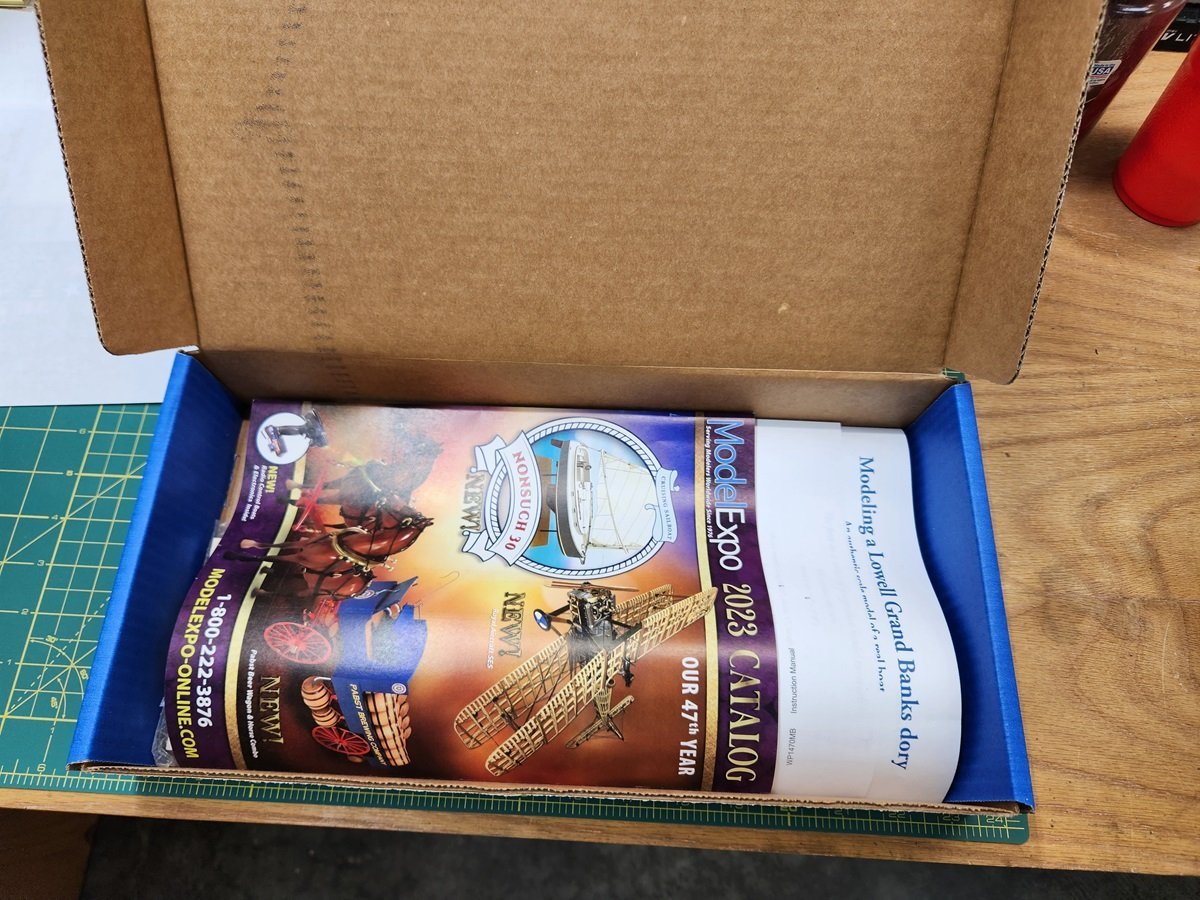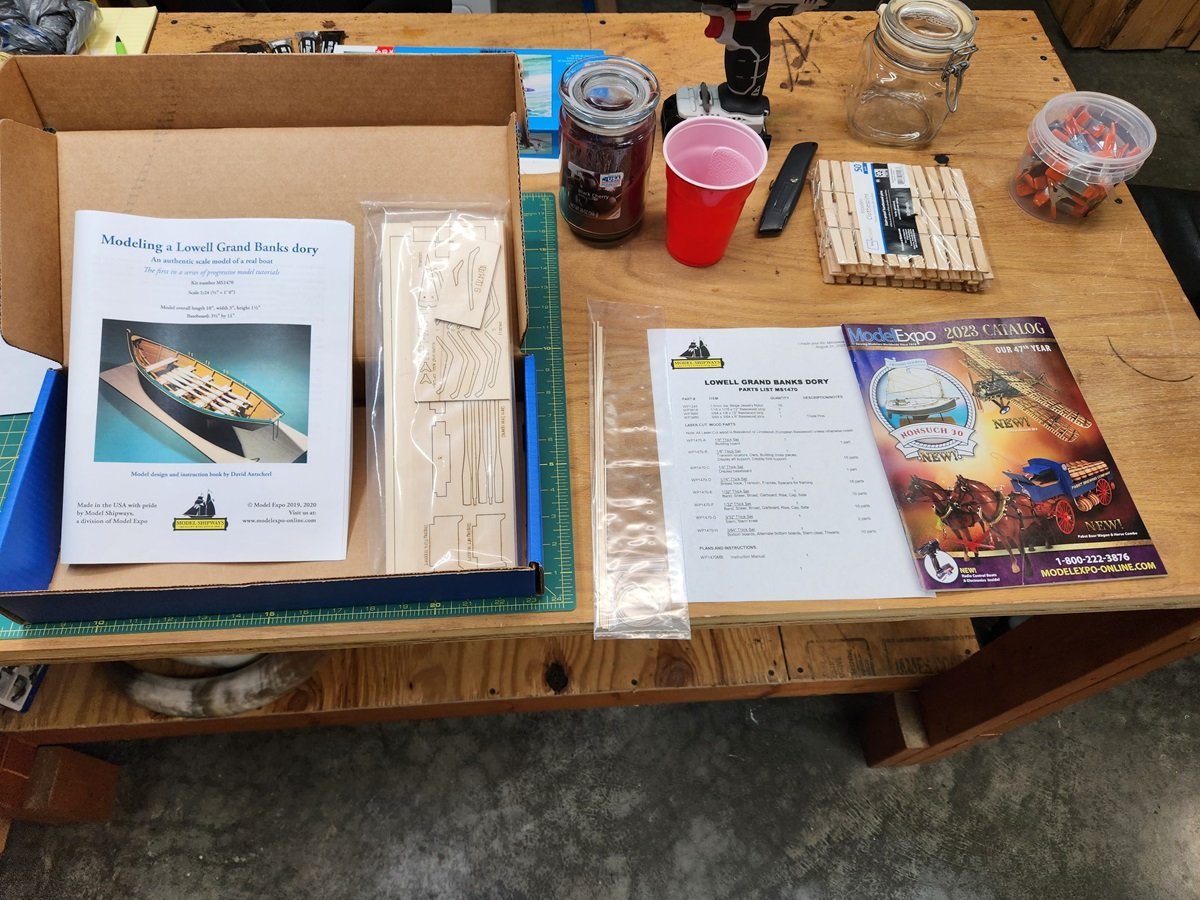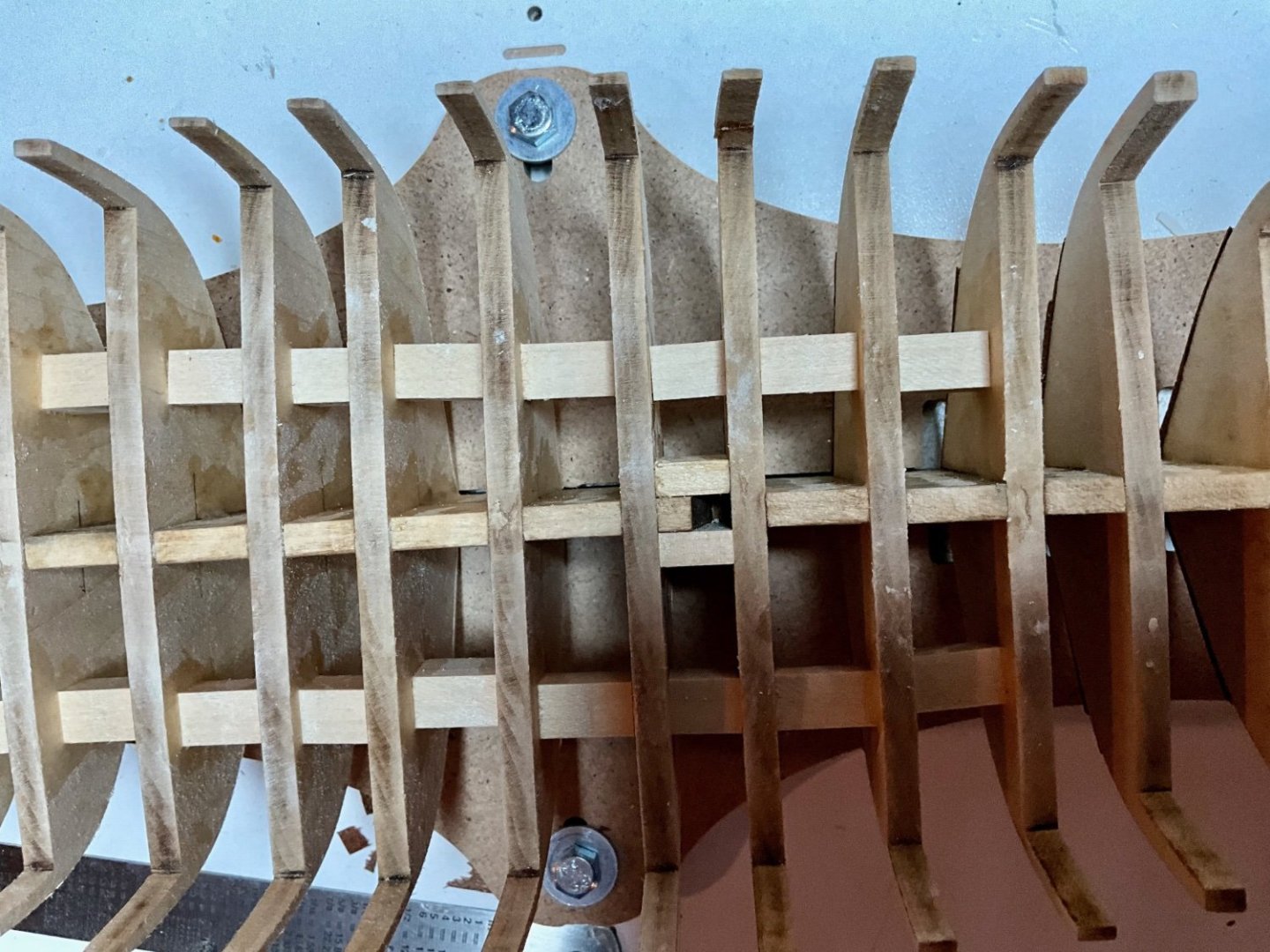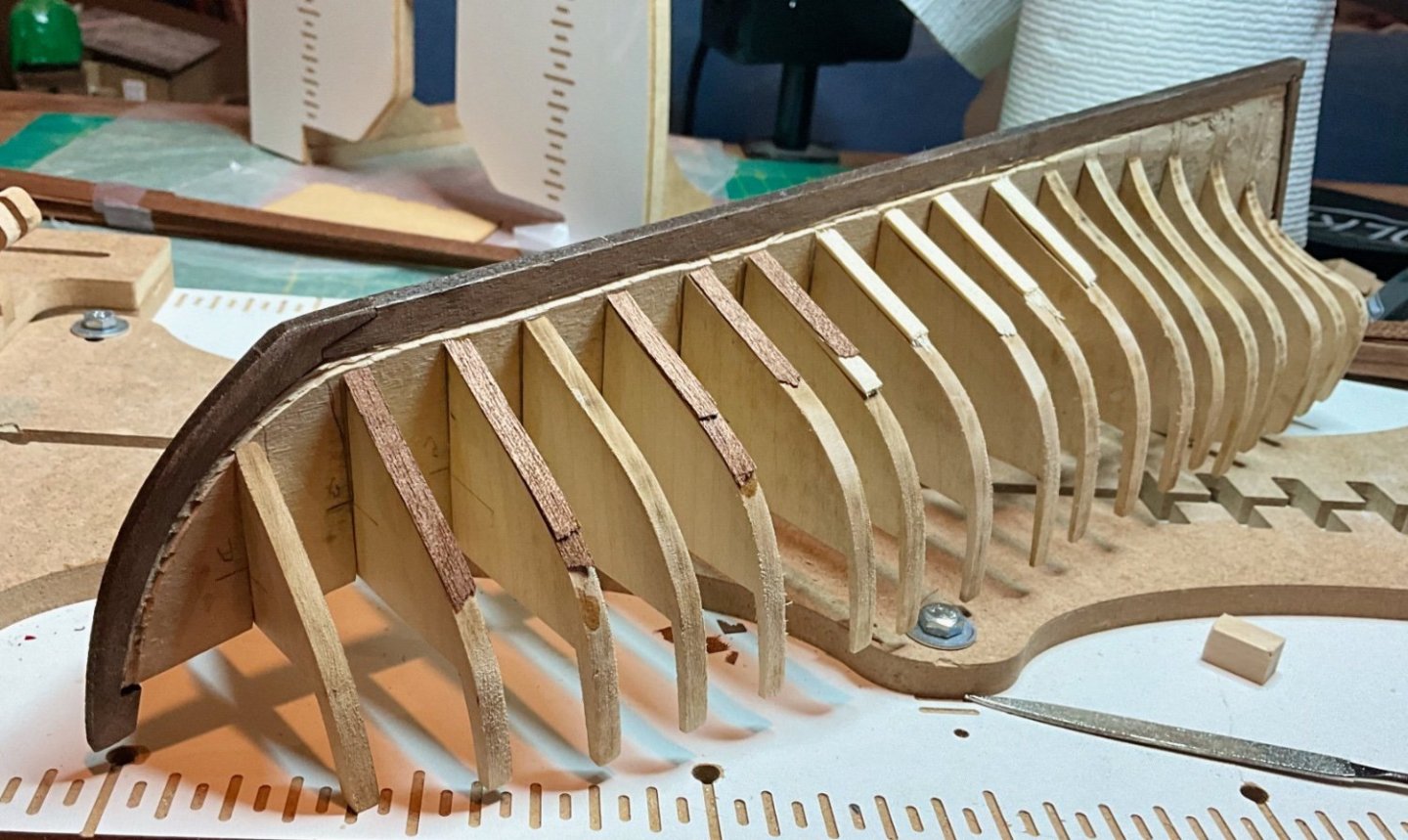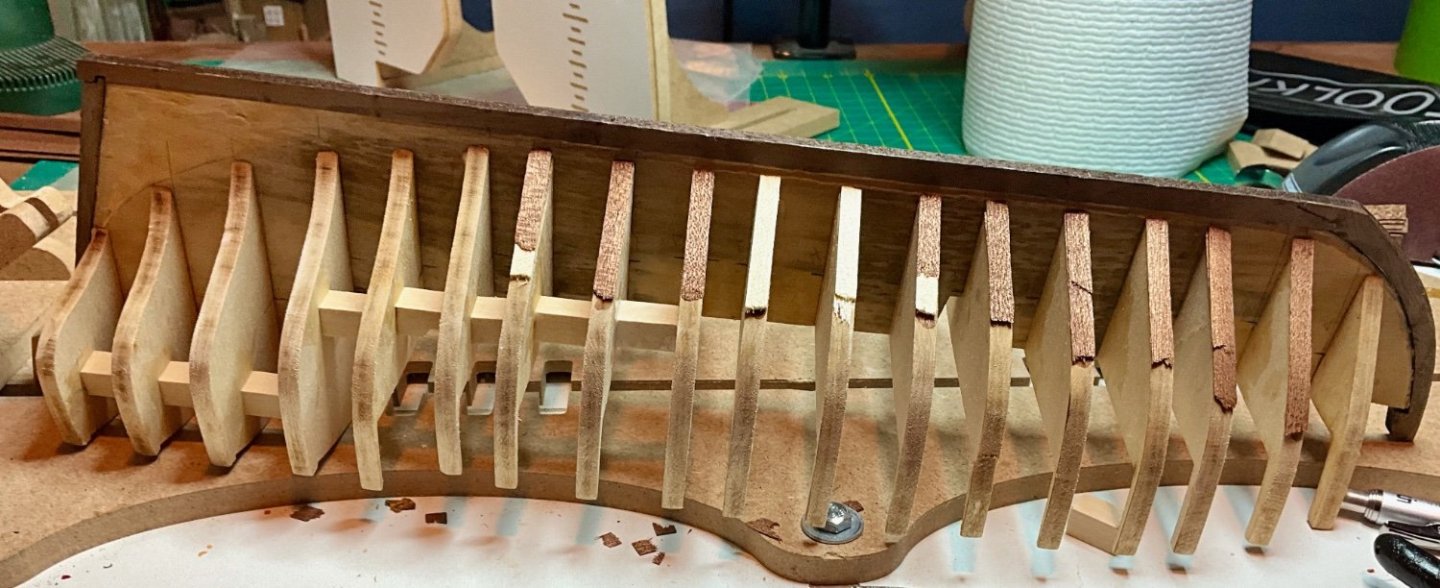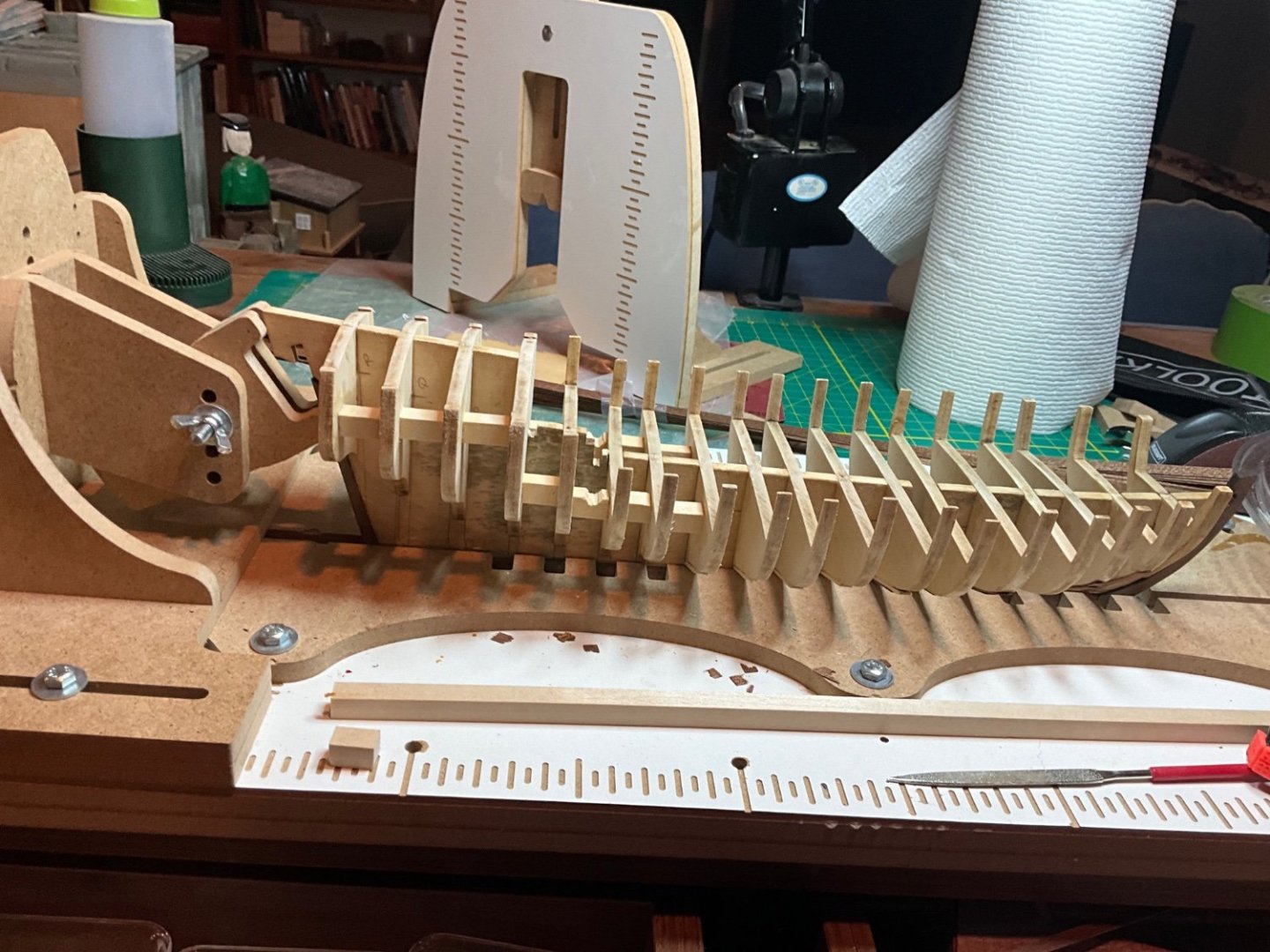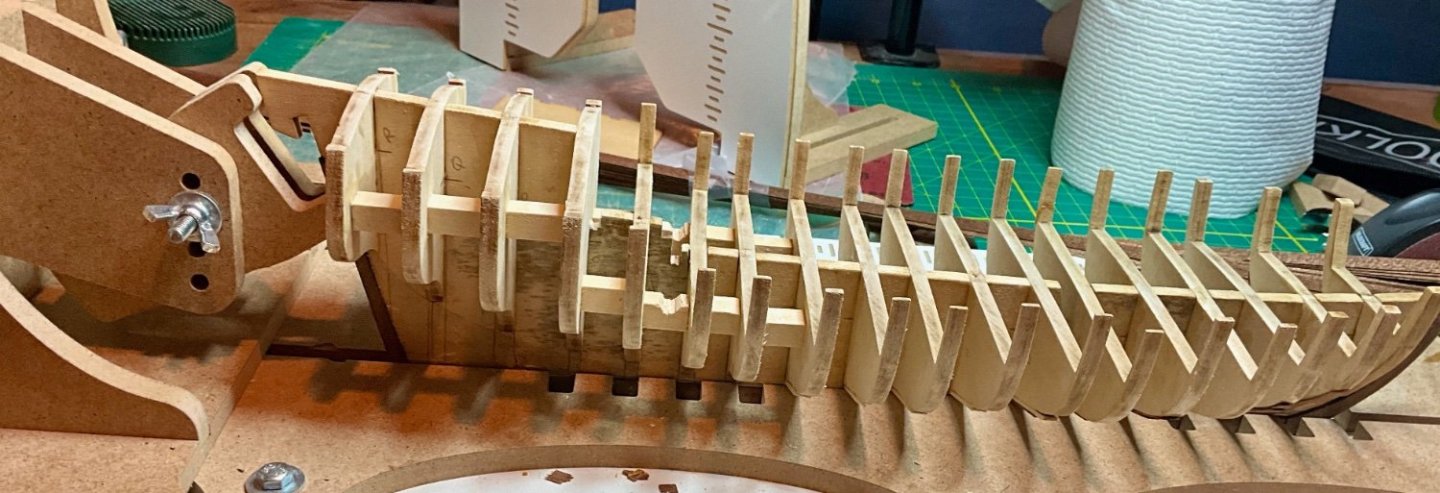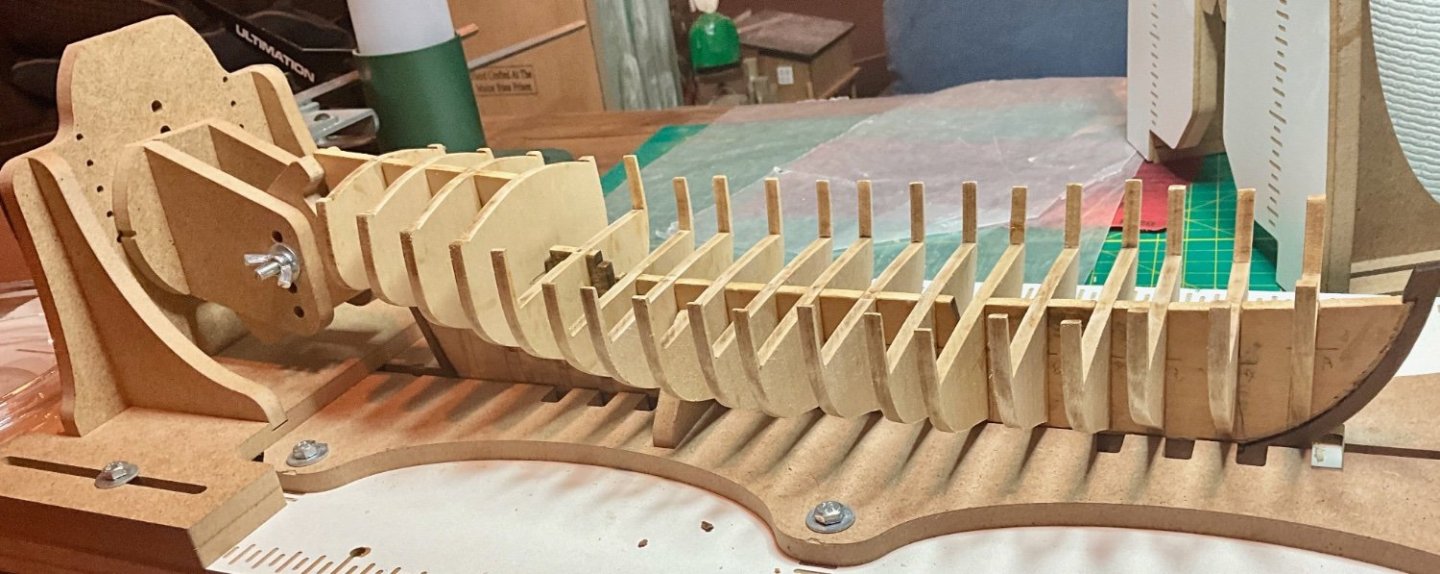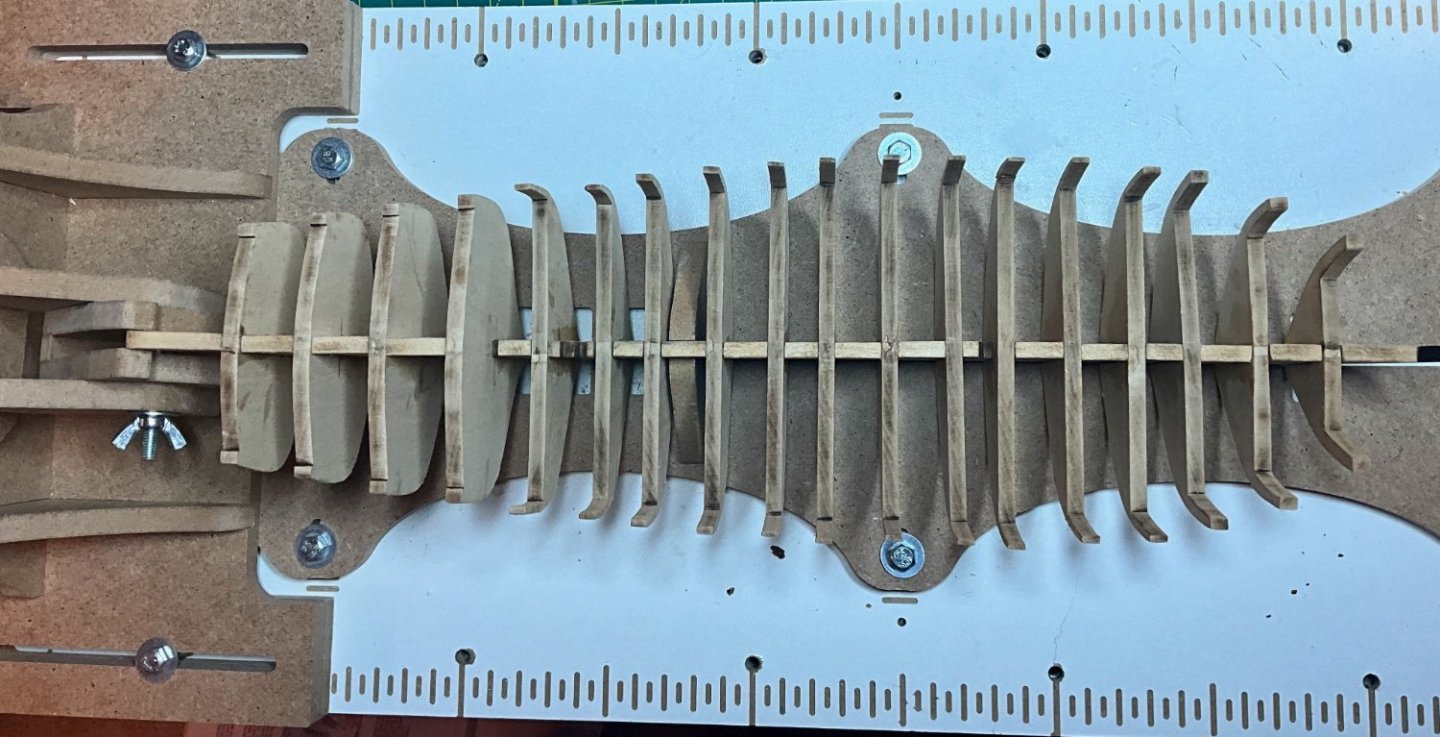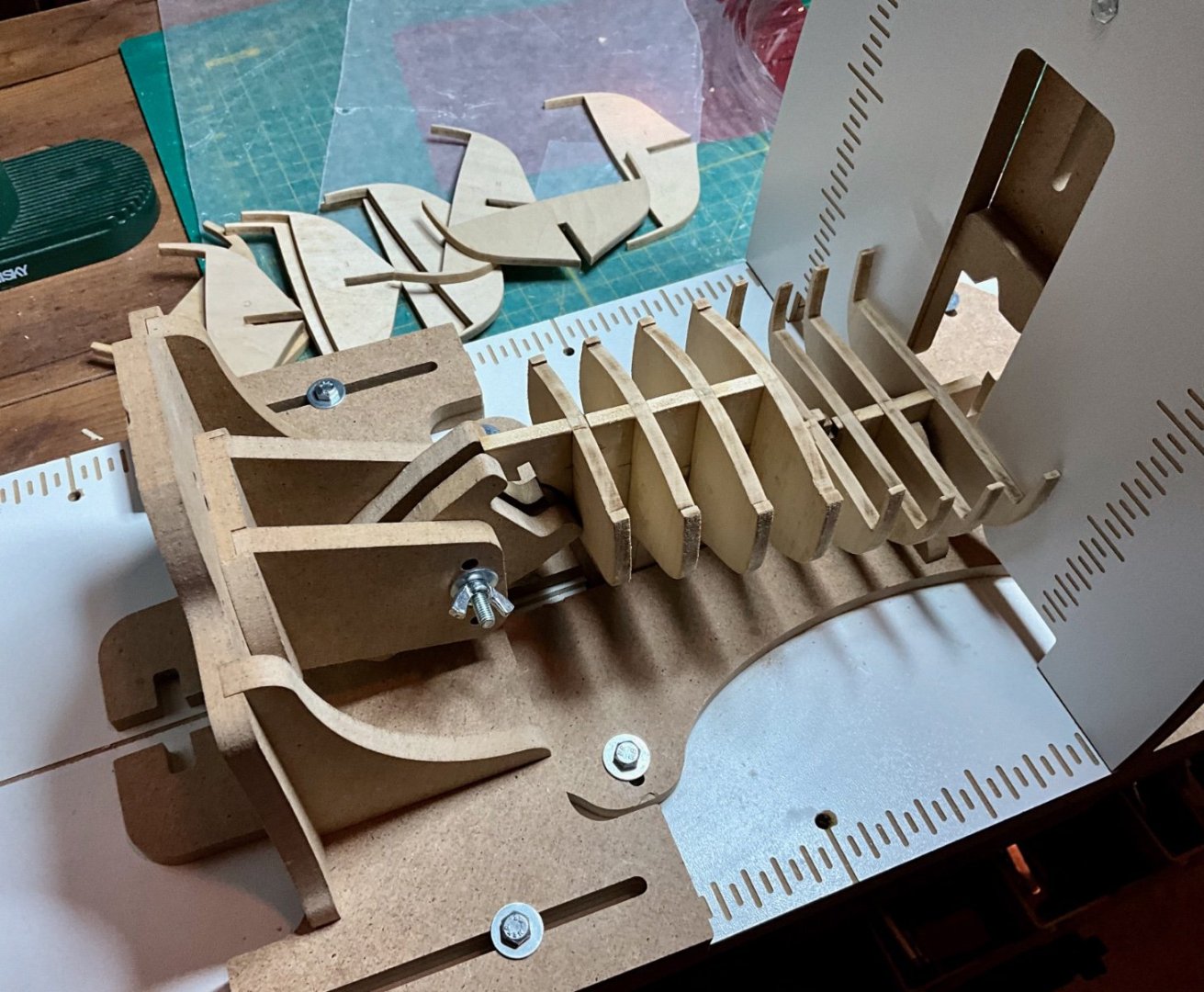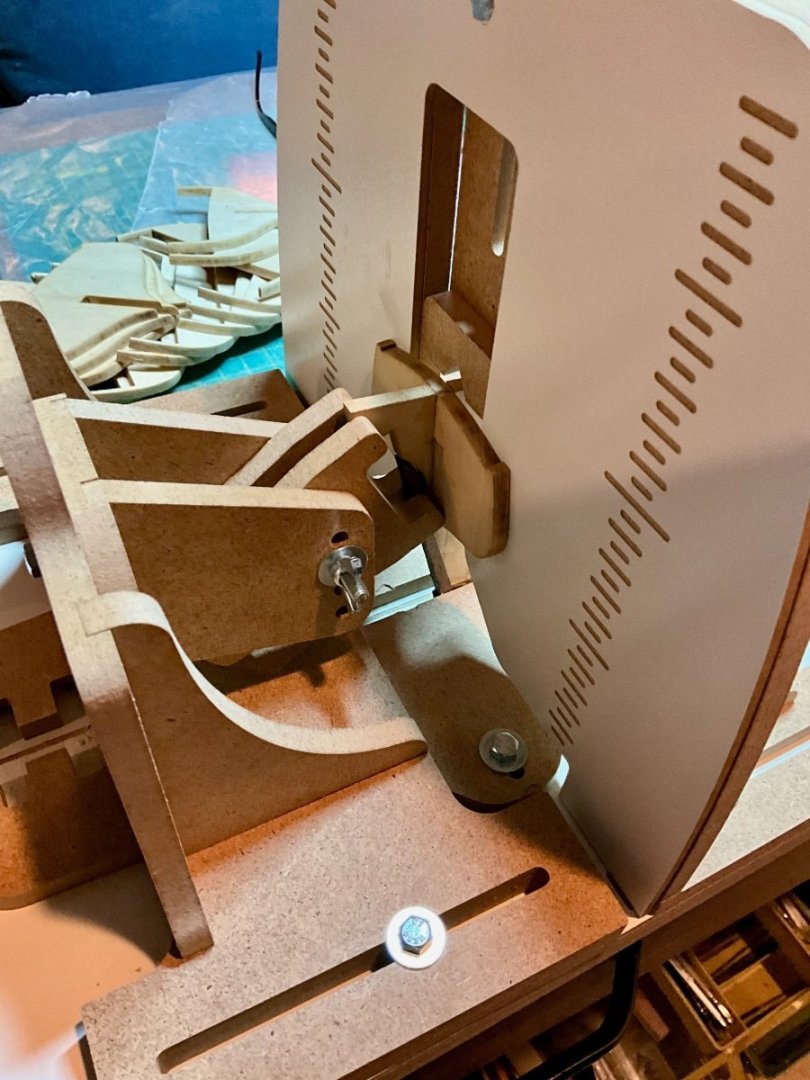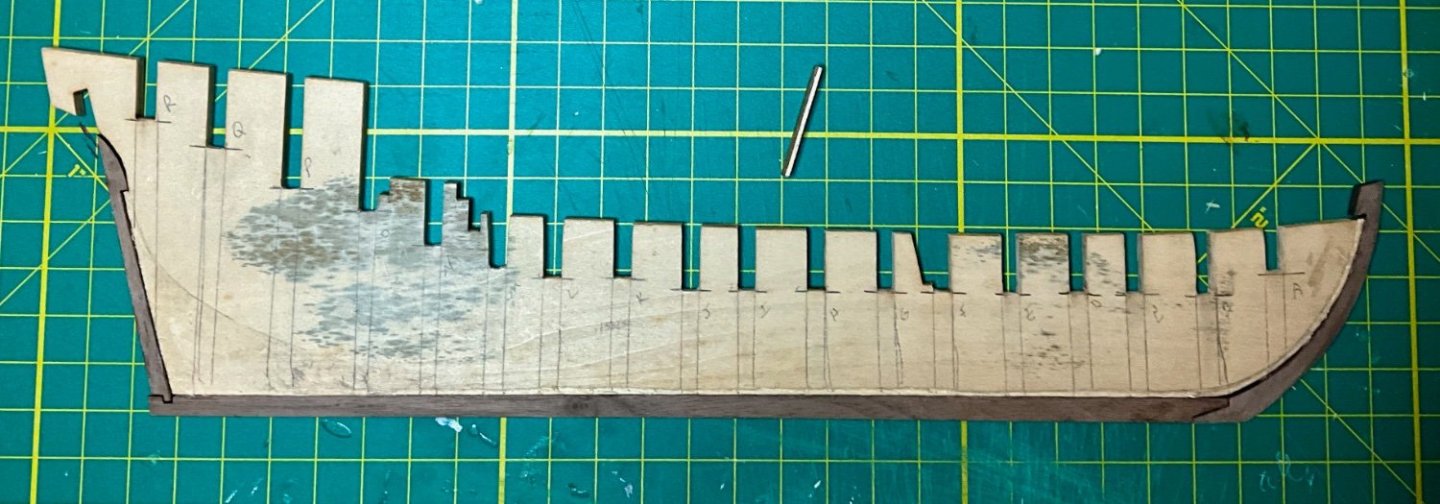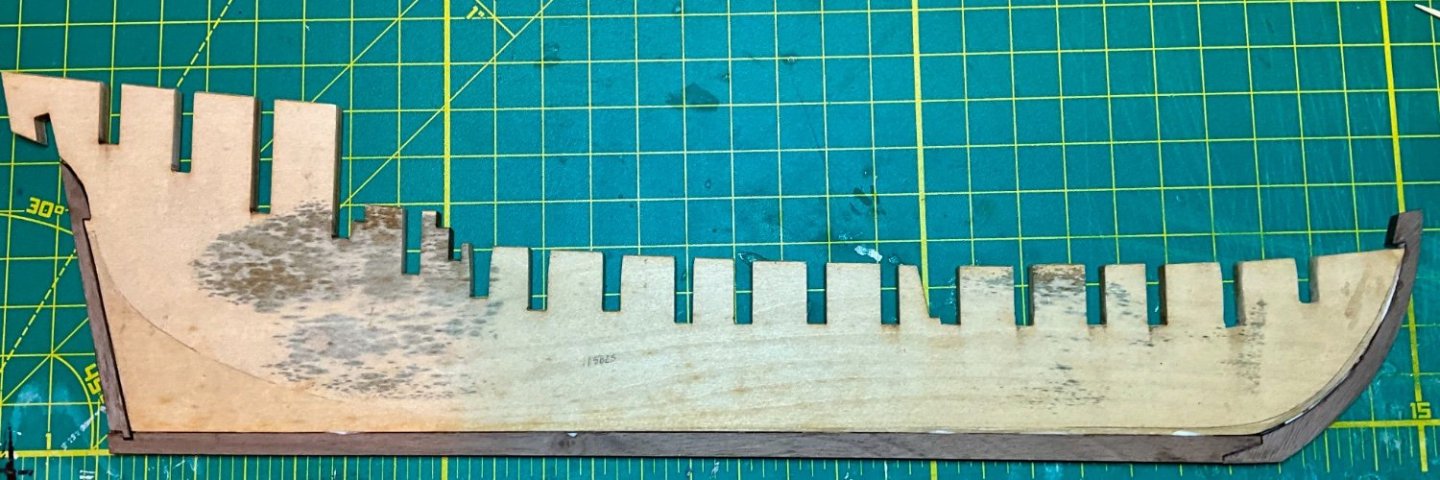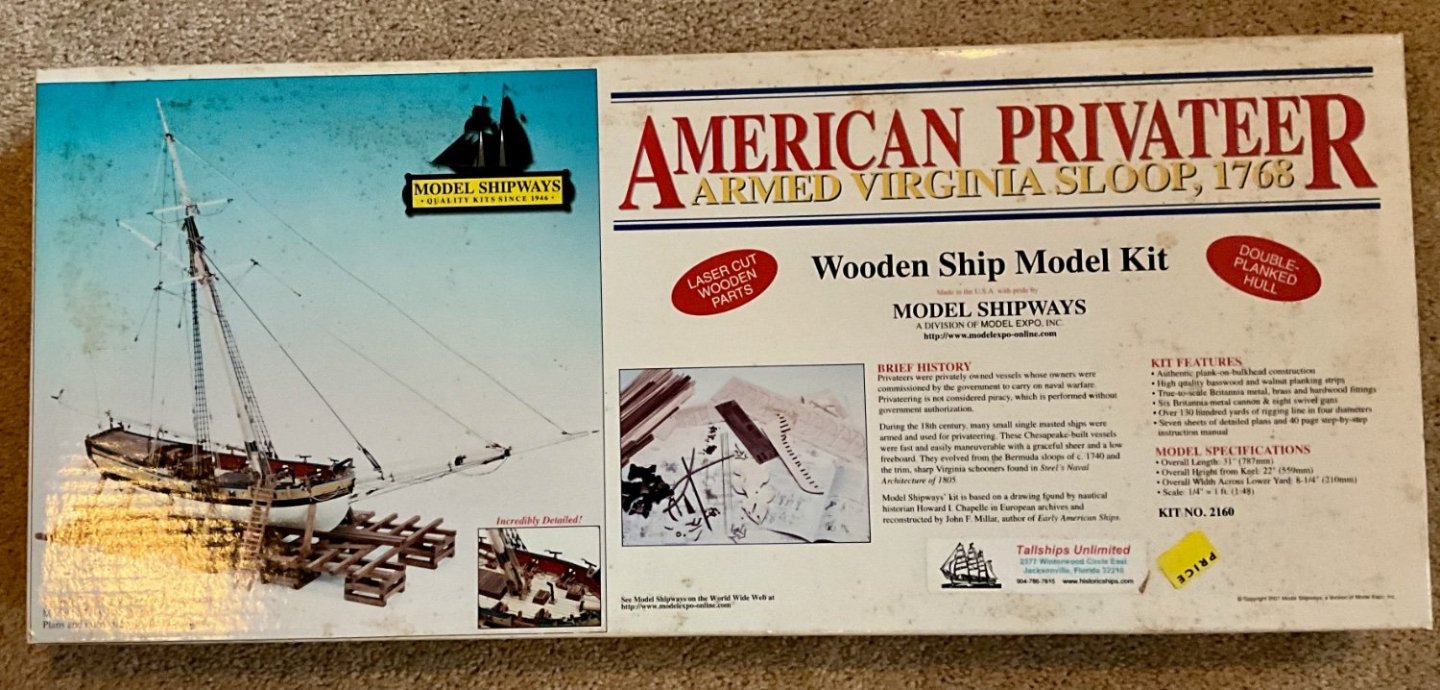Search the Community
Showing results for tags 'model shipways'.
-
I made a 3D printed hull before I started to glue the wooden keel and frames. I scanned the original plan and made 3D models to print the hull. Due to copyright reasons, I can't share my modelling files. I wanted to find a new way to enjoy the kit. I skip all the processes before rigging. I tried several different methods to build copied hulls. For example, I tried a 3D pen to draw hull planking. Unfortunately, it was boring and tough work. After several attempts, straight 3D modelling was the best answer. The small ship is 1/210 scale version. I'm going to build a wooden hull with the 3D printed hull for rigging together. The second hull for rigging will be my trial and error test bed for the main mission.
-
I started another project, the Model Shipways Grand Banks Dory. There are many build logs with kit pictures, so I won’t include here. I’m planning on replacing all the basswood anyways. I usually have two projects (wooden ship and plastic airplane) going, but for a bunch of reasons, thought I should try doing two ship models at the same time. Rationale: · I got a really good deal on it at a club auction · I’ve wanted to try one of David Antscherl’s kits · I think I have my jointer and bandsaw finally tuned right, and wanted to try milling some wood · I’ve found working with laser cut pieces on the longboat a little frustrating. I’m sure I will get better at it with some more practice, but wanted to get a sense of the comparison between cutting the parts out myself vs cleaning char off laser cut pieces. · I want to build with boxwood and some contrasting wood, and wanted to see how well patterns made from scanned laser cut sheets would work. This was particularly important on this model as the plans in the instruction book don’t include all the parts. · Main reason: I’m planning on starting a fully framed Echo, but want another project going so I don’t try working on Echo when tired or distracted. This seemed a good opportunity to pilot building two ship models at the same time. If it isn’t going to work for two fairly simple kits (longboat and Dory), I shouldn’t try it with Echo. So far, so good. I started with the stand as a test for the jointer and bandsaw. The wood is a piece of pao ferro that I had on my shelf. Very happy with both tools. The bandsaw got knocked out of alignment during the house move a few years ago, and is finally dialed back in. The jointer was never fully adjusted and is finally working the way it should. Scanning the basswood laser cut sheets has also worked well. The burn marks are thin enough and in the right place to get good patterns. For the first few pieces (hull bottom, stem, transom, stern knee) cutting the parts out has been very straightforward and taken less time than cleaning char. For some parts like the longboat frames this would not be true. I’ve also been making some progress on the other two projects and will update the logs soon.
- 5 replies
-
- Grand Banks Dory
- Model Shipways
-
(and 1 more)
Tagged with:
-
My first build! As exciting as it is intimidating. After staring at the box for a bit, getting over my nerves, I cracked my knuckles and cracked open the lid. Step one admittedly wasn’t photogenic—I made sure all the pieces were present, gave the full instructions a careful read, and then poured over multiple build logs. The next day, the real fun began. I opted to build the bottom from scratch rather than use the pre-made piece. This meant cutting, gluing, and sanding—so much sanding. I was skeptical at first, but low and behold, the instruction’s tip about moving the piece rather than the paper worked. Instead of a sanding stick, I opted to just tape some sandpaper flat to my working surface. A great decision for these long, straight pieces! Not so great for others. (More on that later.) Hoping to spare my fictional sailor a tumble into a sharp corner, I studiously over-sanded the edges of my cleats. The instructions spoke about removing edges to prevent injuries—but…what about the thole pins? They make sense to have, but I can’t help but think they’re a stab wound waiting to happen. A poor fate for a clumsy sailor… When sizing the cleats, I ignored the length of the burnt guidelines. Instead, I followed what other builders had done and made sure each one had some breathing room before the edge. After sanding and gluing the stem without incident, the transom gave me pause. I decided to go a little off-book, sanding it and the stern knee together before attaching the stern cleat. It seemed to me like a choice between vigorously sanding three freshly glued, breakable parts or two. (I opted for two.) I’m really proud of how it turned out! After adding glue to the transom and plopping the stern cleat on, I strung the two together with sewing pins. This let me squish the pieces together without fear of misalignment or gluing the holes shut. It also made it a million times easier to brush away excess glue. A simple strategy, but very effective. Should the edges of the stern cleat be softened as well, for our clumsy sailor? The instructions didn’t mention it so I refrained, but I feared once again for his poor noggin. After that, I was humbled. I spent far, far too long attaching the pieces to the bottom. I thought about it, researched it, did it, fussed with it so much the glue gave up, then had to do it all over again. I just couldn’t decide on the alignment. Should I follow the burnt template line, allowing a bunch of the stern knee to hang over the edge? Should I keep the point of the base and the outside of the transom lined up? Other build logs seemed to differ, and I couldn’t find many clear shots from the side to compare. I’ll upload pictures of mine. If it turns out I made a bad choice, others will know what not to do. If it works out—whew! One of the things I’ve enjoyed most about these dory build logs has been seeing what random things people scrounge up to use as weights. For mine, I made use of an egg cup my grandfather gave me. The whole kit and caboodle was set aside to dry, with a few other rejected weights keeping watch behind it. Onto the frames! I’ve seen many people comment on the template being the wrong size. I actually found it to be exactly 1:1—which makes me think I’m either lucky or doing something wrong. A few things I found helpful: I taped a sheet of parchment paper over the template to avoid gluing the paper. I numbered and labelled each left and right piece in pencil before cutting them free. This saved me almost immediately when I cut out and sanded a “2R” instead of a “3R”. It occurred to me I could have used this labelling as an opportunity to practice “port” and “starboard”. Then I realized I’d be adding additional challenges to an already daunting project. Left and right it was. A note to myself for next time: this worked great, but the pencil was difficult to erase before gluing. I’d write lighter next time. I prepped the frames one at a time but held off on gluing. The process: pick a number, label the two frame pieces, cut them out, sand them down with a scrap of sandpaper, then dry assemble it on the template. Once all of the frames were sitting primly in place, I could go through and glue them all at once. Since the glue dries so fast on my palette, I found this more economical (and it saved me some brush washing). I taped down the crosspieces. I’m so thankful I taped down the crosspieces! It meant I could easily lift the whole thing upward to clean the excess glue beneath, then settle everything right back into place. Free spacers were helpful to tap the freshly glued bottoms against, ensuring they were flat. This stage was when I really started feeling my lack of a sanding stick. I’ve got an old wrist injury, and it was starting to complain. So were my fingers, which had been slowly filed down alongside my pieces. Ah well. Funny how every tip I followed treated me well, and I regret skipping the one I didn’t. Almost like I should listen to the experts… After gluing up the frames, I checked the status of my now-dry boat bottom and found it lacking. Out came the water again, and a book was added to the weight mix. That’ll show it. I seriously debated continuing, but as I’d just spent half the day squished up at my table, a break seemed in order. I’ve got the itch now! But planking is intimidating. A problem for later…after my new sanding stick dries. 😄
- 9 replies
-
- Lowell Grand Banks Dory
- Model Shipways
-
(and 1 more)
Tagged with:
-
Bought this kit along with a set of plans from New Bedford Whaling Museum many years ago and finally decided to build it. I saw the kit listed in the first Model Shipways catalog I received in 1986 when I was considering the hobby. I decided on a starting with their KATY, 1/4" scale Virginia Pilot Boat. Since then, I have built several other kits along with my other hobby interests. However, completing the Kate Cory has always been one of my primary ship modeling goals. Unlike the Charles W. Morgan, there is not a great deal of historical documentation available regarding this specific ship. The New Bedford Whaling Museum, New Bedford, Ma. (USA) is the only resource I could find that offered credible documentation. This is where I obtained plans by Erik Ronnberg, Jr. which provide significantly more details and views then the kit plans. Additionally, I obtained copies of the Nautical Research Journals referenced in the Model Shipways Catalog regarding Coppering techniques, i.e., "Copper Sheathing of Whaleships", etc. I coppered two other kits using this technique and feel it provides a more realistic appearance. However, one could argue using this process without some weathering of the rest of the model is inconsistent. Despite all the research and obtaining all the documentation I could find, I still felt I needed a good visual representation of the ship. Finally, a key motivating factor for me to starting the project was the 1/4" scratch-built model by Thomas J. Lauria, (https://tjlauria.com/gallery/whaling-schooner-kate-cory/). Tom has many other excellent builds and has been helpful answering my questions. This will be a planked solid hull model. I've never built a plank on frame kit other than a small Dory. Then only other change from the kit is to swap out the solid wood whale boats for a set of updated laser cut boats.
-
In addition to my DH-9, I’ve also started the Model Shipways longboat. There are lots of other build logs with pictures of the kit parts, so I won’t repeat pictures here. I'm very appreciative of all the other great logs to use for reference. This build will be very heavily kit-bashed. I’m planning on replacing all of the basswood with boxwood. I’m very grateful to Chuck, who laser cut the frames for me. I was going to try to cut them on a scroll saw, but was worried that it wouldn't work as well as the laser for the partially cut inside each frame, which is important to hold everything together while fairing and planking. Chuck not only sent me laser cut frames, but also the other laser cut pieces. The kit includes 3/32 thick basswood frames, which are a little out of scale, but necessary as the basswood isn’t as forgiving as boxwood for fairing and clamping the planks. Chuck cut the frames on 1/16” boxwood, which is more to scale. I thought I would have to scratch the false keel with 1/16 instead of 3/32 slots, but even that had been adjusted for – tremendously impressive. I usually scratch build, so this was my first experience with laser cutting and removing char. The thread on char removal (char-removal-arrrghh) was really helpful. Scraping with an 11 blade followed by 320 grit sandpaper has worked pretty well for me. I’ve been using an abrasive cleaning stick so I don’t have to discard the sanding stick once it gets dirty with char, which has also worked pretty well. It is also taking some time to get used to adjusting the laser kerf to a right angle. Removing char and kerf without changing the part's size and shape has been a challenge. I thought I had screwed up taking too much off the stem when I saw it didn't line up with the keel. I saw Chuck’s comment in the other thread that he makes the parts oversize to allow for cleanup and checked the plans. The stem is the right size and I just need to sand down the keel to match. I’m having mixed feelings about laser cutting. It is great for complicated parts like the frames and the keelson with all the slots. I just made the filler pieces for the bow. It was much faster to cut them on the scroll saw than it would have been to clean the char. I’ll probably be selective about which laser cut pieces I use and which ones I replace moving forward. Keel and keelson are done and glued. I think I have the tapering right for the rabbet, and after a little filing, the frames all fit in the slots in the keelson. I'll start assembling the frames soon.
-
Let’s start with some background. I stumbled onto the Modelships Reddit a couple years ago while doom scrolling in the middle of the night trying to get my infant daughter to sleep. I became pretty fascinated by the intricacy of some of those builds but didn’t have the time to even think about getting started back then. A few months back I started toying with the idea of giving this a shot and ultimately couldn’t shake it. I don’t have any prior experience building models, but for someone with a desk job, I’m moderately handy and have done a fair amount of work on my house over the last 8 years. After some research and deal hunting, I ended up selecting this kit, along with some tools and supplies to get started. I was already pretty well into this build when I found my way to this site, so the rest of this post will primarily be a reflection on the first half of my first build, and I’ll try to transition to more of a true build log once I’m caught up. So far, my impression of the kit is that it is exactly as advertised. It’s very approachable for a beginner. The instructions are pretty clear and easy to follow, minus a step or two where the text got scrambled somehow. There are even some tips and contextual narratives mixed in for good measure. The first dozen or so steps were straight forward and probably don’t need to be rehashed here. The first real lesson for me came when I had to attach the knee to the transom. Despite the instructions calling for slow CA, I used quick CA as that was all I had on hand at the time. I proceeded to nearly glue my fingers together and ended up with quite a bit of excess, which you can see in the second photo. I now have slow CA as well. The other problem was that the transom ended up slightly off center, which led to a lot of sanding later on, though I managed to adjust for it. I was also slightly off center with 1 of the 8 frames, though now that I’ve gotten the side planks on, I don’t think it hurt me too much. Attaching the side planks to the frames ended up being not as bad as I thought it might be. At first I had some difficulty at the stem since it’s not easily clamped, but I managed to find a way to grip it and drip enough fast CA to get it secured while the slow CA set up. The rest of the side planks were affixed with white glue and clamped. Several rounds of sanding later brings me to the last two photos for this post. I’ve already made a bit of progress from when these were taken, so I should be ready for another post in a few days. Thanks for reading!
- 7 replies
-
- Skiff
- Midwest Products
-
(and 1 more)
Tagged with:
-
Started this build approximately six weeks ago, it's my first build log. As a volunteer at Mystic Seaport Museum, I regularly pass a Dory exhibit and I thought it would make an interesting subject for a Diorama. My original thought was to recreate the scene in the photo, the boat tied to the dock. However, my biggest concern was modelling the water. If I mess that up, the project fails! Another option I considered was to build a scene of a Dory on a Schooner. So, that's my plan. Decided the base would be a section of deck, the last Dory being prepared for launch from the L. A. Dunton Gloucester Fishing Schooner, circa 1923 (currently undergoing full restoration at Mystic Seaport Museum) for daily fishing. The Dunton carried 10 Dory's stacked five high, port and starboard. She had a crew of 24, Captain, 3 crew, and 20 fisherman (2 per Dory). Dories could carry several tubs of longline trawl that would be set away from the schooner. Each tub could carry as much as 1,800 feet of line with a hook every fathom, or six feet. If a commercially viable fish was found on 50 of those three hundred hooks it was considered a decent haul. Dory's were painted a buff color which would show up in the fog and in bright sunlight, the same color the spars on the mother ship would carry and the dory might have a small rope on the bung, should the boat overturn. There's lots of small detail that can be added, line tubs, dory fog horn, trawl anchor, trawl buoy, bailer's, sail, etc... Fortunately, I found some 1/24 scale figures I think I can modify. To start with, build the Dory! The Kit is the Model Shipways Lowell Banks Dory, "a beginner kit is not just for beginners"! No need to document the build, there are many Dory Build logs. So, fast forward, after few minor kit modifications, base painting, I started the weathering is a work in process in process. I mixed my own batch of base colors using enamel paints. For washes I use "only" watercolor paints". Not acrylic paints. Watercolor paints are much more forgiving, if you make a mistake, just wipe off with a damp cloth or paint brush. I never weathered a ship model; I'm having fun with this! Some dark grey wash, dry brushing and paint chipping, the detail starts to develop.
- 11 replies
-
- Model Shipways
- Finished
-
(and 2 more)
Tagged with:
-
Any tips on smoothing out the hard angles along the garboard and second plank along the port side? Starboard side faired well and has a pleasing curve from stem to stern. These were caused from the planking jig and I didn't notice until I took the hull off and started to sand. I did prebend all the planks and they fit without force prior to glueing so I really don't know why this happened.
-
Having just finished the Lowell Grand Banks Dory, I find myself not yet ready to begin a model of the schooner I'm meaning to build in my garage. And so I reached for the second of the two kits I bought in April 2020 before a bunch of other weird stuff happened, the Willie L Bennett Chesapeake Bay Skipjack. It was quite a contrast opening this kit compared to the little dory model! I'd been advised that this was a good beginner kit when I first looked into this, and I must have even read a build log or two on it before deciding it was a good choice, but if so I had forgotten that I would be greeted with more or less a pile of lumber upon opening the box. It was a little intimidating and I considered putting the whole thing back away since it seems like a lot to get into when I have other projects coming along. Then I got started anyways. I found a 1/4" plywood cutoff just a bit larger than the size shown in the plan, left over from when I built my kitchen cabinets. It was a little bowed, so I fastened a cutoff bit of 5/8" OSB to the bottom and that flattened it right out. I pricked holes through the mold plan into the plywood and connected the dots instead of cutting out that part of the plan and gluing it down, then set the mold up using the cutouts as bracing. I moved on to the keelson tonight. After gluing the three pieces together and sanding it smooth - the laser cutouts weren't quite square, giving it a sawtooth sort of look on end - I sanded an initial bevel into the outer 1/8" strip on each side. I clamped down a straight edge to scribe a cut line, then figured out I could use the straight edge as a guide for an emery board to sand in the rabbet. The keelson sits a bit oddy in the molds, with the forward end sitting quite proud of the notches and the after end recessing in to the point that it will have to be lifted up to fasten the bottom. The next step is going to be some careful measurements and seeing if I need to modify the mold at all.
- 2 replies
-
- Willie L Bennett
- Model Shipways
-
(and 1 more)
Tagged with:
-
While waiting for the HMS Speedwell project from Syren Ship Model Company I am building some smaller models to "fill in the spaces" in some of the cabinetry where the larger models will not fit.
- 87 replies
-
- Muscongus Bay Lobster Smack
- Finished
-
(and 1 more)
Tagged with:
-
My next build will be the the Model Shipways Mayflower 1620, MS2020. To be a little pedantic, this is really a model of the Mayflower II replica of 1956, based on research of William Baker and the best knowledge of what Mayflower of 1620 might have looked like. The replica ship was sailed from the UK to the US in 1957 where it was gifted to us and exists today as a floating museum. It has recently been undergoing a new restoration, where the color scheme has changed from the original Baker scheme as depicted on the box cover shown below. At some point I will need to decide if I want the designed scheme or to follow the changes of its current incarnation. This is not a terribly complex kit, parts wise. There are 4 sheets of plywood parts for the framing, and 4 others of assorted parts, plus the usual strips, dowels and other bits. I will make just a few observations of the contents quality here. Firstly, the keelson piece (bulkhead former) was quite warped. As this forms the whole basis of hull alignment, that was a disappointment. Got to get this bit straight or else you end up with a banana boat! More on this later. Also the cutting on the plywood could be better. Several parts were not cut all the way through, so there was some work to do to finish the cuts. The plywood in my kit was quite "splintery" at the edges and tended to get a good bit of delamination when cutting or sanding. That's going to present some challenges while fairing. One thing I tend to fuss about is Britannia metal parts and how badly they tend to be made. I was pleasantly surprised in this kit because as these things go (low expectations, I know) , these are not too bad. Even the crows nests might be usable, though there is a good chance I might want to scratch build new ones when I get there. The blocks and "rope" provided are typical MS fare, which is to say not very good. I will be making an order to Syren to get proper materials.
-
I’ve never made a build log, mostly because I usually have no idea what I’m doing and am still a beginner at this. However, I’ve learned almost everything I know from build logs on this forum, so maybe it’s my turn to contribute and I will (belatedly) start one on my ECB build. It’s about 70% complete, but I’ll post the pictures I took during construction here (and then hopefully keep it updated until complete). First, some photos I took of the real thing when I visited Mystic a couple of years ago. It’s an incredible place. (Not sure why some of those are upside down)
-
I received this kit as a Christmas gift from my brother in 2007. That is not a typo; 2007. I wanted to finish the Rattlesnake, then I started my Coastal Pirate and all kinds of life stuff has gone by. I'm finally to the point where I'm comfortable doing this build. Thank goodness it's been patient. The instruction book mentions that a few years of her long life was spent as a yacht - that's what I'm going for. The fish well will be converted to cabin space for this build. This is my first plank-on-frame model and I really like the building jig included in the kit. I built a local skiff years ago with no jig or anything and it's shaped something like a banana. Basic start of the keel assembly: The pencil marks will be erased/sanded. The building jig: As per the instructions, the frame locations were lifted from the plans and transferred through the keel to the jig and board. It took a little while to put everything together, but time well spent up front will result in a more precise build with fewer problems. The board is a piece of straight, square, pre-primed and sealed 1 X 12. I drew the center line and marked the location for the keel support and each frame along the line. Before I glued the keel support, I used a T square and marked each frame. I built the frame clamp bar fixture and marked the lines for the strip runners on the board. I made sure it moved smoothly but stayed firm along the whole route, then nailed it down. All of this is outlined in the instruction manual - which has to be read and reread over and over. Now that everything is set in place, it all lines up just right; it's level, plumb and square. Next, I will cut the bevels in the frames. Comments Welcome, especially from other Berrys - Kenneth
-
Howdy folks. I made an introduction topic in early 2020, bought a couple starter kits and tools, and then a bunch of weird stuff happened which brought about my never even opening the shipping box. Now as the weird series of events continues relentlessly toward no clear destination, I've arrived at a point where it makes sense to build some model boats. The short version leading to this point involves: Originally living in my vehicle on the Appalachian Trail, and perceiving some time and a need for some hobby to keep me busy in early 2020 while I was living alone in one of the trail maintenance facilities Having to get out of there after it was condemned and deciding it was time to actually try settling down in Maine as I'd long wanted to do Acquiring vacant land which used to be a farm in Midcoast Maine, converting a shed into a cabin, and building a timber frame house Deciding I'd like to get into sailing, falling in with sailors and boatbuilders, and winding up with full-size wooden boats about the place, including an actual Grand Banks dory which my housemate (one of the aforementioned boatbuilders) brought along Deciding I'm really very interested in building a weird 25'6" Phil Bolger-designed schooner, the William D Jochems, and ordering plans Although I have built a house I still work all over the Appalachian Trail, and having a sailboat that I can trailer without great difficulty, use as a camper during the work week, and easily launch and rig in the nearest handy body of water on the weekends seems pretty snazzy Deciding to build a model of that before building it full-sized, and finally Deciding to build the model boats I already have before building a 1:16 scale William D Jochems before building a full-sized schooner in my garage So there's the short version leading up to today, when I made space on the old table on sawhorses that has floated around the house serving in numerous capacities. It was previously sitting against a wall where I'm going to start building a big buffet cabinet for the dining room part of the large open "great room" space. I cut the packing tape, opened up the Lowell Grand Banks Dory box, and took inventory of its contents plus the other tools and stuff I'd ordered so long ago. That's as far as I got tonight, that and the logging back in here, writing this, and hoping it may be of some entertainment. Cheers, Shepherd
- 11 replies
-
- Lowell Grand Banks Dory
- Model Shipways
-
(and 1 more)
Tagged with:
-
Welcome to my USS Constitution build log. This is my second wooden ship model. I completed the Artesania Latina 1808 Swift model a little over a year ago (which just reminded me to close out that build log). My first attempt was going to be this USS Constitution (1:76 MS2040) kit. Fortunately it was backordered (Christmas gift from my pop), because after previewing the somewhat limited pages of instructions available online - I realized that the build would need to be based almost entirely on the 8 or so architect style giant plan sheets. That was out of my league, so I thought it prudent to start with something a bit easier. I chose the Swift 1805. Having completed the Swift, I took some months to complete a "Mayberry Street Miniatures" doll house project with my daughter. And then it was time to begin the Constitution. To set the stage, I am an extremely novice woodworker. I had gotten in a bit over my head with my Swift project (especially the rigging), but was quickly able to work my way out of any problems with a lot of thought, creativity, and help from the great modelers on this site. For me, this hobby is a series of challenges to be solved, often requiring the learning of a new skill - and new tools 🙂. This build log will be of most interest to newer modelers, but may offer a few chuckles or familiar memories for the old(er) salts. Given the complexity of the model, the sparse instructive guide, and the 8 detailed build sheets, I chose to follow Bob Hunt's practicum (fancy term for instructions). I ordered Mr Hunt's "Sophomore Course: USF Constitution" (a CD with 12 Chapters), with a photo CD add on (about 1,000 pictures of all stages of the build). The practicum was exactly what I needed, unfortunately, it didn't contain anything pertaining to masting and rigging. So if you think you'll need help with anything above the deck, you should consider ordering Mr. Hunt's "Sophomore Course: USF Constitution, Masting & Rigging" (6 chapters and an additional photo CD). I've printed the first 3 chapters so that I'm able to look ahead. I also refer often to the sheet plans, as well as the supplied kit guide. The kit itself is chock full of goodies. Though I'm a bit surprised at how small some of the cannons and rigging parts are - they seem to be significantly below scale. I inventoried the entire kit for parts, but found the effort to be surprisingly helpful in familiarizing myself with nautical terminology. I'm not going to provide a run-through of the kit, but suffice it to say, I found it worth the money (even though it was a gift!). There are very few things you can buy today that will provide years of challenge, entertainment, and a beautiful result for under $600 (retirement is a long ways off, so I'm working on this after work, and between sports and school events). I'll be updating as time permits, which means my updates will usually be backfilling my progress. I look forward to any comments and suggestions! Cheers! Andre
-
Good day! This build log will cover the second wooden model ship I am tackling, after the Drakkar Amati. Unlike the Drakkar I decided to do a build log of this. Why the Niagara - two reasons: My wife is from Erie PA where the reconstructed Niagara can be found, and thought that this should be my next build - who am I to disagree especially as she purchased the kit! I like the lines of the ship and it is simpler than other multi deck models out there Pictures of in progress build to follow - I have been working on it for a few weeks now making steady progress as work and other things allow - happy for all comments/suggestions Stuart
-
Better late than never, I guess; but here is my build log for the USF Confederacy. There are many like it, but this one is mine, lol. I started this build over 5 year ago. Then it got put on hold in Jan of 2018 due to my retirement from active duty Air Force, move from Texas to Georgia and starting a new job. Before I knew it, 5 years have past and I was looking at the MDF box the model was placed into for the move on the shelf in my closet. I decided to pull it down and open up the box. Then I decided it was time to start work on it again. I don't have any pictures of my progress up to this point, but I have a pictures of the current state of the build. I am currently in the process of fairing the sweep ports.
-
I received my second wood kit recently… I almost put it on the shelf to work on after I finish my Armed Longboat, but I decided to crack it open and get started. I figure if I get tired of one boat I can switch to the other one and do something completely different… I started with the stand on my other build, so I figured I would continue that trend and put the stand together for this one… I decided to dress the stand up a bit with some mystery wood from what was advertised as a Constructo Mayflower kit on Facebook marketplace but turned out to be a bunch of bits and pieces from at least two different kits, mostly wood and assorted fittings… (definitely not as advertised, but also definitely worth what they were asking for it).
-
Greetings! Having completed my first build last month, the MS Grand Banks Dory from the introductory Shipwright Series, I said I was going to practice on another model before moving up in skill level. I am excited that MS/ME has acquired and began reproducing many Midwest kits of the past, as they appear to be perfect for beginners like myself. I chose this Skiff kit with the goal of improving my basic skills, and building on lessons & mistakes I made on the previous model. I've also done some research on the older Midwest kits, so I will try to point out some differences on this Model Shipways rerelease as I notice them. I would skip over the box, but as I haven't seen any build logs for this MS produced Skiff I'll take a moment to show it. First major difference with the box is the picture of the model has an entirely new paint scheme compared to the old Midwest colors. I think the deep blue is attractive and will plan to follow this paint job when the time comes. The box does appear to have a hybrid branding - the old Midwest logo is featured, but also clearly has MS branding added as well. As a result I've titled this build as an MS-Midwest build to help clarify that this is a rerelease version. From the box description and learning about skiffs for this build, later 19th century seems like an appropriate era for this build log. The side of the box has MS '22 trademarks, but interestingly it keeps the original Midwest kit number of 967. When doing some research of the old Midwest produced kits they made two different scales for the Skiff - kit #947: a 1:6 scale model advertised as a "Yacht Skiff." And kit #967: simply titled "The Skiff" in 1:12 scale. As of right now only this single Skiff model appears on the ME/MS website, which is this 1:12 model. Opening the box the contents appeared as expected - same standard as MS laser cut wood. As shown in the picture - one of the side planks was already free but thankfully no damage. Everything appeared to be in order, however the instruction manual had some strange printing errors. I won't go into detail out of respect for ME/MS, as they replied within hours of my email and sent a new instruction manual right away, and said they would check other kits. Starting off with the bottom plank - markings needed to be measured and penciled in. In contrast to the Dory I just built that had guide markings, having to make simple markings like this made me feel more engaged in the build. I then installed the stem, knee, and transom. I took time to make sure everything was square, perhaps more so then my last build, and definitely used less glue as I learned from last time to gauge how much is needed. Next I'll finish getting the cleats ready, and attach the frames in the coming days. So far I'm enjoying the rereleased kit and think it is a great complement to the Dory build.
- 3 replies
-
- Model Shipways
- skiff
-
(and 1 more)
Tagged with:
-
Gjoa was used by Roald Amundsen to traverse the North West Passage from 1903 to 1906. She was built in 1872 and used as a herring fisher until Amundsen purchased her in 1901. This kit is an old Model Shipways “yellow box” kit that I purchased on eBay several years ago. These kits have minimal instructions and just a few parts: a machine shaped solid hull, some blocks for deck houses that are never the right size, dowels for masts and yards, and a bag of metal fittings. I worked on the kit off and on over the last several years but failed to take any photos. Once I finished the paper model of the liner United States I decided to attack the Gjoa seriously. Attached are a few photos showing the construction of the cap rails and the pin rails. For the cap rails I traced the out line of the bulwarks onto a piece of sheet wood, widened the line to the cap rail width, leaving plenty of extra wood. The rough rails were then glued in place and shaped to fit. The pin rails were done similarly with lots of test fitting with final shaping after they were glued in place. In the photo the port side pin rail has just been glued .
- 27 replies
-
- Gjoa
- Model Shipways
-
(and 1 more)
Tagged with:
-
This is my third model after completing the Dory and the Sailing Pram. I started out by checking the inventory. I found a couple discrepancies on the two inventory sheets with wood thickness and laser cut sheet labels. After inspecting the sheets and checking the instructions I think they are typos on the inventory rather than errors on the actual parts. I cannot tell of the copper wire bundle is both the 24 guage and 18 guage, but I will deal with that when I get to those steps.
- 61 replies
-
- Muscongus Bay Lobster Smack
- Model Shipways
-
(and 1 more)
Tagged with:
-
Gentlemen I'm not getting any younger so here we go. I have had my eye on the little whaling boat for a while now...but ran into this the other night here on the forum. After taking a closer look I decided it was the place to start for me. I know it's simple but I love the lines of this little boat, and for the $$ it was a no brainer. It came in yesterday. I had time this afternoon to do an initial unboxing. It was well packaged, no damage, and came with a parts list with a date the kit was made....signed by Miroslava. I like that, When I saw one of the build logs here of the kit I did some googling to see what I could find out about the subject matter. That's what peaked my interest and firmed up my decision. I'm sure all of you guys are aware but here is the link. I'll be posting progress. Thanks for looking. History | Lowell's Boat Shop & Museum (lowellsboatshop.com)
- 3 replies
-
- Lowell Grand Banks Dory
- Model Shipways
-
(and 1 more)
Tagged with:
-
I purchased this kit several years ago but quickly realized it was too advanced for me at the time. Now that I have several completed ships under my belt I have decided to tackle it at this time. I will be basically following Robert Hunt's practicum with some modifications based upon reviews of of other completed builds on this site. I marked out the bearding line on the center keel and then cut the rabbet joint, attached the keel, stem, and sternpost. I then further refined the rabbet joint and began attaching the bulkheads. Since this is a double planked model I created a short test piece combining the planks of the two layers of wood to check the depth and width of rabbet. Some bulkheads fell short of the bearding line so I used some leftover wood from my stash to shim up the bulkheads where needed to meet the bearding line and rabbet. I am adding reinforcement blocks between the bulkheads and at the mast slot.
About us
Modelshipworld - Advancing Ship Modeling through Research
SSL Secured
Your security is important for us so this Website is SSL-Secured
NRG Mailing Address
Nautical Research Guild
237 South Lincoln Street
Westmont IL, 60559-1917
Model Ship World ® and the MSW logo are Registered Trademarks, and belong to the Nautical Research Guild (United States Patent and Trademark Office: No. 6,929,264 & No. 6,929,274, registered Dec. 20, 2022)
Helpful Links
About the NRG
If you enjoy building ship models that are historically accurate as well as beautiful, then The Nautical Research Guild (NRG) is just right for you.
The Guild is a non-profit educational organization whose mission is to “Advance Ship Modeling Through Research”. We provide support to our members in their efforts to raise the quality of their model ships.
The Nautical Research Guild has published our world-renowned quarterly magazine, The Nautical Research Journal, since 1955. The pages of the Journal are full of articles by accomplished ship modelers who show you how they create those exquisite details on their models, and by maritime historians who show you the correct details to build. The Journal is available in both print and digital editions. Go to the NRG web site (www.thenrg.org) to download a complimentary digital copy of the Journal. The NRG also publishes plan sets, books and compilations of back issues of the Journal and the former Ships in Scale and Model Ship Builder magazines.

